

26 Beautiful Places to Visit in Uganda: Nature, Culture, Wildlife
Looking for the best places to visit in Uganda ? In this huge guide, you’ll learn about 26 of the most beautiful and most interesting attractions in Uganda.
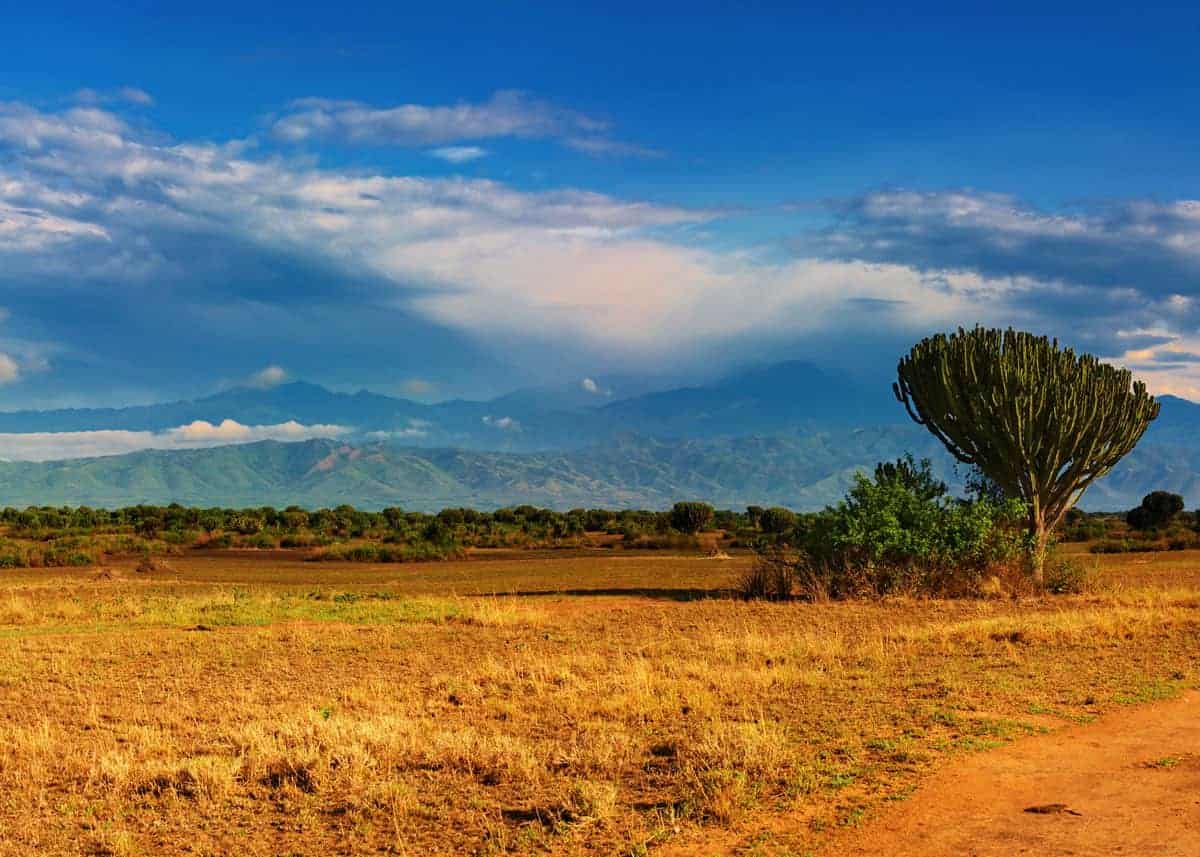
Often called the “Pearl of Africa,” Uganda is a country jam-packed with breathtaking scenery, natural wonders, exotic wildlife and fascinating culture. Learn more with these 22 facts about Uganda .
26 Beautiful Places to Visit in Uganda
If you are traveling to Uganda for the first time, you may be hard-pressed to decide which places are best to explore. To settle your dilemma, we have compiled a list of the most beautiful places to visit in Uganda.
1. Murchison Falls
Whether you visit by boat cruise on the Victoria Nile or a safari tour, you don’t want to miss Murchison Falls in northwest Uganda.
Here, you can witness enormous waters bursting through a narrow gorge before crashing in powerful, roaring cascades.
While you are visiting this breathtaking sight, you may also want to explore the surrounding protected area that makes up Murchison Falls Conservative Area to spot some of Africa’s icons such as African lions , elephants , leopards , giraffes , buffalo and more.
Looking to stay in the Murchison Falls region? Here are some accommodation options .
Check out our Guide to Murchison Falls: 16 Things to Know
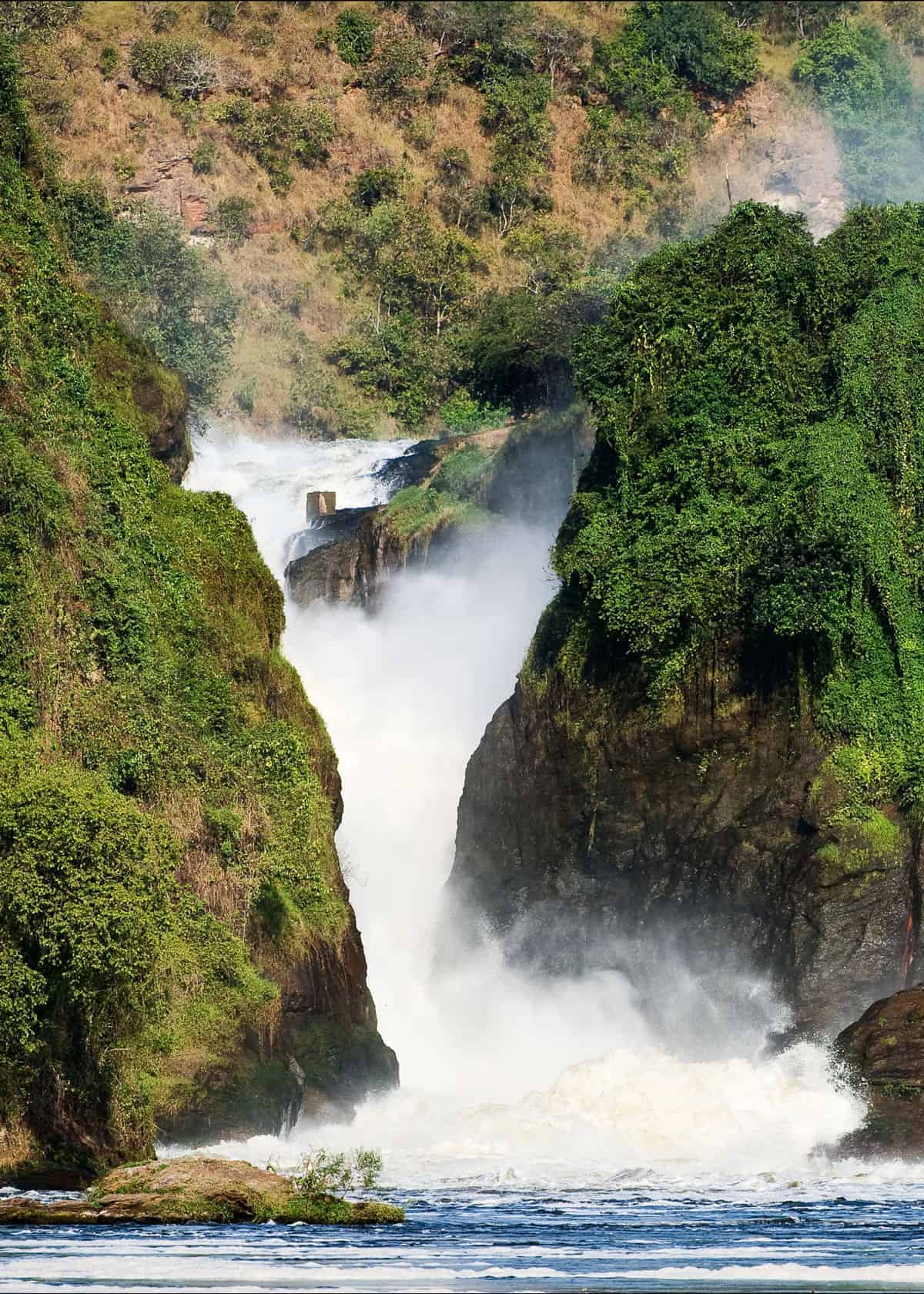
Check out our Travelers Guide to Uganda’s 10 National Parks (and 4 Wildlife Game Reserves)
2. Lake Victoria
If you really want to experience the heart of Uganda, the story begins with Lake Victoria , which is the birthplace of the Nile River.
Not only is it Africa’s largest lake and the world’s largest tropical lake, but Lake Victoria also boasts one of the world’s largest ecosystems.
There is so much natural beauty and wildlife to see here – from scenic mountain views to islands, beaches, fishing boats, and various bird and animal species.
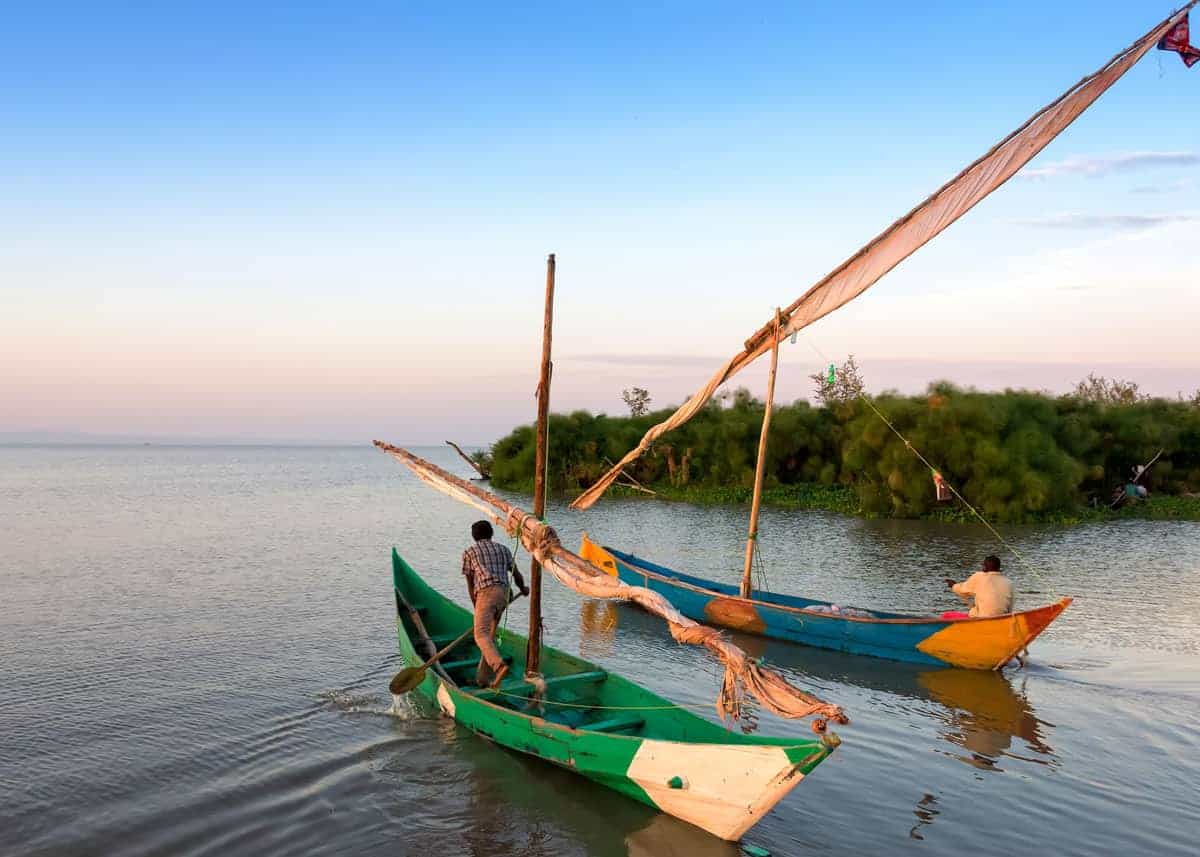
More reading: How to Choose the Best Portable Water Filter
3. Jinja, Start of the Nile River
While you are touring Lake Victoria, you may want to check out Jinja, the colonial town that is positioned at the start of the Nile River.
Here are some hotel options in Jinja, Uganda .
The town is regarded as East Africa’s adrenaline capital, so not only can you view where the world’s longest and most historic river begins, but you can also get your blood pumping with activities like whitewater rafting, mountain-biking, quad-biking, and kayaking.
4. Ssese Islands
A major tourist attraction in Uganda, the Ssese Islands are a group of about 84 islands dotted along the northwestern shores of Lake Victoria. Each island differs in size, shape, and exotic flora and fauna.
Here, you can relax amid beautiful scenery, see chimpanzees, walk on white-sand beaches, enjoy horseback riding and windsurfing, as well as interact with the Bantu people and learn about their culture.
5. Kampala, Capital of Uganda
When visiting places in Uganda, you don’t want to miss checking out the country’s capital city, Kampala. This city is home to a steady expat community and offers plenty of things to see and do .
You can tour beautiful temples, cathedrals, art galleries and museums that include the popular Uganda National Museum. You can also browse various markets for clothing, foods, and crafts.
Kampala also offers a good range of restaurants and bars.
Check out our Uganda Food Guide (16 Must-Try Dishes for Your Visit)
6. Kasubi Tombs
While in Kampala, a visit to the Kasubi Tombs is well worth your time. A palace consisting of 35 buildings, this important historic site is the burial place of four former Ugandan kings and other royal family members.
A tour allows you to see interesting artifacts and learn about the rituals and traditions of Uganda’s largest tribal kingdom, the Buganda Kingdom.
7. Ndere Centre
Also in Kampala, the Ndere Centre is a great place to experience the colorful dance and music that is traditional to Uganda.
Opened Sunday, Wednesday and Friday evenings, the Centre offers a 700-seat amphitheater where you can enjoy dinner along with a spectacular performance of colorful, high-energy dancing and music that displays the lively culture of the Ugandan tribes.
8. Owino Market
One of the largest markets in the region, the Owino Market is a must-do experience when visiting Uganda.
Located in the capital city, Kampala, this busy market is full of color and character from its wide array of produce, clothing, electronics, and crafts to its lively vendors and customers.
More reading: Is Uganda Safe? Guide to Water, Crime, Disease, Sun
9. Bwindi Impenetrable National Park
Breathtaking mountain views, lush landscapes and an abundance of African wildlife are just a few reasons Bwindi Impenetrable National Park is one of the top places to visit in Uganda. Moreover, it is home to some of the world’s last mountain gorillas .
There are many gorilla trekking tours you can join here to suit your level of skill or preference that will allow you to experience the sheer beauty of this place and to see mountain gorillas up close in their natural habitat.
Find a lodge in Bwindi Impenetrable National Park region.
10. Queen Elizabeth National Park
Queen Elizabeth National Park is like a sample platter of Africa. You can try a little of everything African here with diverse habitats and exotic wildlife.
Wetlands, forests and savanna grasslands offer ample opportunities to see the likes of elephants, leopards, hippos , chimpanzees, giraffes, and the tree-climbing lion. There are various safaris, lake cruises, and even hot air balloon tours available here for you to explore this amazing area.
Here’s your Complete African Safari Packing List
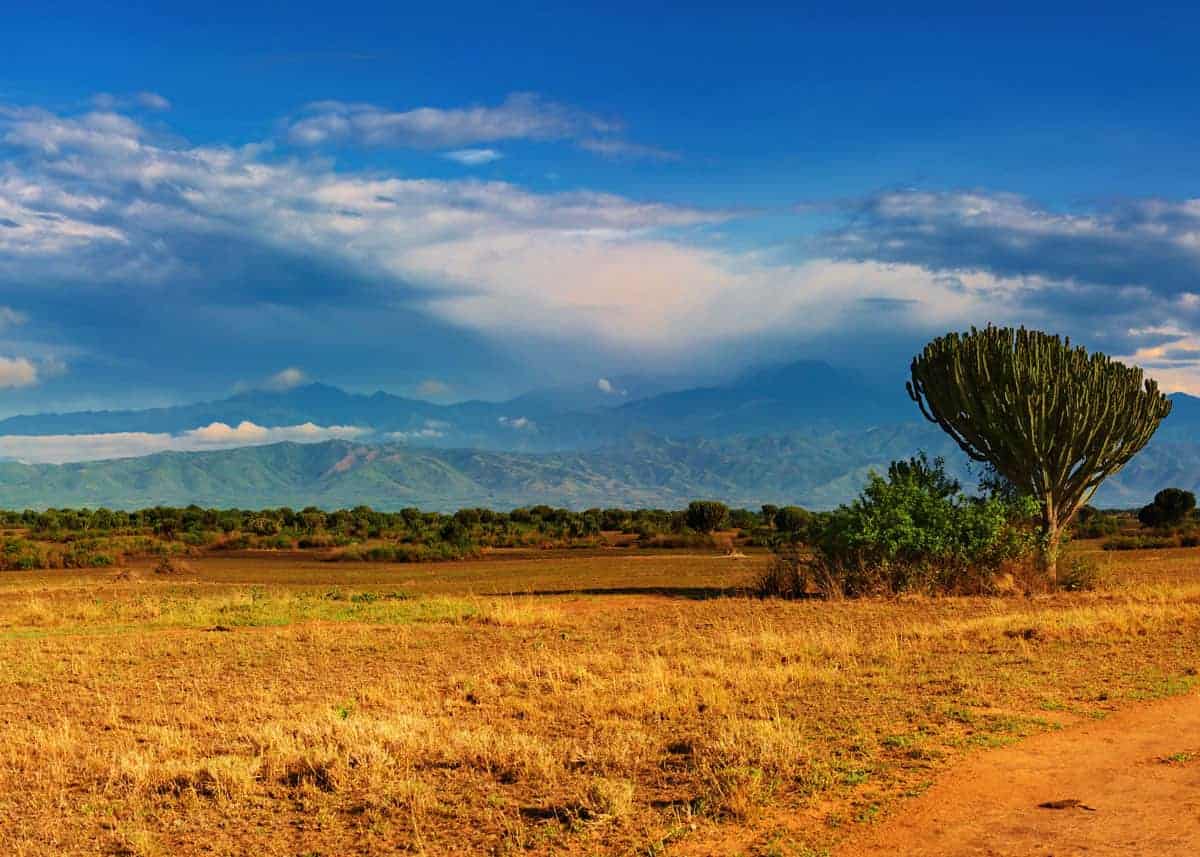
Learn more: Uganda Currency: 12 Things to Know
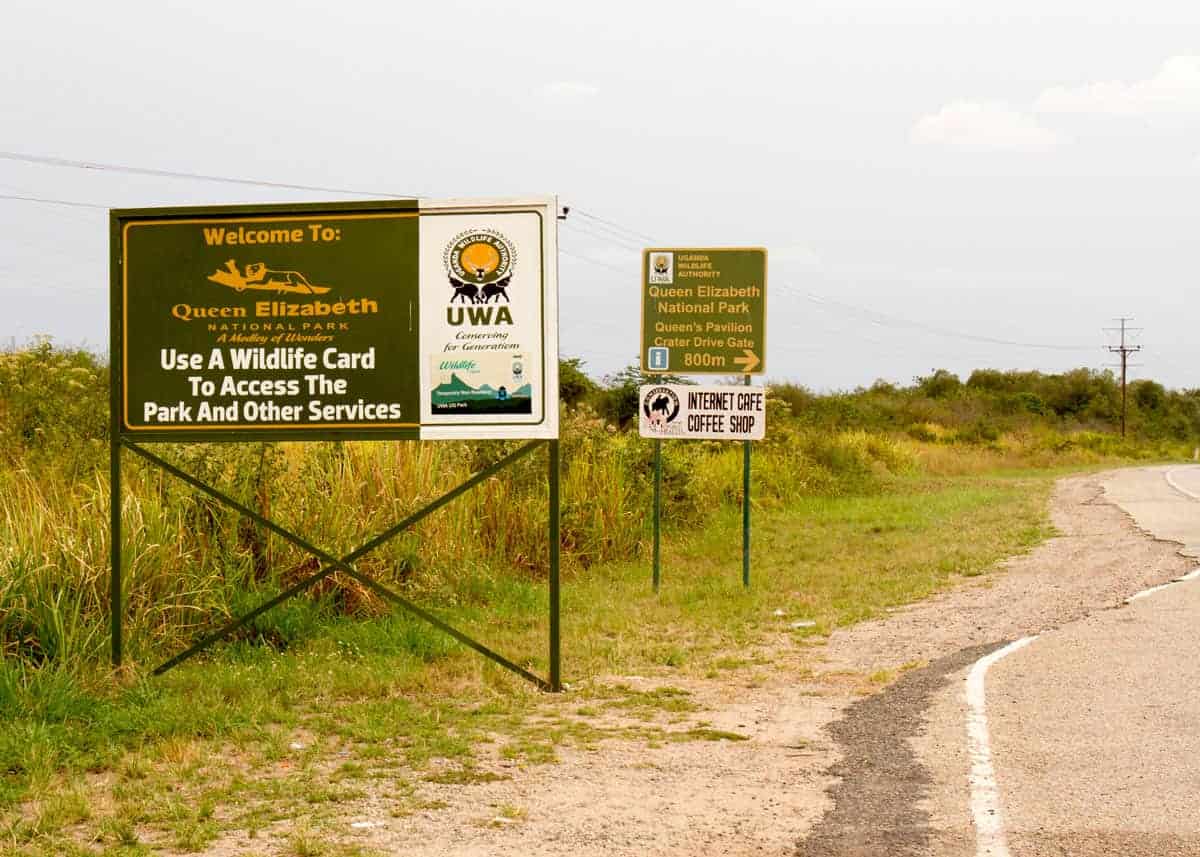
Don’t forget about the equatorial sun! Here’s how to choose the best sun protection hat for Africa .
11. Lake Katwe Explosion Crater Drive
If already in Queen Elizabeth National Park, you should consider reserving space on your itinerary for one of Uganda’s most scenic drives, the Explosion Crater Drive.
It takes about 2 ½ hours, but it is well worth the time. Not only will you have the chance to see wildlife like buffalo and elephants, but also magnificent views of natural landmarks like Mountains of the Moon, Crater Lake, the Blue Mountains of the Congo, and Lake Edward.
12. Kazinga Channel
Taking a boat cruise on the scenic Kazinga Channel is another way to see amazing wildlife and gorgeous scenery if you are in Uganda’s Queen Elizabeth National Park.
With the boat hugging the banks of the channel, you may see African Cape buffalo , hippos, Nile crocodiles , elephants, and numerous bird species.
13. Mgahinga Gorilla National Park
Although there is only one family of gorillas living here, the Mgahinga Gorilla National Park offers great trekking tours for you to experience striking vistas of the Virunga Mountains, bamboo forests, volcanoes, and the endangered golden monkey .
14. Lake Mutanda
Found nearby the Mgahinga Gorilla National Park in the African Great Lakes region, Lake Mutanda is one of Uganda’s jewels. Surrounded by the Virunga Mountains and dotted with lush islands, this lake is a beauty to behold.
A visit here offers wildlife sightings, birdwatching, canoeing, fishing, hiking, biking and trekking with the Batwa People, the native people of the nearby forest.
More reading: Is Hippo Milk Really Pink?
15. Ziwa Rhino Sanctuary
Located north of Kampala in Nakasongola, this sanctuary is home to Uganda’s only population of wild rhinos, but that is not all it offers.
Scenic nature walks, canoe cruises, and guided trekking tours award you with sights of hippos, crocodiles, large antelopes , and more than 250 different bird species.
Learn more about the white rhino (northern and southern) .
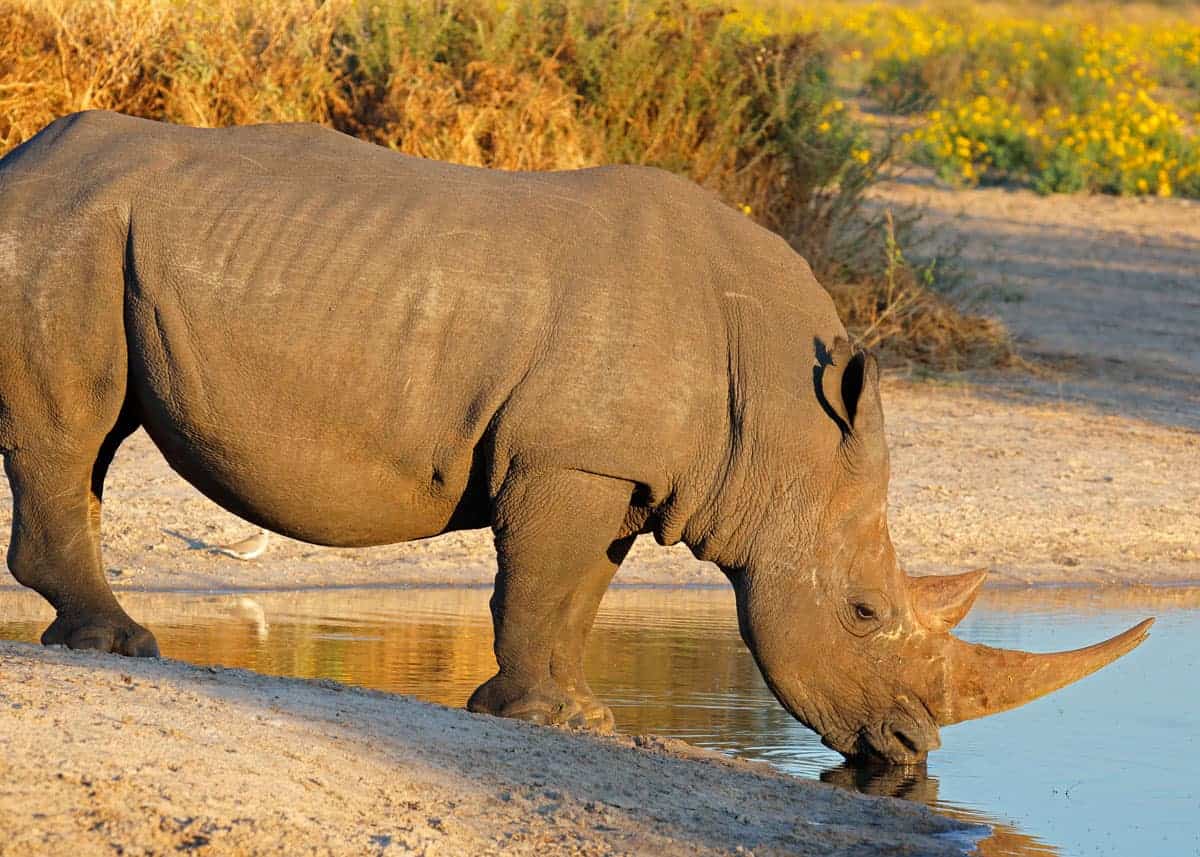
16. The Equator
A visit to Uganda offers you the unique opportunity to stand on the equator and be in two hemispheres at once. Uganda is one of the few countries in the world where the equator crosses through it.
The best equator landmark in Uganda is found on the Kampala-Masaka Road, where you will find a few restaurants and craft/souvenir shops as well.
Other equator markers in Uganda are found in Queen Elizabeth National Park and near Entebbe.
17. Entebbe Botanical Gardens
The locals say that the original Tarzan movies were filmed here, but whether that is true or not, the Entebbe Botanical Gardens is a wonderful place of beauty and discovery where you will find numerous trees, flowers, butterflies, monkeys, squirrels, and birds.
Located near Lake Victoria, this 40-hectare (98 acres) garden complex is a breath of fresh air where you can picnic, walk through a rainforest or just enjoy birdwatching.
Find a great hotel in Entebbe .
18. The Rwenzori Mountains National Park
If you want to experience Uganda’s most extraordinary natural beauty, a visit to the Rwenzori Mountains National Park is a must-do .
Home to the “Mountains of the Moon,” this UNESCO World Heritage Site offers stunning scenery consisting of waterfalls, lakes, rivers, glaciers, and forests that shelter many bird species and chameleons.
Hiking, mountain climbing and culture visits with the Village of Ruboni are just a few of the exciting things you can do here.
19. Rubaga Cathedral
If architectural beauty is your thing, the Rubaga Cathedral in Kampala is well worth a visit. Built in 1914, this historic cathedral sits on a hill overlooking the capital city.
A free, guided tour gives you the chance to see the attractive interior, impressive stained-glass windows, and artifacts. There are also two tombs here that contain the remains of the first African Archbishop of Kampala Diocese and the first African Catholic Bishop.
20. Mount Elgon National Park
Home to the extinct volcano it is named after, Mount Elgon National Park offers diverse landscapes, wildlife, and activities.
You can amble through heath or hike through dense evergreen and bamboo forests to view magnificent waterfalls, stunning peaks, interesting plants, fascinating birds, and primates like the blue monkey and colobus monkey.
If you are lucky, you might glimpse a hyena , buffalo or even an elusive leopard.
21. Sipi Falls
Named after the wild banana plant that grows nearby, Sipi Falls is a popular site located in eastern Uganda on the border of Mount Elgon National Park.
This series of three waterfalls offers spectacular views no matter how you look at them, whether you hike to the top or the bottom. Nearby, you can also check out the coffee farms, explore caves or enjoy a nature walk.
22. Semuliki National Park
It may be one of Uganda’s newest and smallest national parks, but the Semuliki National Park packs awe-inspiring beauty and plenty of attractions that include its most famous, the Sempaya Hot Springs.
After watching the boiling hot springs blast off into a steamy spray, you can hike through the forest to catch glimpses of its many bird species and exotic animals such as flying squirrels, red-tailed monkeys, pygmy antelope , and the endangered shoebill stork .
23. Ssezibwa Falls
The Ssezibwa Falls site is more than just magnificent waterfalls. It is part of an incredibly beautiful oasis just outside of Kampala that is steeped in legend, history, and culture.
The Buganda people can tell you how a woman gave birth hundreds of years ago to the two rivers that flow around a serene island here. Others will tell you how the Ssezibwa Falls area is the perfect getaway from the hustle and bustle of the capital city.
24. Lake Bunyonyi
The locals call it “place of many birds,” but many tourists call it paradise. With its 29 islands, terraced hillsides, charming shore towns, and attractive resorts, it is no wonder that Lake Bunyonyi allures people from all over the world.
Many safari tourists choose Lake Bunyonyi as a base because the lovely setting is relaxing and peaceful. Additionally, the lake offers water sports and birdwatching while the nearby towns provide colorful markets and cultural experiences with the local villagers.
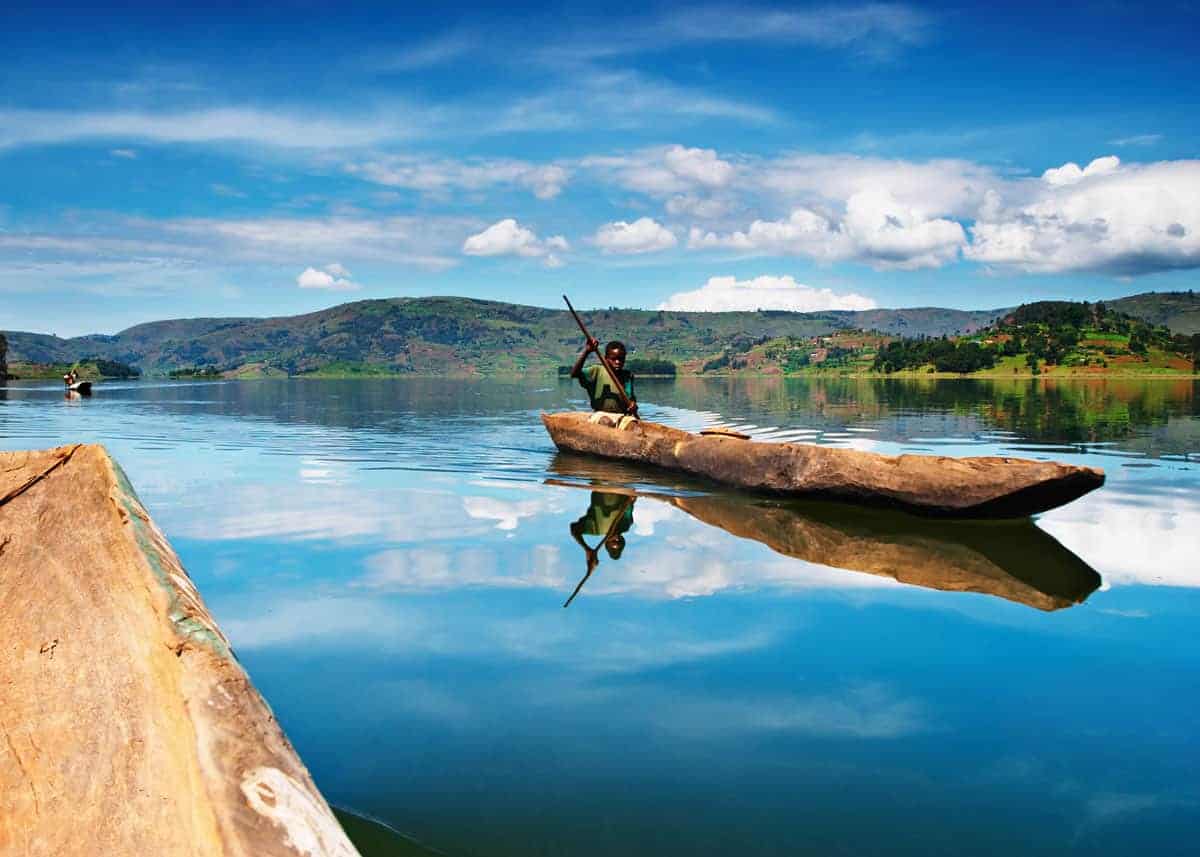
Learn more about the 18 largest cities in Uganda .
25. Lubiri Palace
Lovers of history and architecture may appreciate a visit to the Lubiri Palace, home of the former king of Buganda. Situated on a hill overlooking Kampala, this domed, colonial-style building was involved in the Battle of Mengo in 1966.
Today, you can take a guided tour to see the torture chambers and learn more about Uganda’s history and culture.
26. Nyero Rock Paintings
It is not every day that you get the opportunity to see prehistoric rock paintings, so if you are in Uganda, a trip to Kumi town to see the Nyero Rock Paintings is more than worth the effort.
Found in three separate rock shelters, these beautiful, well-preserved paintings portray concentric circles, animals, and canoes.
The hike to the site is relatively easy, and you just may see monkeys, lizards, and birds along the way.
Here’s our guide to airports in Uganda .
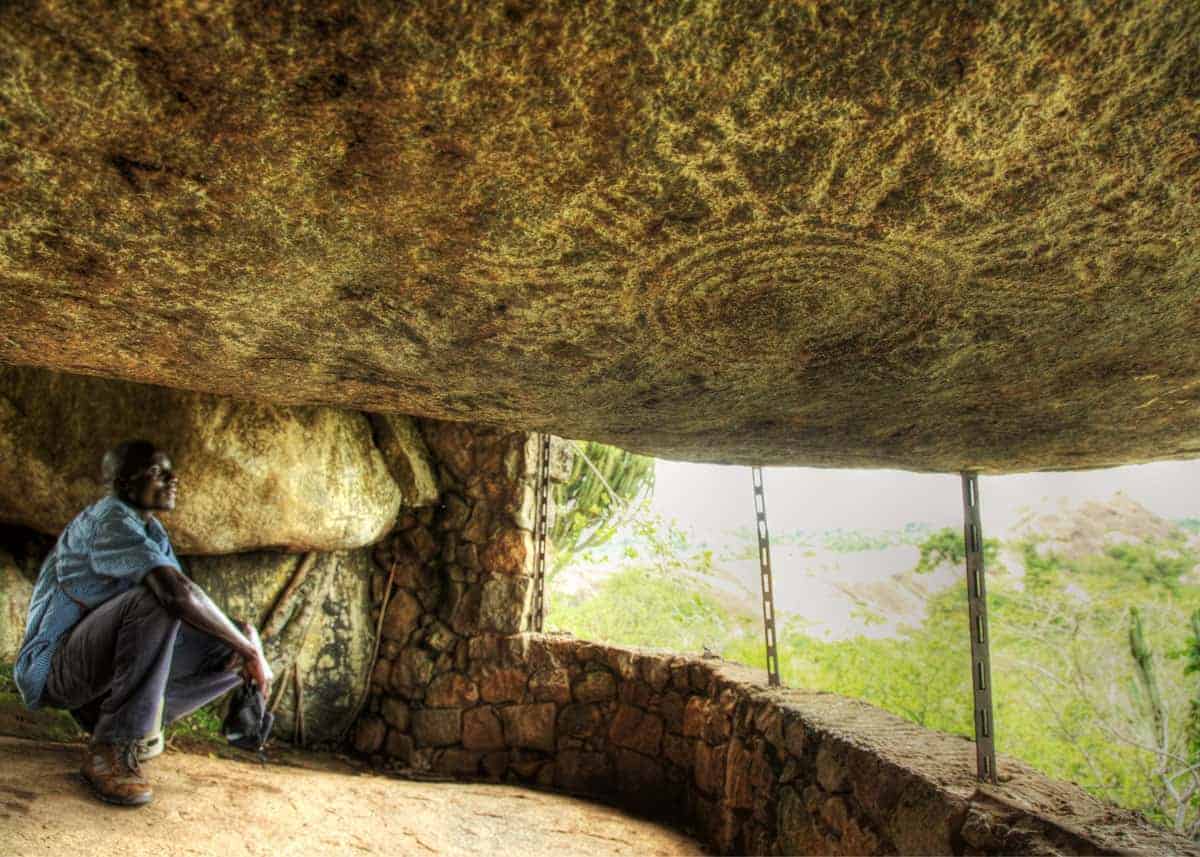
Here are 15 things to do in Uganda – including culture, nature, culinary and adventure.
And there you have it – 26 beautiful and interesting places to visit in Uganda .
Which places are on your bucket list? Let me know in the comments.
Hi, I'm Bryan Haines . And I'm a co-founder of Storyteller.Travel . I'm a traveler and photographer.
I also blog about photography on Storyteller Tech .
Similar Posts

14 Things to Do in Kampala Uganda (Bonus: 11 Kampala Facts)
Thinking about visiting Kampala while in Uganda? In this post, you’ll learn all about Uganda’s capital city – interesting facts and many things to do in Kampala. Looking for facts about Kampala? Jump to that section now. 14 Things to Do in Kampala Uganda Here are 14 things to do in Kampala Uganda. Did we…

Uganda Animals: 27 Amazing Safari Animals of Uganda
Looking for Uganda animals? In this post, you’ll learn about 27 amazing animals that you can see while trekking and on safari in Uganda. They include mammals, birds, reptiles, and fish. 27 African Safari Animals in Uganda Uganda is a landlocked country in eastern Africa. Along with Tanzania and Kenya, it is home to Lake…

How to Choose a Uganda Gorilla Trek (Best Time to Go, Tour Companies, Price…)
Planning your Uganda gorilla trek? Perfect! In this post, you’ll learn what to expect, the best time to go, prices, and how to choose. I also include a list of the top 3 trekking tour companies. What should you bring on your gorilla trek? Don’t forget anything with our Complete African Safari Packing List How…
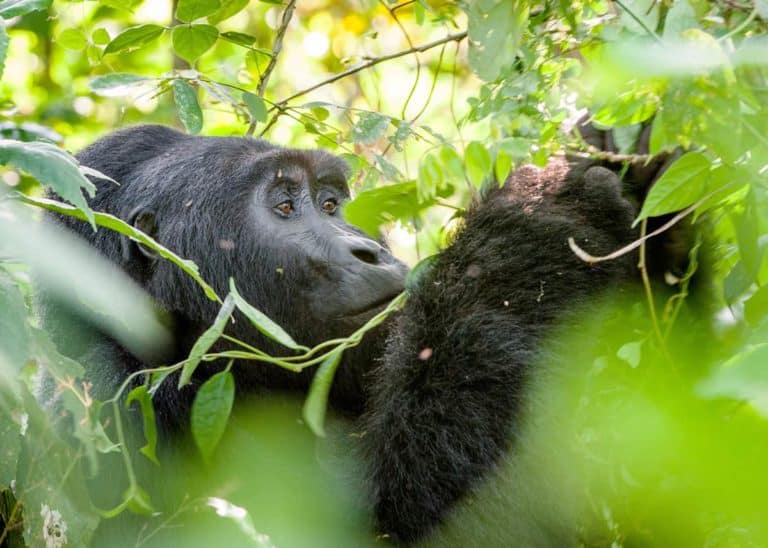
19 Amazing Facts About Uganda Mountain Gorillas (Silverback, Baby, Habitat…)
In this post, you’ll learn all about Uganda mountain gorillas, including their diet, habitat, silverbacks and more. You’ll also learn specific facts about male, female and baby gorillas. And you’ll see lots of amazing pictures and video. 19 Amazing Facts About Uganda Mountain Gorillas Because Uganda is one of only three places where you can…
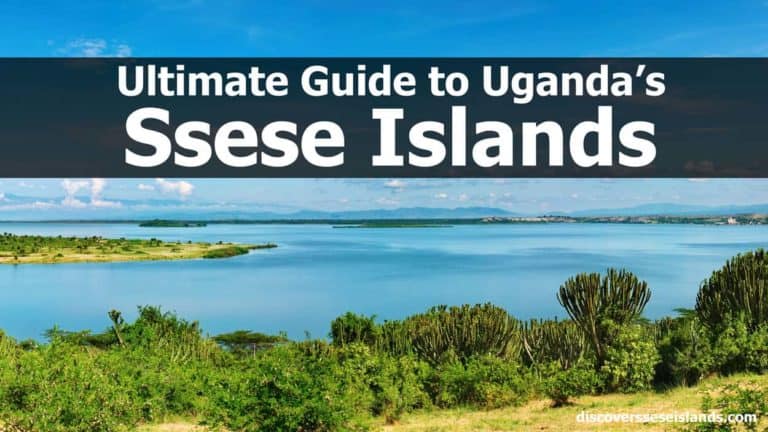
Travel Guide For the Ssese Islands, Lake Victoria (Uganda)
Uganda is rapidly becoming one of the hottest tourist destinations in Africa. People come from all over the world to marvel at the wildlife and plant life, eat incredible food, and take in the breathtaking scenery. The landscapes in Uganda are varied and wonderful. They’re perfect for hiking or taking nature walks. Visit Ssese Islands in Uganda…
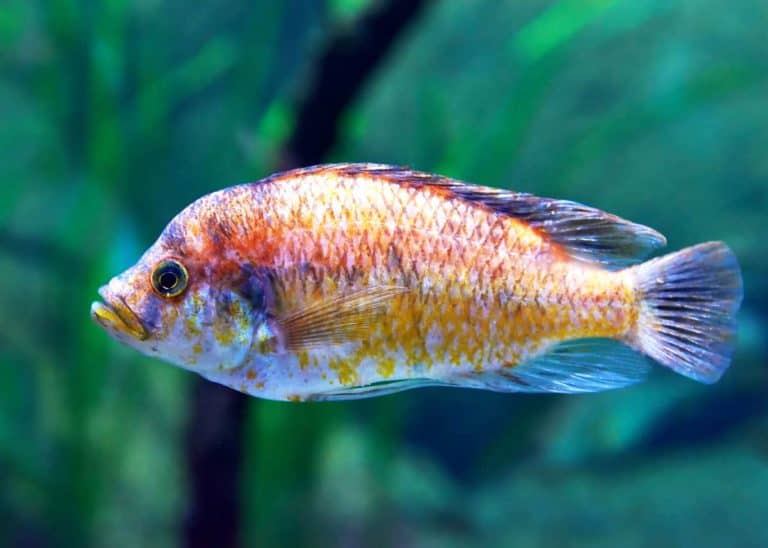
9 Fascinating Facts About Lake Victoria Cichlids (Uganda): 45 Species List
In this post, you’ll learn about Lake Victoria cichlids. We include a list of 45 popular cichlid species, habitat, diet and more. Plus lots of photos and videos! 9 Fascinating Facts About Lake Victoria Cichlids What’s a cichlid? It is a good question, they aren’t commonly known – at least by their name. The truth…
36 Comments
Uganda is really a beautiful country to visit ,spend your vacation, honeymoon,picnics I love the tourism destinations there
Indeed Uganda , the pearl of Africa is enriched with natural beauty that one couldn’t imagine them..I love my motherland.
Am a Ugandan by ,There some tourist places which have been not mentioned above we Bahai Temple in Kawempe Division, kibuli mosque, Old Kampala Hill mosque, lake kyoga,Lake Albert,Mabira forest,Bwenri National Park,
What about kiyira fall kalagala
I love my beautiful country Uganda, the Pearl of Africa!
Ugandan is one of the best country in the world with beautiful nature
I like the Way mother gorilla looks at her beautiful baby. Thank you for sharing.
Great stuff bwana Bryan!
Thanks for compiling and sharing this nice piece of info about Uganda.
Will share this with my friends abroad.
Cheers Bryan!!!😊
Thank you William!
All in all, thanks for marketing UG.
Karimojong culture, and it’s kidepo valley national G.P known for its wilderness, different kinds of cats, 456 bird species or more, mountain hiking on mount moroto where you find the indegenious tribes of the Tepeth as well as the Ik of Kaabong would have been in the list….and by the way the Ugandan museum
This is Good I know the list is endless if we were to add. very good work so far guz.at 49 I don’t know if I can visit all these. One day..
There is also the kitagata hot springs which are know for their magical healings in Bushenyi kitagata town.
Thank you for the info but u forgot to include the beautiful Tooro kingdom palace,the beautiful crater lakes found in fort portal,Amabere gayina mwiru caves in fort portal,Kibale National park for Chimps and Mahoma Falls.
Thank you Dorcas for these great additions to the list!
Wanale falls and caves in mbale Sipi falls in Kapchwora Kisizi falls in Rukingiri Kilembe mines and lake katwe (salt lake) Bahai temple in Kampala Kabaka’s Lake (man made lake) The list is endless
Thanks for loving our country
Thanks for these great additions!
Thanks for compiling this information about Uganda. You forgot about karamoja, the culture and magnificent Kidepo national park
Really u miss to include kidepo national Park and mt Kenya, mt elgon national Park and mt elgon lake bunyonyi, mt rwenzori mt hiking are more touristic than owino and rubaga church.u need to revisit this publication.
Hi Timothy, thanks for the additions to the list. I agree – there are many more beautiful places than on this list.
We’ve covered Rwenzori Mountains and the 10 national parks in Uganda .
We’ll add these other ones to the list for future topics.
It’s absolutely very true friends,take your time and visit the pearl of Africa.however,the story teller didn’t give it all like the culture , there’s one called Acholi traditional dances it’s beating out the Zulu of south africa,am telling you friends as the true born of the land
Am a Ugandan but what I have to assure those wishing to discover the natural buity of the world visit the Pearl its a mazing and u will never regret
If it was not intationally to discrimination ISLAMIC PLACE GADAFI MOSQUE how can you be remembering to put LUBAGA CATHEDRAL and you forgotten GADAF MOSQUE (YET YOU KNOW VERY WELL WHO WAS GADAF TO AFRICA AND THE WHOLE WORLD, I MEAN HE WAS VERY FAMOUS THAN AND HIS PLACES ARE MORE ATTRACTIVE TO THE TOURISTS THAN LIKE 18 PLACES YOU’VE OUTLINED.
NOTE: YOUR NOT AT ALL A GOOD MARKETIER IF YOU STILL HAVE THOSE BACKWARDS DISCREMINATION IDEOLOGIES.
Thanks for your additions to the list. We included the Uganda National Mosque (Gaddafi Mosque) – in this post about 14 Kampala attractions .
It’s interesting that you missed to to mention Gadaffi Mosque!!!
We included it here – in this post about Kampala attractions .
Thank you for this brilliant article . Also 1. Amabere ga nyina mwiru caves and crater lakes in Fortportal. 2. Lake bunyonyi
Thanks for the additions!
I would refer to this as Uganda at the finger tips, this is awesome.
@Ben,there are more interesting places to talk about than Owino, Rubaga,Kampala city…..mabira forest should have been in the list too
wow, this is the entire information one needs to know if they intend to travel to Uganda on a safari .
Hello! I will like to know if June it’s a good time to travel to Uganda and Ruanda to see the gorillas
Yes, either January / February or June to September (the two dry seasons) are good times to go gorilla trekking.
@Bryan Haines, Am humbled by this presentation . I will visit half of these sites by end of 2022
@Bryan Haines, Thanks though you forgot to add the Westnile regions evenings with a cool lingala music, the culture of the people in westnile most notable the aringa people,katwa people where the former president of Uganda Field Mershall Iddi Amin Dada originated from and also some places to visit like mountain kei, liru etc
Thanks Samad – these are some great additions!
Leave a Reply Cancel reply
Your email address will not be published. Required fields are marked *
TOP DESTINATIONS
- Kruger Park
- Okavango Delta
- Serengeti National Park
- Victoria Falls
TOP COUNTRIES
- South Africa
TRAVEL DEALS
View All Travel Deals
SOUTHERN AFRICA
East africa, indian ocean islands, top experiences.
- Beach Holidays
- Family Safaris
- Honeymoon Safaris
- Desert Safaris
- Luxury Rail Safaris
- Multi-Generational Safaris
- Positive Impact Safaris
- Photographic Safaris
- Walking Safaris
WILDLIFE SAFARI
- Big Five Safaris
- Birding Safaris
- Gorilla Trekking Safaris
- Migration Safaris
- Mobile Camping Safaris
- Horseback Safaris
FEATURED EXPERIENCES
Comfort levels, property types.
- Tented Camps
- Boutique Hotels
Featured Safari Collections
- The Safari Collection
- Natural Selection
GET TO KNOW US
- Meet The Team
- Pricing Explained
- Traveller Reviews
- Traveller Stories
- Why Book With Us?
- HerdTracker
- Safari Cost Calculator
- South Africa In 360
- Trusted Safari Partners
What are you looking for?
- Safaris & Tours
- Destinations
- Experiences
- Accommodations
- Why book with us?
Hello traveller!
It's in Cape Town now.
We're sorry. Our safari planners aren't available now. Our office hours are 08:00 - 19:00 (GMT+2).
Call us to speak to an experienced safari planner.
Alternatively, we recommend...
Schedule a phone or Zoom call with one of our safari planners
Complete our travel enquiry form to connect with a safari planner
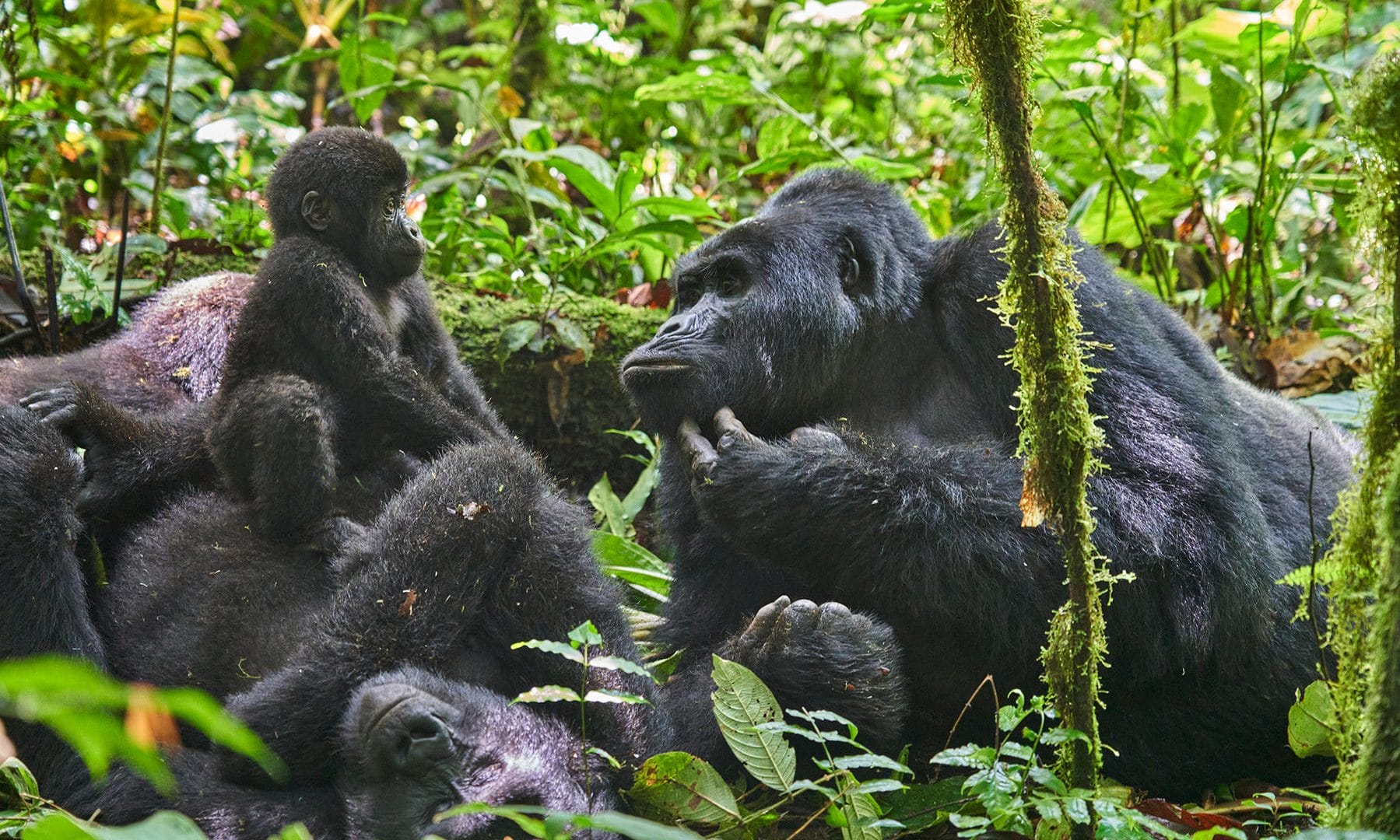
Everything You Need to Know About Eco-Tourism in Uganda

Author: Susan Swanepoel - 8 January 2024
Last Update: 20 February 2024
Part of the Travel To Uganda & African Safari Collection
Thanks to its remarkable biodiversity, natural beauty, and rich cultural heritage, Uganda can offer eco-tourists a wide range of unique and sustainable activities.
Visitors can enjoy authentic safari experiences while contributing to conservation and local community development, ensuring the country’s treasured environments and traditions remain pristine and protected. Here’s everything you need to know about ecotourism in Uganda .
1. National Parks and Wildlife Reserves
Uganda is home to a network of protected areas, including 10 national parks, six wildlife reserves, and several forest reserves. With their diverse landscapes and abundant wildlife, these locations attract eco-tourists from all over the world who want a sustainable safari experience.
Park fees and permit costs help fund conservation efforts and research while helping to support local communities.
2. Birdwatching
With over 1000 recorded bird species, Uganda is heaven for birders and avian photography enthusiasts. Highlights include the rare and sought-after shoebill stork, the endemic, green-breasted pitta, African paradise flycatchers, African pied hornbill, and red-throated bee-eater.
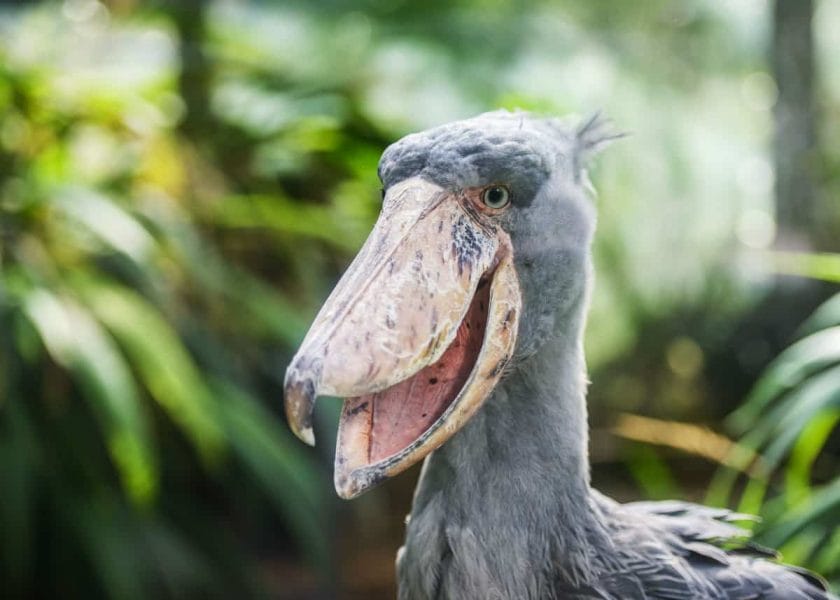
Bwindi Impenetrable National Park , Mabamba Swamp, Semuliki National Park, and Queen Elizabeth National Park are all key birding destinations. Hire a local guide who knows the area and can direct you to that unforgettable sighting.
3. Gorilla Trekking
Bwindi Impenetrable National Park and Mgahinga Gorilla National Park both offer guided mountain gorilla trekking tours , giving visitors (in small groups) the opportunity to responsibly witness and photograph these fascinating creatures in their natural habitat.
This activity is restricted to only a few permits per day. Watch them eat, play, and groom each other deep in the forest – it’s an awe-inspiring experience.
4. Primate Tracking
Gorillas aren’t the only primates in Uganda. There’s also the chance to track other species, like chimpanzees in Kibale Forest National Park and on Ngamba Island.
Head to Mgahinga Gorilla National Park to spot golden monkeys in the wild and marvel at their ability to move swiftly through the forest canopy. Experienced guides maximize your chances of tracking down these agile apes.
5. Community-Based Tourism
Travelers can immerse themselves in Ugandan culture and traditions through community-based tourism activities. Stay in a homestay, visit villages, and learn about local crafts and customs. These cultural interactions help support local communities and shine a light on their unique heritage.
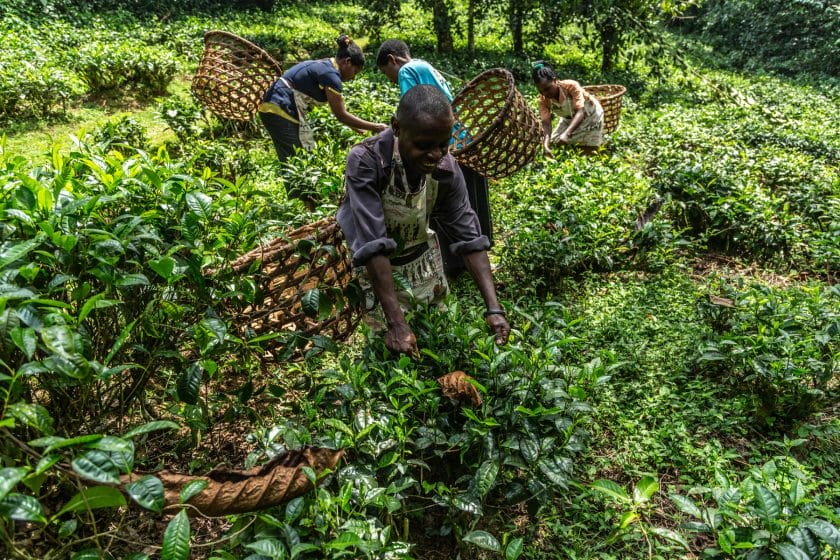
Popular community tourism activities include visiting the Batwa pygmies, learning about traditional fishing on Lake Victoria, and touring the Kasubi Tombs.
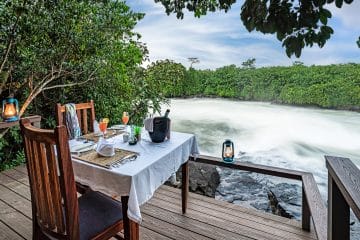
Wildwaters of Uganda
East Africa Uganda
From $ 2050 /USD
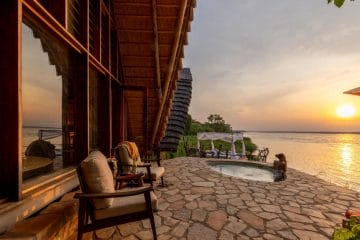
Murchison Falls Short Stay
From $ 3290 /USD
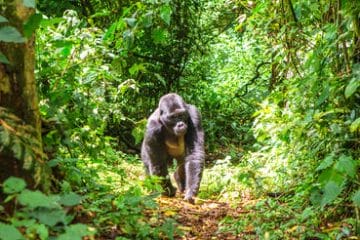
Luxury Gorilla Trekking in South Bwindi
East Africa Uganda Bwindi Impenetrable
From $ 3500 /USD
6. Nature Walks and Hikes
With its rainforests, cloud forests, and savannah grasslands, Uganda offers hikers and nature enthusiasts a wide range of trails to explore. Travelers can take guided hikes, nature walks, and forest treks to really immerse themselves in the varied ecosystems.
Kibale Forest National Park and Rwenzori Mountains National Park are both excellent destinations. Adventurous visitors can even climb to the summit of Mount Rwenzori.
7. Conservation Initiatives
Many camps, lodges, national parks, and reserves are associated with some form of conservation initiative. Park fees and tourism revenue are channelled into these projects to protect wildlife and habitats and engage in sustainable tourism practices.
The Uganda Wildlife Authority (UWA) is just one of many organizations managing protected areas and spearheading conservation efforts.
8. Sustainable Lodging
There are a number of eco-lodges and camps in Uganda that minimize their environmental footprint, using local materials, employing local people, and supporting local communities. Some popular eco-lodges and camps are:
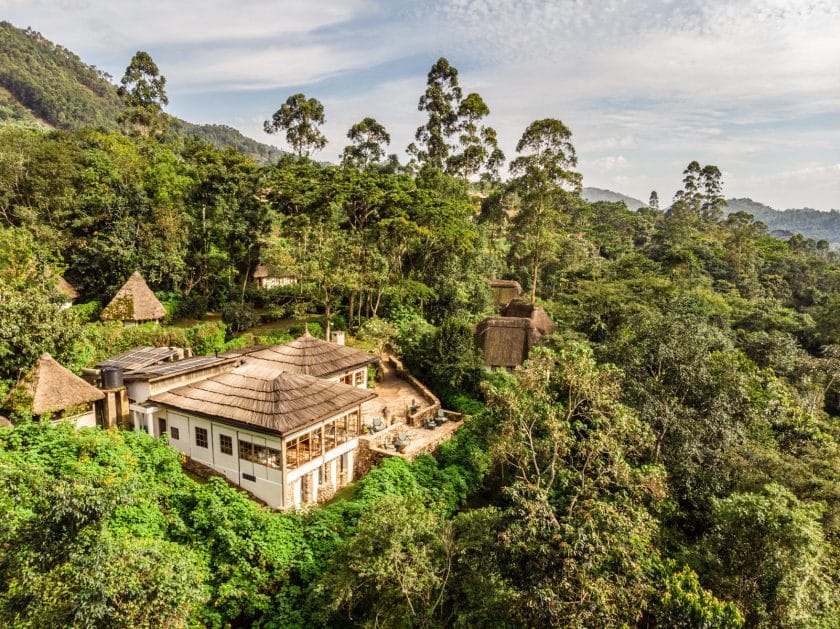
- Bwindi Impenetrable National Park: Volcanoes Bwindi Lodge
- Mgahinga Gorilla National Park: Gahinga Lodge
- Kibale National Park: Ndali Lodge
- Murchison Falls National Park: Murchison River Lodge
- Queen Elizabeth National Park: Kyambura Gorge Lodge
9. Adventure Tourism
Uganda offers thrillseekers a range of adrenaline-pumping activities, from guided whitewater rafting on the Nile River, mountain biking and zip-lining through forests to kayaking on the country’s many lakes and rivers. By hiring a local guide you contribute to the community’s economy.
10. Ecological Research and Education
Various educational programs and research opportunities offer travellers the chance to gain a deeper understanding of Uganda’s ecology and conservation projects.
Ecological research and education play a crucial role in promoting conservation, raising awareness about Uganda’s rich biodiversity, and ensuring the long-term sustainability of its ecosystems. Visitors can engage in research activities such as bird banding, wildlife tracking, and vegetation surveys.
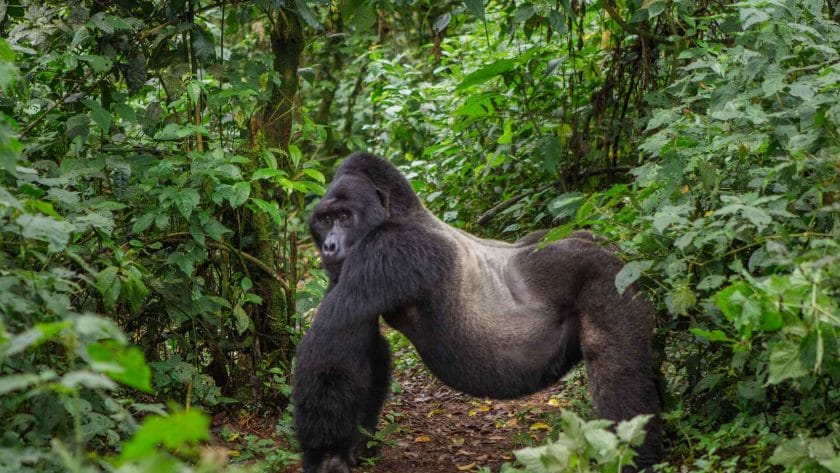
By choosing a responsible tour operator and accommodations that prioritize environmental and social sustainability, travellers to Uganda can contribute to conservation efforts and help support the livelihoods of local people.
Speak to a safari expert at Discover Africa today about planning a sustainable, eco-conscious, tailor-made luxury safari in Uganda .
Majestic Visitor: Juvenile Whale Shark Charms Cape Town’s Clifton 4th Beach
10 Local Cuisines You Have to Try in Tanzania
Related Safari Tours
These popular itineraries can be customised to match your budget and how many people you're planning to travel with..
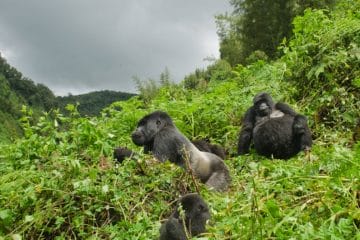
Meet the Gorillas of Uganda and Rwanda
East Africa Uganda Entebbe Queen Elizabeth Rwanda Volcanoes
From $ 7990 /USD
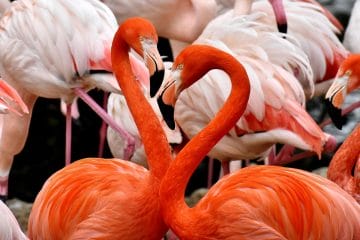
Birding Tour Through Uganda
Uganda Entebbe Kampala Kibale Queen Elizabeth Bwindi Impenetrable
From $ 9830 /USD
Keep discovering...
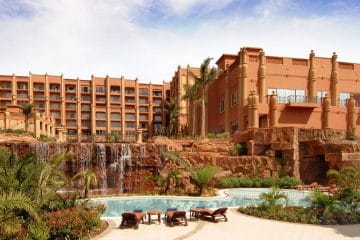
Uganda Uganda
5 luxury accommodation establishments to stay at in uganda.
Uganda is a country of absolute natural beauty and it has been...
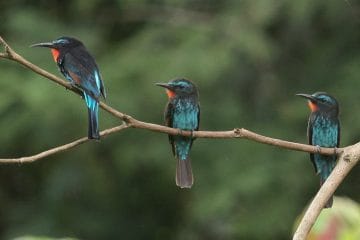
Beautiful and bizarre birds of Uganda
Aside from the thrilling gorilla trekking experience to be had on a...
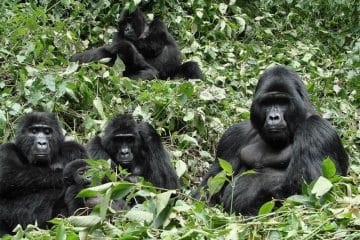
Can these images convince you to go on a gorilla trekking safari?
Whether you're going to Rwanda's Volcanoes National Park, or the Bwindi Impenetrable...
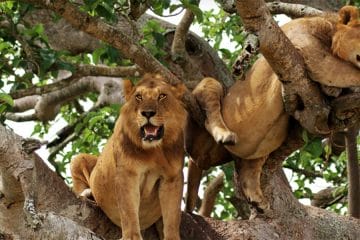
10 reasons why you should explore Queen Elizabeth National Park
Queen Elizabeth National Park situated in the western Uganda is home to...
Why travel with us?
Recent reviews from travellers who planned and booked their africa trips with discover africa safaris.
3 Day Stellenbosch Safari Review
Atle B Johansen, Norway 14 Nov 2023
Diane went above and beyond to put together the perfect honeymoon package.
Zambia & Zimbabwe Safari Honeymoon Review
Corby, United States 07 Jun 2023
Brilliant. megan was efficient, on the ball and prepared everything..
Vic Falls, Botswana & Okavango Delta Safari Review
Sally, South Africa 09 Sep 2019
Excellent attention and bespoke travel experience..
Tanzania Great Migration Review
Ruth, United States 12 Sep 2018
Visiting gorillas in uganda was a breeze thanks to discover africa safaris.
Review of Gorilla Trekking in Uganda
Jorge Toledo, Brazil 23 Jul 2018
Perfectly tailormade tour taking all our wishes and requests into consideration..
Namibia and Botswana Review
Henrik Wetterstrand, Sweden 05 Apr 2018
Registered Members of these Organizations
USEFUL LINKS
- Safari Tours
- Accommodation
- Why Book with us?
- Content Collaborations
- Safari Cost Estimator Tool
- Wildebeest Migration
- Privacy Policy
- Website Terms of Use
POPULAR COUNTRIES
- View All Countries
POPULAR DESTINATIONS
- View All Destinations
- Cape Town Holidays
- Kruger National Park
- Etosha National Park
- Chobe National Park
TRAVEL BLOGS
- Norse Atlantic Adds New Direct Flight to Cape Town
- Travel News Digest, 19 April: SA Airports Celebrated, Rhino Poaching Concerns, Cape Town ‘Big Six’ Appeal
- FastJet Adds Surcharge to Vic Falls Route
- A Seasonal Guide to Honeymoon Safaris in Africa
- A Family Safari Guide to Health and Wellness
DISCOVER AFRICA SAFARIS
- 2nd floor, Tygervalley Chambers One, 27 Willie van Schoor Avenue, Bellville, Cape Town , 7530
- Search Please fill out this field.
- Manage Your Subscription
- Give a Gift Subscription
- Sweepstakes
- National Parks
The Best National Parks in Uganda for Beautiful Views, Wildlife, and Lodges
Jaw-dropping landscapes and unforgettable wildlife experiences await at Uganda's best national parks.
There might be a silver lining to Uganda being so bafflingly underrated as a tourist destination: the chance to explore world-class natural attractions while dodging the masses seen in neighboring countries. Offering more than just gorilla trekking (though it's indeed phenomenal), the Pearl of Africa is home to a treasure trove of wildlife and soul-stirring landscapes, the best of which can be explored within the country's well-protected parklands.
With that in mind, here are four excellent national parks in Uganda — with corresponding lodges — to consider for your next East African adventure.
Queen Elizabeth National Park
Few African parks can rival Queen Elizabeth's biodiversity, from its savannas and crater lakes to its dense forests and wetlands. Nearly 100 mammal species roam this equator-straddling park, which contains four of the Big Five animals. However, it's perhaps best known for its tree-climbing lions in southerly Ishasha. Other highlights include languid boat tours along the Kazinga Channel, where buffalos, elephants, and hippos coexist along the scenic banks, and the Kyambura Gorge , a sunken forest amid the savanna where nearly 30 endangered chimpanzees dwell.
Where to Stay: Kyambura Gorge Lodge
Perched atop the lush Kyambura Gorge, this eco-luxury lodge from Volcanoes Safaris has community and conservation at its heart. Formerly a coffee estate, the recently upgraded resort features eight plush bandas and a bevy of activities, from beekeeping and village project tours to guided gorge hikes and twice-daily game drives in Queen Elizabeth.
Bwindi Impenetrable Forest National Park
Rwanda might be the best-known destination for African gorilla trekking , but it is Uganda's Bwindi Impenetrable Forest that holds half of the world's gorilla population.
Intrepid travelers endure steep hikes along this UNESCO-listed park's verdant slopes to find the world's largest primates, with many describing the journey and privileged encounter as "life-changing." To learn how indigenous, forest-dwelling peoples once lived in the park area, the Batwa Cultural Experience in neighboring Nkuringo is a must.
Where to Stay: Clouds Mountain Gorilla Lodge
At nearly 7,000 feet above sea level, the aptly named Clouds is Uganda's highest inn and a top lodging choice for gorilla treks — it's situated a stone's throw from Bwindi's Nkuringo gate. Ten classic, high-beamed stone cottages dot the hillside, and on a clear day, seven Virunga volcano peaks reveal themselves for unforgettable views of Uganda and beyond.
Kipedo Valley National Park
Bordering South Sudan and Kenya , Uganda's most remote national park is an off-the-beaten-path destination that's well worth the trek. Outstretched acacia trees dot the semi-arid landscape, filled with both familiar wildlife and animals you can't find anywhere else in the country, including cheetahs, aardwolves, and black-backed jackals. Its far-out location rewards travelers with minimal crowds and natural beauty that rivals that of more popular East African parks, such as the Maasai Mara and Serengeti.
Where to Stay: Apoka Safari Lodge
For Apoka guests, a safari drive isn't required to see Kidepo's zebras, elephants, and warthogs (though it's highly recommended). These animals, drawn by a watering hole and abundant grassland, will come to you instead. There are arresting views for miles from the park's sole upscale lodge, best experienced from the granite-carved infinity pool or one's outdoor sunken stone bathtub.
Murchison Falls National Park
Uganda's largest national park offers more than its name suggests. Popular safari wildlife and the endangered Rothschild's giraffe cover the endless savanna, while 450 birds species and fearsome hippos line the Nile River, where tour boats glide through sedate, wide-mouthed waters. Its eponymous attraction, though, is among the most spectacular sights in Africa: the Victoria Nile squeezing through a bottlenecked gorge to create the world's most powerful waterfall. Take a hike to the top of the falls for up-close access to Uganda's best-known natural wonder.
Where to Stay: Nile Safari Lodge
Nile Safari Lodge , a stylish, eco-conscious retreat along the banks of the iconic river, is an excellent base from which to explore the park's top attractions. Travelers can choose from accommodations that include solar-powered Deluxe Bandas and a two-bedroom Family Villa, which has its own private pool and expansive terrace.

Getty Images
The source of the Nile river starts in the Rwenzoris, Africa’s tallest mountain range that stretch across western Uganda shrouded in mist and teeming with glaciers, waterfalls and alpine lakes. These ‘mountain’s of the moon’ are the home of Uganda’s mountain gorillas and tracking them through this majestic habitat is one of the country’s most iconic experiences.
Leave the planning to a local expert
Experience the real Uganda. Let a local expert handle the planning for you.
Attractions
Must-see attractions.
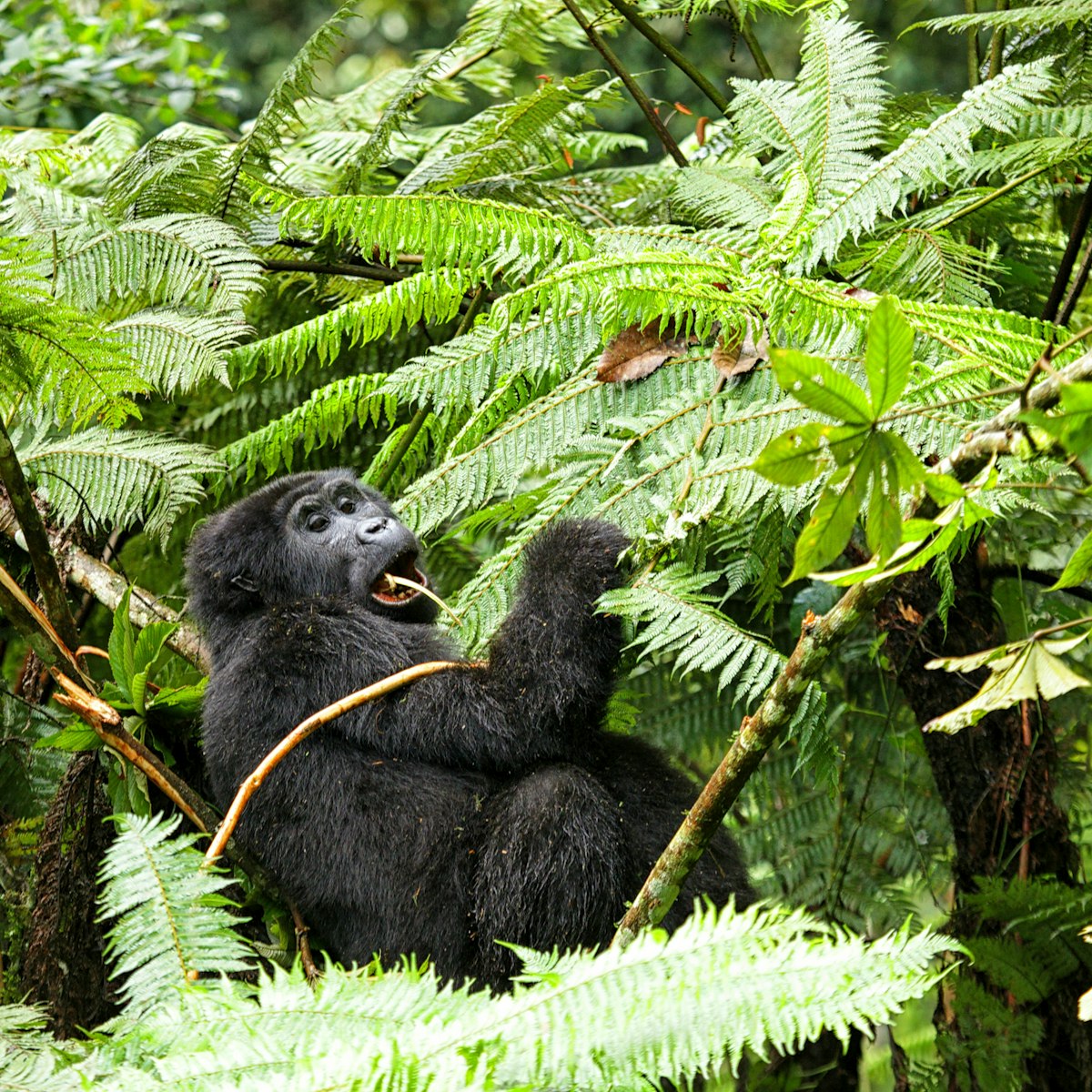
Bwindi Impenetrable National Park
Southwestern Uganda
Home to almost half the world’s surviving mountain gorillas, the World Heritage–listed Bwindi Impenetrable National Park is one of East Africa’s most…
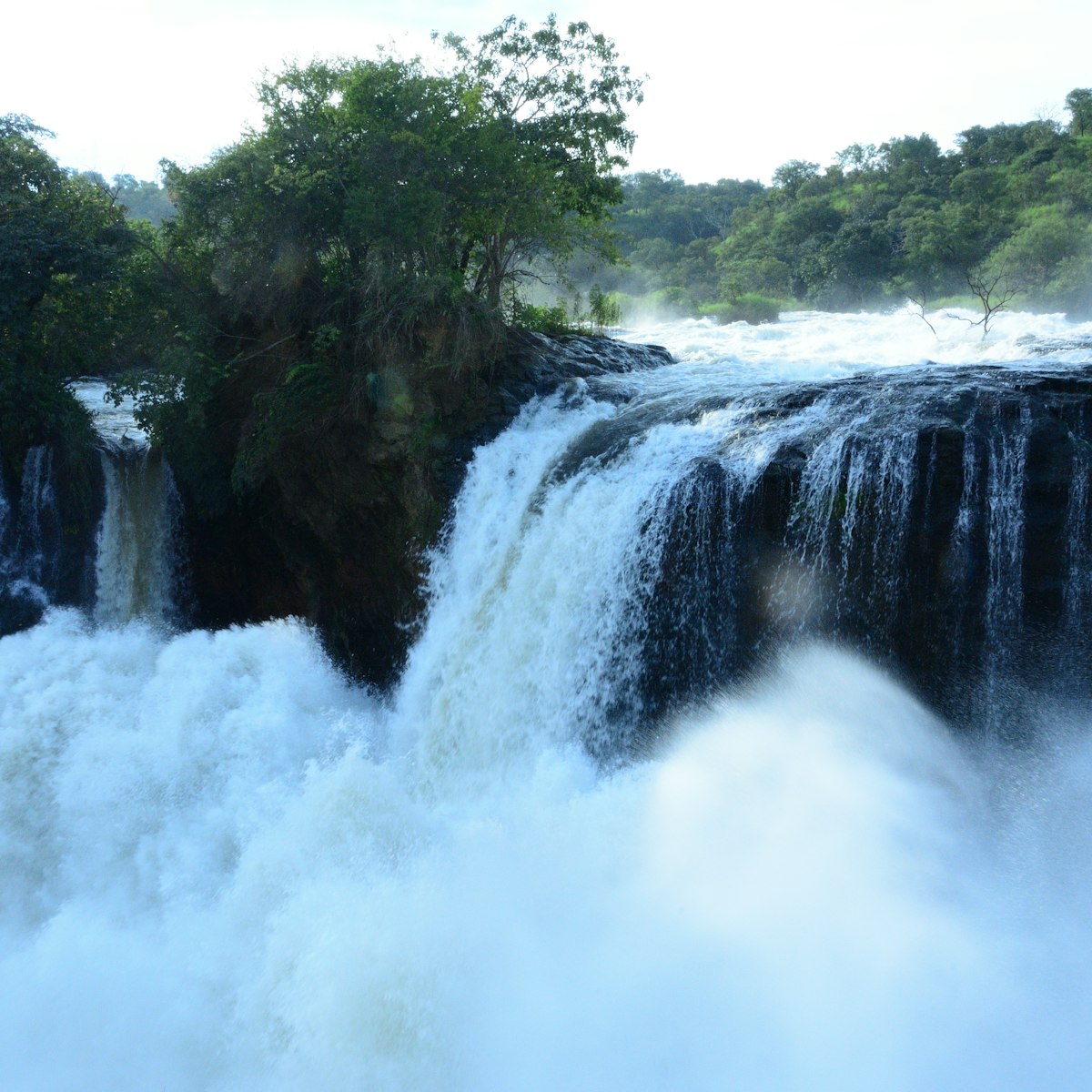
Top of the Falls
Once described as the most spectacular thing to happen to the Nile along its 6700km length, the 50m wide Victoria Nile is squeezed here through a 6m gap…

Igongo Cultural Centre
Located 12km from Mbarara on the road to Kampala, this cultural village features the best museum displays in Uganda. Set on the grounds of a former palace…

Murchison Falls National Park
Uganda’s largest national park is one of its very best; animals are in plentiful supply and the raging Murchison Falls, where the Victoria Nile crashes…
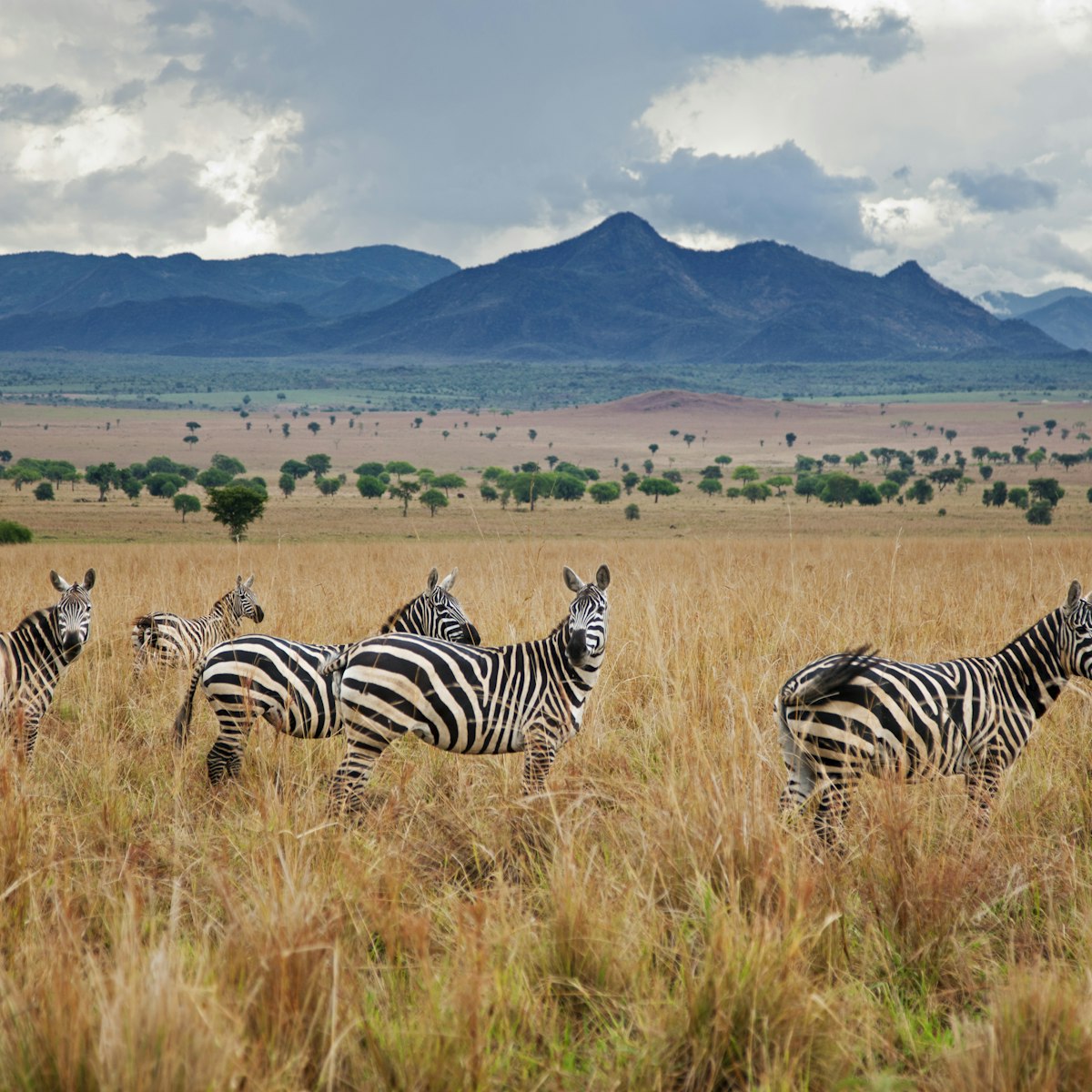
Kidepo Valley National Park
Offering some of the most stunning scenery of any protected area in Uganda, Kidepo Valley National Park is hidden away in a lost valley in the extreme…

Mengo Palace
Built in 1922, this small palace is the former home of the king of Buganda, though it has remained empty since 1966 when Prime Minister Milton Obote…

Ngamba Island Chimpanzee Sanctuary
This sanctuary in Lake Victoria is home to around 50 orphaned chimps that have been rescued from elsewhere in Uganda and are being rehabilitated as much…
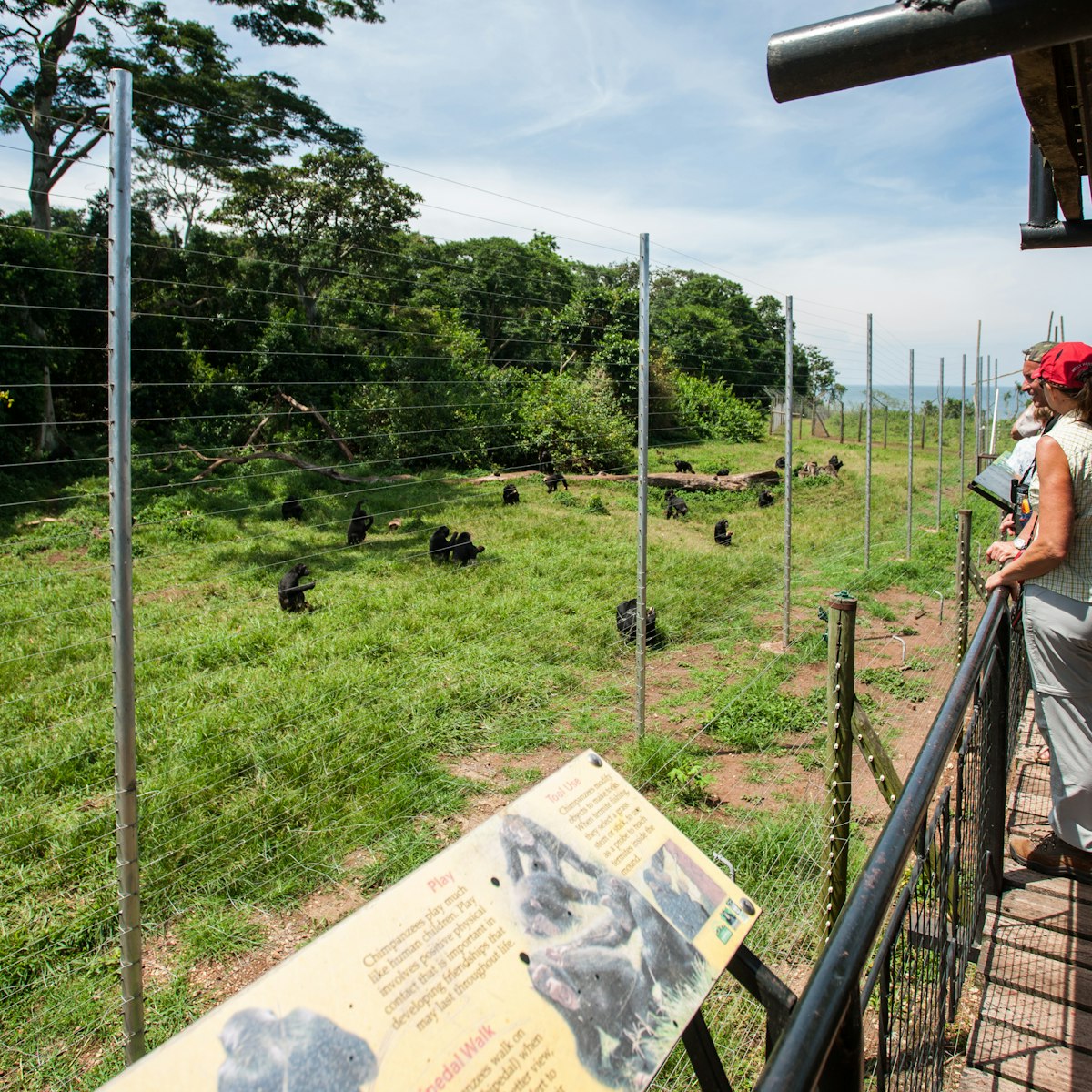
Eastern Uganda
Located 23km southeast of Entebbe in Lake Victoria, Ngamba Island Chimpanzee Sanctuary, or 'Chimp Island', is home to over 40 orphaned or rescued…
Plan with a local
Experience the real Uganda
Let a local expert craft your dream trip.

Latest stories from Uganda
Filter by interest:
- All Interests
- Adventure Travel
- Art & Culture
- Beaches, Coasts & Islands
- Food & Drink

Wildlife & Nature
Jan 13, 2021 • 2 min read
Researchers have become interested in two creatures with shorter legs who have been discovered in different countries.

Oct 13, 2020 • 2 min read

Sep 15, 2020 • 2 min read
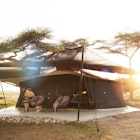
Oct 22, 2019 • 5 min read

Sep 16, 2019 • 6 min read

Jul 25, 2019 • 7 min read

May 17, 2019 • 6 min read
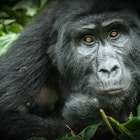
Feb 27, 2018 • 6 min read

Oct 14, 2016 • 4 min read
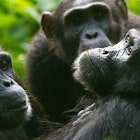
Aug 12, 2013 • 4 min read
in partnership with getyourguide
Book popular activities in Uganda
Purchase our award-winning guidebooks.
Get to the heart of Uganda with one of our in-depth, award-winning guidebooks, covering maps, itineraries, and expert guidance.
Uganda and beyond
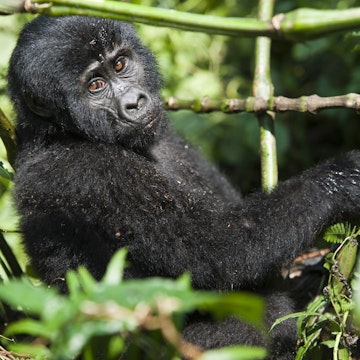
National Geographic content straight to your inbox—sign up for our popular newsletters here

How conservationists are striving to protect the wildlife of Uganda’s national parks
With elephant numbers stabilising and lion tracking programmes in place, tourism numbers are returning to Uganda’s national parks, not least to the dense, misty forests in the south of the country, home to more than half the world’s mountain gorillas.
Waves swell with the force of five oceans as water charges and tumbles over rocks. Foaming with fury and roaring with rage, jets explode from every crack and crevice, clouding the area in white smoke.
Spilling over an escarpment at the northernmost tip of Africa’s Western Rift Valley, Uganda’s Murchison Falls has forever been in a state of turbulence. This mighty bottleneck in the Nile has swallowed bridges, thrown light aircraft off course and narrowly escaped a hydro dam development.
A boiling pot of controversy, where disagreements continuously bubble away, today her mood is darker than the depths of hell. Skittish butterflies skirt over the surf and rainbows fail to reconcile their arcs as the cataract consumes everything in its path.
Heavy rains have caused water levels to surge but her anger could be down to other reasons, suggests my guide, George, as we hike from the car to a nearby viewpoint.
Termite mounds sparkle with flecks of mica and the quartzite rocks shimmer like jewels. But other riches are currently determining the future of Uganda’s oldest conservation area and biggest national park, which sprawls across a section of land larger than Cornwall in the country’s north west.
“Oil is like a curse,” complains George as we reach the top. “Countries with it never do well.”

A decision to drill for black gold in Murchison Falls and build a pipeline to Tanzania has been met with mixed responses in Uganda, a nation wealthy in natural assets but economically poor. While French oil company TotalEnergies has promised to minimise its footprint, lodge owners, guides and environmentalists remain sceptical.
Any concern is testimony to the value Uganda places on its wild spaces. Historically, the country has been praised for its environmental efforts, and behind the scenes of its 10 national parks and multiple reserves are individuals working hard keep them safe. Meeting them is as rewarding as viewing big cats on a game drive or tracking great apes in a primordial forest — something I learn first-hand on an itinerary exploring some of the most important conservation projects accessible to tourists.
Although the oil extraction is a done deal, with most infrastructure in place and the construction of a pipeline due to start this year, only 1% or the park will be directly impacted. Exploring by dirt road and river, I encounter a precious Eden: waterways heave with crocs and hippos; papyrus reeds twitch with the stealthy tiptoe of shy shoebills; and rare Rothschild’s giraffes stride across sweeping savannahs and hills.
NGO Uganda Conservation Foundation , in collaboration with the Uganda Wildlife Authority (UWA), works diligently to protect this paradise. On a tour of its newly completed Law Enforcement and Operations Centre, founding trustee Mike Keigwin proudly shows off a complex where every cog of a well-oiled anti-poaching mechanism — from satellite-linked surveillance screens to temporary prison cells and a police station — whirs away under one roof. One hundred young people from the fringes of Murchison Falls were contracted for the construction, with many now training as rangers for UWA.

“It’s the first of its kind in Africa,” beams Mike, a sharp-thinking British problem-solver who ditched a job with consulting firm Deloitte to work in conservation. Detaining poachers on site speeds up the judicial process, he explains, while computers mapping incidents of crop raiding help rangers swiftly deal with problem animals straying from the park into community land.
From the late 1970s until 2000, elephant numbers in Murchison Falls — once the most visited park in Africa — crashed from 16,000 to 500, but in recent times the situation has stabilised, and tourism is returning.
An armoury packed with confiscated weapons, which are safer under lock and key than discarded, is a chilling reminder that illegal activity is still a threat. “Under every building in this complex, there are another 20-30,000 snares,” sighs Mike, picking through wire coils and hefty wheel clamps, some still with tufts of animal hair in their jaws. “We were running out of space.”
The cost of protecting Africa’s wild areas is enormous, but the potential losses are too overwhelming to contemplate. Although the trade in animal parts has largely been brought under control, the biggest threat now lies in the conflict between communities and wildlife, as populations grow and habitats shrink.

Into the woods
Budongo Forest, a 45-minute drive south of the falls along a newly paved, Chinese-built road, is ever-threatened by illegal logging and encroachment. A strict set of hunting rights issued by the King of Bunyoro safeguarded the tropical rainforest in the past, but now chimpanzee tourism is its key custodian.
Setting off at 7am, I join Amos Wekesa, owner of the Budongo Eco Lodge , for a full day chimp ‘habituation’ experience — providing an opportunity to discover how these great apes are acclimatised to humans. His simple wooden lodge and cabins, once used by the Jane Goodall Institute as a field base, sits at the mouth of several trails.
Silenced by thick walls of spiralling ferns and a canopy of latticed branches, human voices quickly drift away as we tumble into a fairytale forest beyond the imagination of even the Brothers Grimm.
Ancient mahogany trees form a colonnade of Corinthian pillars, supporting a temple more sacred than any man-made place of worship. Epiphytes balance on borrowed altars, while strangler figs grip their victims, performing a slow act of sacrifice. On the soft, spongy ground, decaying trunks sprout with wisps of ghost white fungi.
Alongside a stream, Amos picks up a freshly discarded seedpod. “Chimps use these as drinking cups,” he explains, indicating they must be nearby. On cue, we hear the thundering of ironwood buttress roots, followed by grunts of joy.
Perched contentedly like a Buddha on his plinth, 43-year-old chimp Jacko is munching on the ripe fruits of a fig tree.
“Watch out or you’ll be hit by the wadge,” warns Amos, as we narrowly avoid a bombing of chewed up pulp.

Sociable or otherwise, behaviour of the Kaniyo Pabidi chimp community has been studied since the 1960s, and now tourism revenue generated by visits to the habituated group guarantees their future.
Amos and his tour company Great Lakes Safaris , which manages the Budongo concession on behalf of the National Forestry Authority, helped generate US$300,000 (£217,000) per year before the pandemic struck — funds used to employ a team of forest rangers on the ground.
Equally impressive is Amos’s own rags to riches story, which he shares with me over dinner back at the lodge. Born into a destitute family on the Kenyan border, he was smuggling goods by the age of six.
An educational grant from the Salvation Army provided a stepping-stone out of poverty, but it was determination and tenacity that paved his way. Despite earning only $10 (£7) a month as a sweeper, progressing to $1 (£0.70) a day as a tour guide, he still managed to stash some savings, starting Great Lakes Safaris 20 years ago with only $200 (£145) in his pocket.
Amos is extremely likeable: a businessman whose heart lies in conservation. When the Ugandan government considered plans to dam Murchison Falls, Amos threatened to protest naked, and his Facebook page (with more than 75,000 followers) functions as a platform to educate young minds.
“We’re not the last generation,” he complains, scrolling through a deluge of social media comments that could put some of the biggest influencers in the shade. “We can’t live like we’re the last people to leave.”
Amos owns three lodges in Uganda, including the newly revamped Elephant Plains Lodge in the northern section of Queen Elizabeth National Park (QENP). It takes me six hours to reach the long, thin park, which shares Lake Edward with the Democratic Republic of the Congo (DRC). But driving through the country’s wildly varying climatic zones is an experience, enlivened by a cast of daredevil drivers and sideshow attractions on the way.

Swathes of green forest fan out into grasslands and settlements rise from fields of orange dust. Boda boda electric bikes carry cargo ranging from sacks of bananas to a three-piece suite. One ambitious driver has a longhorn cow strapped to the back.
“That’s so Uganda,” laughs my guide and driver, Robert, shaking his head.
Rising up to the Albertine Rift Escarpment, we reach the lakeside lodge, a collection of eight elegant cottages built to some of the highest Ugandan standards, gazing out on the Blue Mountains of the DRC and the Ruwenzoris — a range of other-worldly peaks aptly described by ancient geographer Ptolemy as ‘mountains of the moon’.
It’s a short drive to the park gate the following morning, where I have an early appointment for lion tracking with conservationist and vet Dr Ludwig Siefert from the Uganda Carnivore Program . Initially created in response to a feared outbreak of a distemper virus killing the park’s lions, the project subsequently switched focus to community intervention when it became clear poisoning was causing the deaths.
Tourists can pay a $110 (£80) fee, which goes towards law enforcement and the community, to join Dr Ludwig and his team as they track collared lions and leopards, offering a rare opportunity to game drive off-road in the park. Seeing big cats in the wild is always exciting, especially in a setting of crater lakes and curious cacti bursting from Martian-red soil, but the real highlight is an opportunity to learn about the challenges facing conservationists in QENP.
Dr Ludwig holds aloft a telemetry device from the roof of his four-wheel-drive vehicle as we weave through prickly candelabra trees whose embracing stems often provide beds for leopards. There are around 40,000 people living in the park, and 90,000 on the periphery, with numbers swelling daily as refugees seek solace from armed conflict in neighbouring DRC and South Sudan.
“The mindset of the Congo is different; they eat more things,” states Dr Ludvig. Illegal fishing and bushmeat poaching are exacerbated by superstitious beliefs, he explains, citing a custom for women eating hippo meat to become fertile. But the biggest issue is crop interference and retaliation killings, carried out by lacing carcasses with poison. As animals and humans continue to battle for space, there’s no easy solution.

“Sometimes I want to leave this planet,” sighs the exasperated vet, his brow furrowed by several decades of frustration. “It’s so difficult.” Having located his lions, Dr Ludwig can at least rest easy for another few hours, knowing they’re a good distance from danger zones. But it’s a never-ending job.
In March 2021, six lions were found dead and dismembered after a suspected poisoning in the southern Ishasha section of the park. To get a better understanding of what happened, I visit farmer and herbalist Deo Karegyesa, who’s started a Save Our Lions campaign in response. Working with tour operators, he invites tourists into his homestead to see the various methods he’s deployed for keeping wildlife at bay.
Short and slight, he hardly looks a match for elephants and predators, but his inventions are working: a straw hut where he sleeps to ward off bush pigs, a treehouse to keep an eye out for elephants and a deep trench to prevent any invaders from crossing.
“I teach the people in this community how to live with the animals without hurting them,” he proclaims, scrambling up a ladder to his leafy watchtower. “They think the animals are devils, but we need to teach them that these animals are theirs.”

Silverback safari
Taking ownership of wildlife has been crucial to the success of gorilla conservation, focused mainly around the Bwindi Impenetrable Forest, a 90-minute drive south in a cool, damp, high-altitude environment a world away from the dry, scorching savannahs of QENP.
When I arrive at Sanctuary Gorilla Forest Camp in Buhoma, the only property inside the park, mist has already wrapped the treetops in a loose-knit shawl. Built by Geoffrey Kent, founder of tour operator Abercrombie & Kent , after he convinced now-president General Museveni to set aside Bwindi as a national park, the safari-style tented camp cascades down Bwindi’s famously steep slopes.
The following morning, I set off at 7am to trek to the gorillas with researchers from Conservation Through Public Health (CTPH). Founded by former UWA vet Dr Gladys Kalema-Zikusoka, the NGO stresses the interdependence of community and wildlife wellbeing. After linking an outbreak of scabies in gorillas with human clothes left on scarecrows, Dr Gladys proved how easily diseases can jump to some of our closest cousins. The pandemic has made her message even more pertinent, and in cruel twist of fate, she’s isolating at home, recovering from Covid-19 when I visit.
Unable to trek, she leaves me in the capable hands of her team who visit all 22 habituated gorilla troops once a month to collect faecal samples for testing. Searching for nests belonging to the Rushegura family of mountain gorillas, we hike into the belly of the dense forest, where branches tangle like entrails and roots thread a network of veins. After measuring faeces deposited at every nest (a silverback’s is around 7.4cm long, for anyone keen to make a comparison), lab technician Annaclet Ampeire uses a spatula to gather scrapings into a pot.
Continuing with the gorilla trek (fully masked), we’re surprised to find the group are only a few minutes’ walk from their vacated nest — an indication, I later learn, that something’s wrong.
“That wasn’t there yesterday,” exclaims one of the trackers, pointing to a newborn gorilla clinging to silverback Kabukojo’s chest. It becomes apparent the vulnerable bundle has been rejected by its mother, a wild gorilla who’d recently joined the troop. Watching a tiny hand grip at the chest of a creature 50 times its size is heartbreaking, especially after I’m told the baby stands almost no chance of surviving.
Back at CTPH’s lab in Buhoma, in sombre mood, we analyse the pieces of faeces under a microscope to check for signs of parasites. Stored at -20C, the remaining samples will soon be sent away for Covid-19 testing, providing a clearer picture of the impact of the virus on gorillas in Uganda for the first time. In the absence of a park buffer zone, social distancing with gorillas is hard.
In 1991, Batwa tribal communities were forcibly and controversially removed from Bwindi when it became a national park, although many are desperate to return. Ostracised, bullied and beaten, the ‘pygmy people’ have struggled to find a new home.
On a four-hour hike across the forest with Nkuringo Walking Safaris , using a trail originally built during Idi Amin’s regime, I understand why they were so reluctant to leave. Vines finer than angel hair flow into waterfalls creating a heavenly setting, and a peppery rush of fresh ginger mingles with the earthy scent of recent rain.

“I miss the honey most and the meat,” reminisces elderly Batwa lady, Jerlina, when we sit together later that afternoon. The 244 residents of Sanurio village, high in the hills of Nkuringo on the southwestern side of the forest, greet me with celebratory songs and dances, once used to welcome hunters returning from the forest. Supported by the Nkuringo Bwindi Gorilla Lodge , the community has learned to weave baskets, stitch clothes in bright kitenge fabrics and make their own honey — although they insist it’s not the same.
Owned by dynamic Ugandan Lydia Nandudu, the eco-lodge is a champion of community healthcare, education and arts projects. It’s beautiful too, with cottages floating above the forest and offering views of the eight peaks of the Virunga Mountains. At night, I fall asleep listening to drumming and singing in the village, watching the glowing tip of the Congo’s Mount Nyiragongo torch a star-studded sky. Borrowing Lydia’s words: “This is where the world ends.”
At nearby Rushaga Gorilla Lodge , I’m given a walking stick engraved with my name, something every guest receives as part of an initiative to support local craftspeople. The chance to spend longer with the gorillas here (costing $1,500/£1,090) was launched in 2014. Only available in Uganda, these extended sessions aim to generate more revenue for conservation while also helping to familiarise gorillas with foreign faces and give visitors an insight into the work involved.
The extra time is worth every penny. It allows me to settle into the gorillas’ rhythm, noting behaviour from nuanced to crude by human standards. Grunting is an expression of happiness, while farting, I’m informed, is a sign of feeling comfortable. Most of all, the experience opens my eyes to the difficulties rangers face: the danger of falling trees or the threat of a charging silverback. “If a gorilla ran at you, you wouldn’t like them anymore,” insists Miel.
Joking aside, his words ring true. The reality of protecting animals and communities is neither glossy nor glamorous, and anyone interested in the natural world should understand what’s involved. Eternally complex, it’s a constant struggle. But Uganda’s conservation heroes — from rangers and hoteliers to academics and farmers — are glittering examples of what’s possible. When oil wells dry out and dams eventually collapse, these are the prized natural assets that will be worth their weight in gold.

Getting there & around Kenya Airways flies to Entebbe International Airport via Nairobi and Emirates via Dubai, both daily.
Other operators include Egypt Air via Cairo, Ethiopian Airlines via Addis Ababa, Qatar Airways via Doha, Turkish Airlines via Istanbul and KLM via Amsterdam.
Average flight time: 11h.
Few internal flights operate in Uganda, so travel is mainly by road. Link runs buses between major towns.
When to go Uganda’s dry seasons run from December to February and June to September with average temperatures of 26C. January can be extremely hot, reaching 40C in the north.
More info Uganda Tourism
Where to stay Budongo Eco Lodge , Murchison Falls. Doubles from $250 (£183), full-board.
Elephant Plains Lodge , Queen Elizabeth National Park. Doubles from $315 (£231), full-board.
Sanctuary Gorilla Forest Camp , Buhoma, Bwindi Impenetrable National Park. Doubles from £300, full-board.
Nkuringo Bwindi Gorilla Lodge , Nkuringo. Doubles from £215, full-board.
How to do it Audley Travel offers a 16-day trip to Uganda from £8,245 per person (based on two sharing), including flights, transfers, accommodation and wildlife activities.
Published in the September issue of National Geographic Traveller (UK) .
Follow us on social media
Twitter | Facebook | Instagram
Related Topics
- ENVIRONMENT AND CONSERVATION
- WILDLIFE CONSERVATION
- WILDLIFE WATCHING
- WILDLIFE MANAGEMENT
- NATIONAL PARKS
You May Also Like

How locals are protecting the wildlife of the Queen Elizabeth Conservation Area

Affordable gorilla encounters in Uganda's Bwindi Impenetrable Forest
Free bonus issue.

These are the 10 best U.S. national parks to see wildlife

How I got the shot: Jonathan Gregson on witnessing Uganda's wallowing hippos

See any moose on your ski vacation? Here’s how to share the slopes with wildlife

How to visit Lake Clark National Park and Preserve

Hippos had found refuge in Uganda’s national parks. But that may be changing
- Environment
- Perpetual Planet
- History & Culture
- Paid Content
History & Culture
- Mind, Body, Wonder
- Terms of Use
- Privacy Policy
- Your US State Privacy Rights
- Children's Online Privacy Policy
- Interest-Based Ads
- About Nielsen Measurement
- Do Not Sell or Share My Personal Information
- Nat Geo Home
- Attend a Live Event
- Book a Trip
- Inspire Your Kids
- Shop Nat Geo
- Visit the D.C. Museum
- Learn About Our Impact
- Support Our Mission
- Advertise With Us
- Customer Service
- Renew Subscription
- Manage Your Subscription
- Work at Nat Geo
- Sign Up for Our Newsletters
- Contribute to Protect the Planet
Copyright © 1996-2015 National Geographic Society Copyright © 2015-2024 National Geographic Partners, LLC. All rights reserved
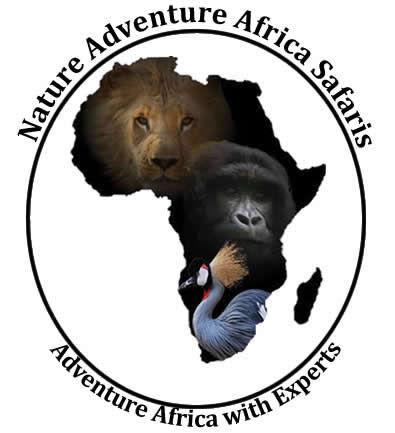
- 3 Days Gorilla Tour Uganda
- 4 Days Gorilla Trek & Lake Mutanda Holiday
- 4 Days Double Gorilla Tour
- 4 Days Flying Double Gorilla Uganda
- 5 Days Gorilla & Lake Bunyonyi
- 10 Day Photo Safari Uganda
- 12 Day Uganda Honey Moon Safari
- 13 Day Uganda Luxury Fly Safari
- 15 Day Uganda Photo Safari
- 19 Days Explore Uganda
- 8 Day Rwanda Safari Holiday
- 10 Day Rwanda Uganda Holiday
- 14 Days Travel Rwanda and Uganda
- 15 Day Primates Uganda Rwanda & Congo
Apoka Safari Lodge
Clouds Mountain Gorilla Lodge
Semliki Safari Lodge
- Baker’s Lodge
- Gorilla Forest Camp
- Buhoma Lodge
Ishasha Wilderness Camp
- Nkuringo Gorilla Camp
- Mutanda Lake Resort
- Pineapple Bay
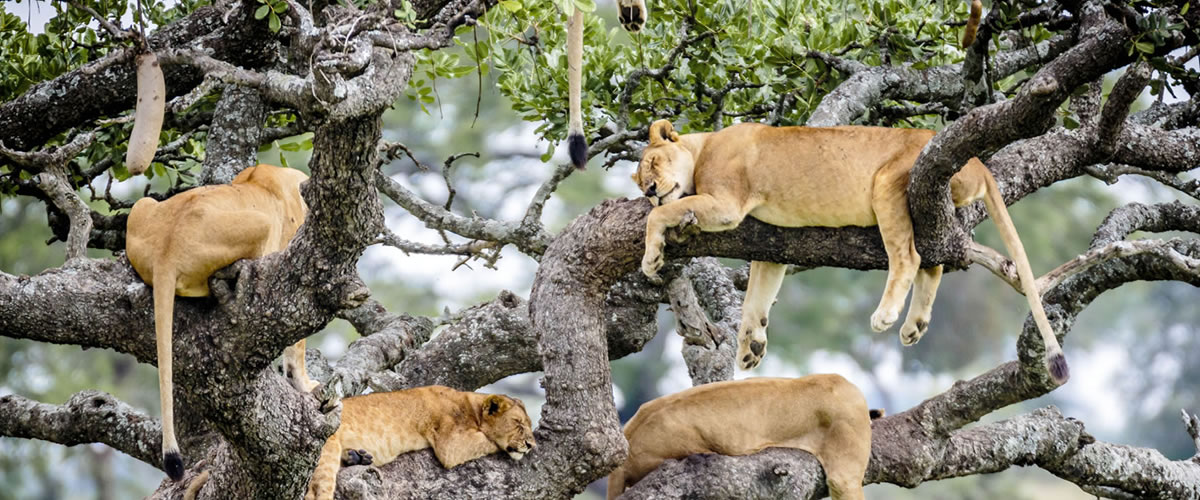
Meet Gorillas
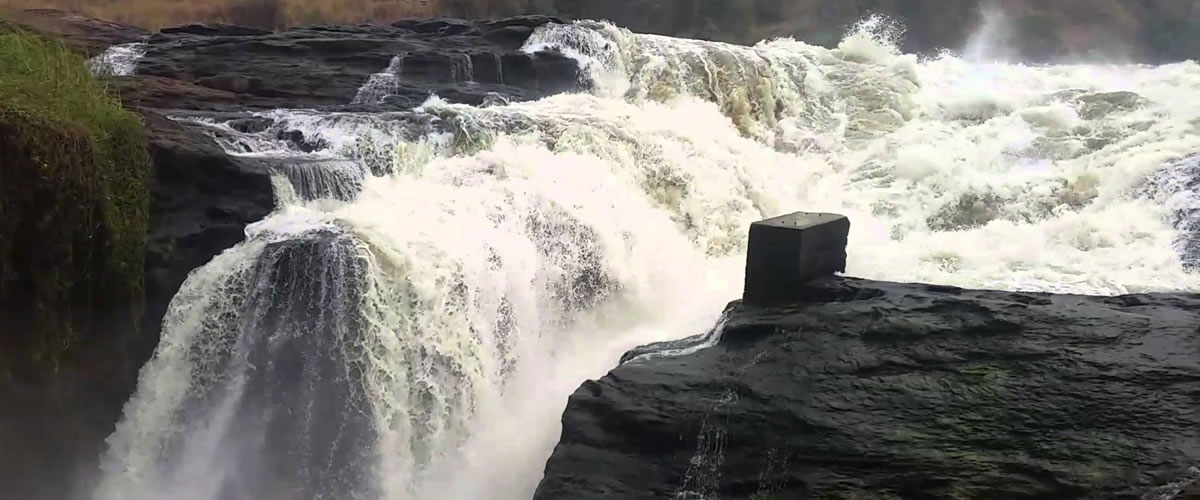
Feel Relaxed
on the Great Murchison Falls
Uganda Safaris, Gorilla Trekking Tours in Uganda, Rwanda and Democratic Republic of Congo!
Nature Adventure Uganda outfit offers the wildlife safaris and gorilla tours in Uganda, Rwanda, Democratic Republic of Congo. For over 09 years of experience organizing eco tours in Africa, we can help you customize your holidays. We tailor make the best sustainable tours in Uganda, Democratic Republic of Congo & Rwanda offering you the unforgettable experience.
Our African travel team can advise and arrange for you the best safari itineraries to book as we create based of you and us designing the best package that best fits into your travel. We also plan and create perfect packages that fit with your dates you want to spend more time in Africa.
Enjoy our wildlife and gorilla trekking tours in Uganda , Rwanda & Democratic Republic of Congo which are customized staying in the best eco – friendly lodges and exclusive camps near and in the national parks, you will have the unforgettable services from all the hospitality facilities. Our trips are guided by the best knowledgeable safari guides and all our clients are ride in the best customized safari vehicles offering great opportunity for African wildlife photography.
Our Top Packages
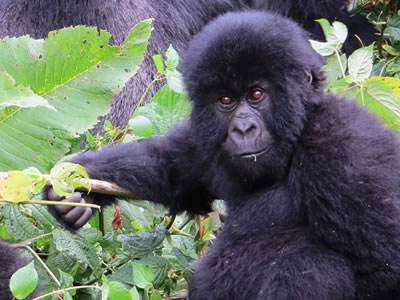
3 Day Gorilla Tour Uganda
The 3 day gorilla tour takes you to Bwindi impenetrable National Park, the tourist activities to encounter are the gorilla trekking tours, nature walks and community visit.
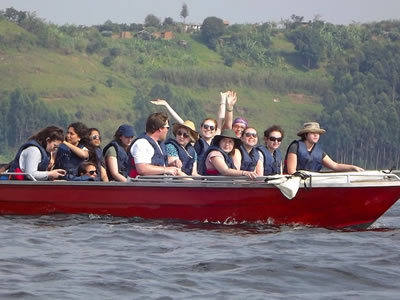
4 Day Gorilla Trek & Lake Mutanda
4 Day gorilla trek & Lake Mutanda holiday takes you to Bwindi, much known for the mountain gorilla trekking tours which supports nature tours in the area.
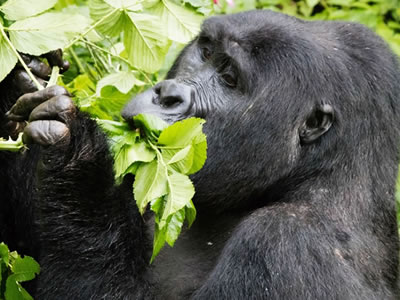
4 Day Double Gorilla Trekking Tour
4 Day double gorilla tour takes you to the Bwindi forest and on this Eco tour you will experience the gorilla trekking tours visiting the 2 different gorilla families in the mist.
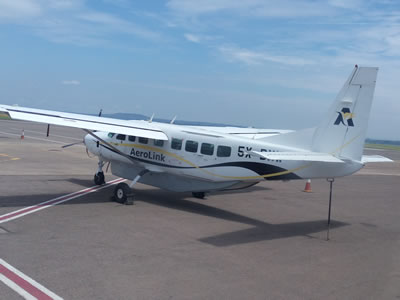
4 Day Flying Double Gorilla
The 4 Days flying double gorilla safari Uganda will take you to Bwindi impenetrable national park and this trip you will go by domestic flight.
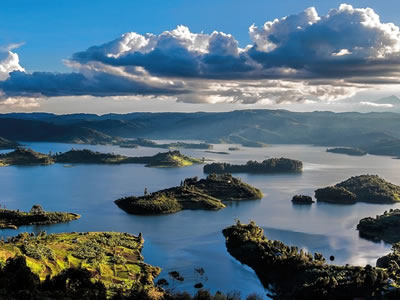
5 Day Gorilla & Lake Bunyonyi
The 5 days gorilla safari will take you to Bwindi forest and Lake Bunyonyi for your Eco trip visiting the gorillas and the holiday at Lake Bunyonyi.
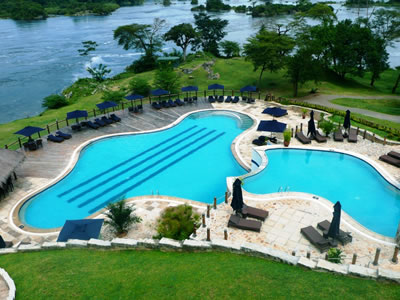
12 Day Uganda Honeymoon
12 Days Luxury Honey Moon Uganda safari takes you to the most loved Uganda wildlife and primate’s destinations like the Murchison Falls, Kibale Forest.
Uganda, is the Pearl of Africa and with various safari parks, reserves and sanctuaries you can take cross country safaris in Uganda and staying in beautifully set nature lodges and exclusive camps at the foot slopes and inside the parks.
We very much work with Uganda lodges and exclusive camps that blend with nature and offers paramount services to the travelers. Bit luxury, mid-range or budget lodge, we do not look for fancy setting but we take quality service to be the number one factor to have relationship with any facility.
Here is the list of the eco-friendly safari lodges and exclusive camps we trust to offer the best paramount in-house and out services to our clients.
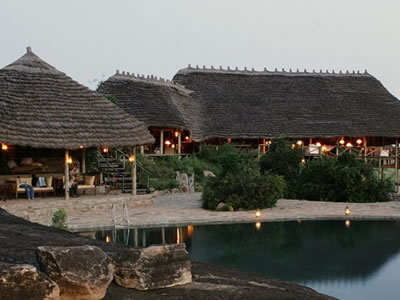
Built on a rocky kopje in the heart of the notable Kidepo National Park, Apoka Safari Lodge is absolutely the most eco-lux lodge in the northern part of Uganda. Read More
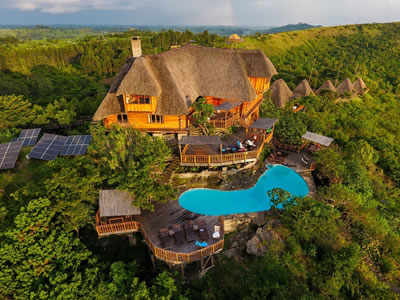
Kyaninga Lodge
Set against the stunning backdrop of the snow caped Rwenzori Mountains, Kyaninga is one of the few lodges that offer luxurious lodging services in Western Uganda. Read More
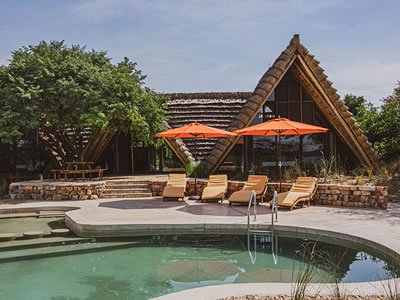
Nile Safari Lodge
Founded in 1993 by Zahid Alam, Nile Safari Lodge is one of the first tended lodges along the Nile River in Uganda. It is located in Murchison Falls National Park. Read More
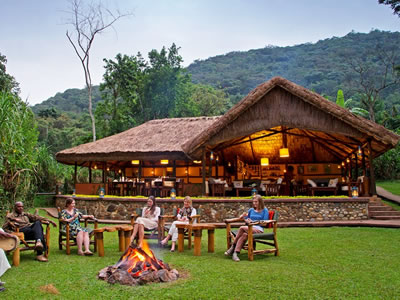
Sanctuary Gorilla Camp
Tucked away deep in the thick forest of Bwindi National Park, This camp is a 10-minute walk from the park headquarters. It is a great base for birding and Gorilla trek.
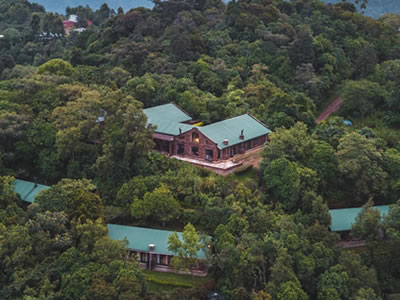
If you fancy a luxury treat on your Gorilla tour, this is for you. It offers panoramic views of the Great Rift Valley, wildlife and the towering virunga Volcanoes. Read More
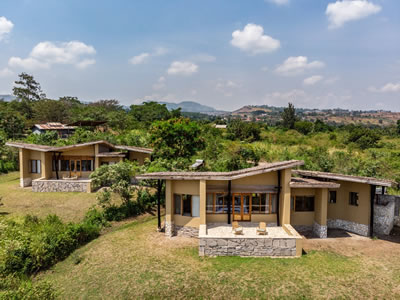
Kyambura Gorge Lodge
Located on the edge of Queen Elizabeth National Park, This facility feed guests with spectacular views of the sunken forest of Kyambura Gorge and rolling savannah.
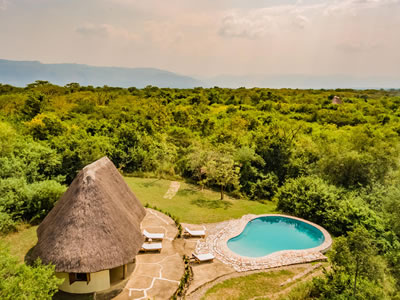
Situated in the heart of the Semliki, this permanent tented camp features eight tents raised on wooden platforms with spacious rooms and a private veranda. Read More
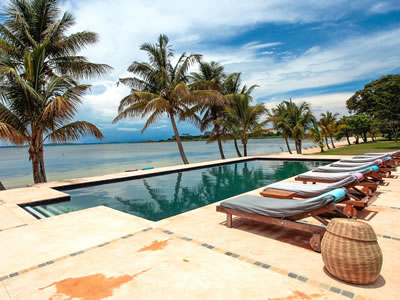
Pineapple Bay Resort
Welcome to Pineapple Bay, our island retreat. Take off your shoes, wrap yourself up in a nice soft kikoy and heed the wise words of the Pineapple Bay. Read More
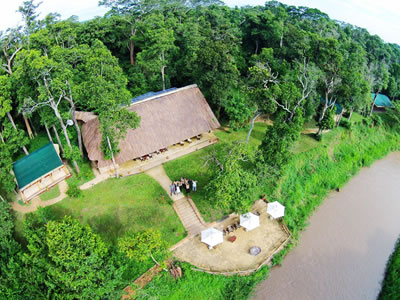
Ishasha Wilderness Camp is situated within the Southern Ishasha sector of Queen Elizabeth National Park on the Ntungwe river, and is an idyllic retreat for people. Read More
We list a few of them but if you are planning to go on a Uganda safari , contact our travel consultant and you will have the very safari itinerary of your choice and much more Uganda lodges can be customized on your Uganda holiday.
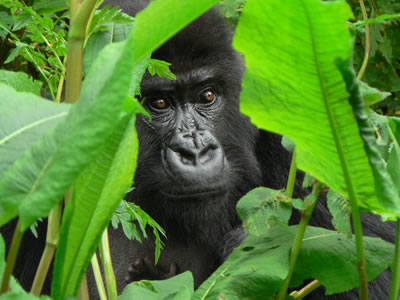
Gorilla Tours
We offer gorilla tours visiting Bwindi and Mgahinga Gorilla Parks, our gorilla tours are customized from 3-6 days or more depending on time that the client is staying in Uganda.
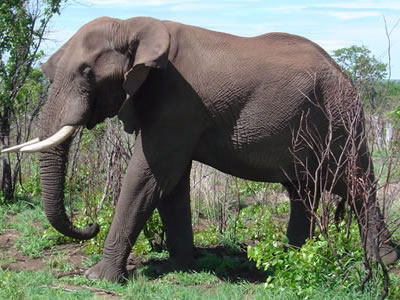
Uganda Safaris
We offer Uganda safaris and tours, our tours are customized visiting the primates, wildlife, culture and other sightseeing. Book our trip or we can tailor the trip with you to suit your desire.
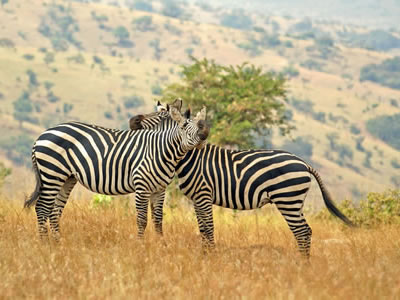
Combined Tours
We offer combined gorilla trekking safaris visiting the mountain gorillas in the 3 regions ( Uganda, DR Congo & Rwanda). Our gorilla tours can either start from Uganda, Rwanda or DR Congo.
Our Safaris
Nature Adventure Uganda outfit offers tailor made gorilla trekking, wildlife safaris, cultural encounters in Karamoja, mountain hiking, walking safaris, white water rafting in Jinja, bike riding, birding tours and combined photography Safaris in Uganda , Rwanda & Democratic Republic of Congo.
Our Services
Nature Adventure Uganda offers services for our clients like Car Rental Bookings, Hotel Bookings, Gorilla Permit Bookings, Flying Safaris in Uganda , give safari details to our clients for the better planing of their safaris, that is helping clients to choose the good itineraries which can suit their travel needs in Uganda and East Africa.
Nature Adventure Uganda outfit has a wide number of professional and experienced staffs composed of tour consultants, itinerary drafters and advisors, fluently English speaking safari guides of different products experiences.
Tony Myalo aka “Maata” – Tour Consultant – Nature Adventure Africa Safaris Ltd
Call +256-753-077-657 / +256-788-050-861 – What’s App
Tony Myalo aka “ Maata ” is born and raised up in Sanganzira, Buikwe District – Uganda. After his studies started taking domestic travels across Uganda and since then with his travel knowledge, love and passion turned it into career.
For the past 04 years he spent discovering Uganda, he acquired knowledge and started as a freelance travel content writer submitting to various travel guides like “ Africa Travel Journal ” and “ Eco Tours Guide ”. Later in 2018 he joined Nature Adventure Uganda outfit as travel consultant helping visitors exploring Uganda and East Africa tailor make suitable safari itineraries.
Nature Adventure Uganda outfit offers luxury, mid-range and budget travel trips in Uganda and East Africa and with his (Tonny) extensive knowledge can help you develop any kind of safari itinerary that best fits into your travel priority into East Africa.
Him having traveled extensively through Uganda and Rwanda, his always excited to show our visitors interesting tourist’s destinations and his selection of nature lodges will meet your travel desire. He is a fun for Chelsea Team an English football club and during his free time bit home or out of office on scheduled trips with our visitors he feels comfortable analyzing good and bad sides of the team.
Your Name (required)
Your Email (required)
Your Message
- Central African Republic
- Democratic Republic Of Congo
- Indian Ocean
- Republic Of Congo
- South Africa
- Latin America
- Galapagos Islands
- North America
- Polar regions
- Arctic Canada
- Australasia
- Gorilla Tracking
- Grizzly Bears
- Polar Bears
- Puma Tracking
- Snow Leopards
- Blue Whales
- Bengal Tigers
- Siberian Tigers
- African Lions
- Spirit Bears
- Lowland Gorillas
- Experiences
- Jungle Holidays
- Bush and Beach Combinations
- Conservation Travel
- Natural World Heroes
- Work with Us
- Consumer Protection Overview
- Privacy Policy
- Press and Awards
Client Reviews
- Expedition Leaders
- Specialist Leaders
- Expeditions for Change
- Journey to Natures Edge
- Country: Settings: Country:
- Currency: Currency:
- Call Us (619) 975-8082
- Destinations
- Gorilla Trekking
- EXPERIENCES
- Journey to Nature's Edge

Uganda Safaris
Rightly known as “the Pearl of Africa”, Uganda is a compact, rich and fertile country with endless unspoiled rainforest, roaring Murchison’s Falls and a rich honeypot of biodiversity. Uganda offers something entirely different to nearby neighbouring countries in East Africa and is a destination ripe with adventure. From the famed gorilla trekking Bwindi Forest National Park; watching Golden monkeys leap from branches in the Mgahinga Gorilla National Park; to viewing stunning cascades at Sipi Falls, Uganda is a real treat when it comes to African travel. Here, ten national parks protect half of the world’s mountain gorillas, along with chimpanzees, a multitude of monkeys and a classic safari checklist including leopards, lions, elephants and hippos. Where else in the world can you experience tracking the endangered mountain gorillas through the forests, and the same day find yourself on the plains in scorching heat searching for the elusive tree climbing lions?
Tourism is relatively new, and as such Uganda does not have the extensive infrastructure of the aforementioned countries, but what this country does offer is authenticity, fewer crowds and a lot more variety than one would expect in its own individual way. Winding roads lead to places of grand beauty and unique cultures for those who dare to explore. There’s a story at every turn, from wildlife to culture and especially from locals, who are renowned for their warmth and charm.
Why NWS for your Uganda Safari?
NWS originally started as World Primate Safaris back in 2005; when it comes to primates we are the experts with a long history of sending clients on transformative gorilla tracking expeditions . Our team of destination specialists have extensive experience tracking gorillas and thanks to our in-depth knowledge of the gorillas and what constitutes a top-class gorilla tracking safari, we are recognised as one of the leading authorities in gorilla tourism, awarded by both Travel+Leisure and Conde Nast for our expertise in this area. Our exclusive safaris dig a little deeper than the norm. We can include scenic helicopter transfers offering a remarkable bird’s-eye view of this endangered habitat. Working closely with conservationists, we can offer the change to join habituation safaris and more. Limited to just two gorilla families in the southern part of the Bwindi Impenetrable National Park, you can enjoy the rare opportunity to spend a full day in the company of conservationists and researchers.
How Much Does Uganda Cost?
For a 6-day safari in Uganda, we recommend a starting price of £6,000 per person. This will generally include gorilla permits, accommodation and private guides. If you are looking to stay in some of Uganda’s most iconic and best loved lodges, you’ll need to increase the budget to £20,000 per person including private helicopter transfers, multiple gorilla permits and private guides.
Contact us for a bespoke quote
Safaris & Planning

Classic Uganda Safari
Explore the awe-inspiring lands of Uganda in this small group itinerary; track the mountain gorillas, chimpanzees and the famous tree-climbing lions.

Luxury Uganda Safari
Spend your time in Uganda immersing yourself in a true primate focussed safari, staying in the best accommodations on offer. Begin with your chimpanzee tracking experience before heading to the famous Bwindi Impenetrable National Park.

Short Uganda Safari
With only a short time to get away, this is the perfect trip which you will always remember. Fly inyo Entebbe and straight onto Bwindi Impenetrable National Park so you can start tracking the gorillas the next day.

Talk to a Uganda Specialist Today
The uganda safari experience.
Staying purely within this landlocked country, a Ugandan safari can now completely cater to your needs without you needing to go further afield. A good week to ten days can afford you gorillas, chimpanzees, and savannah game, negating the need to travel further afield and keeping costs within reason. On your travels you will meet and discover one of the friendliest populations on the African continent, hospitable, generous, and forgiving. As well as exploring the vast wildlife highlights on your Uganda safari, make sure you spend time to stop, listen, and enjoy the hospitality of the Ugandan people themselves.
You may wish to include the following in your Uganda itinerary:
- Mountain Gorillas - Undoubtedly the highlight of the destination, and the reason for most visitors, is to track the endangered mountain gorillas .
- Savannah Game - Here, you can experience traditional safaris alongside the gorilla tracking, spotting the big five and the big cats.
- Tree Climbing Lions - Unlike most African destinations, here you can see lions relaxing in the shady trees rather than underneath them!
- Incredible Combination s - Uganda’s location makes it perfect for combining with lots of other African destinations, including Rwanda, Kenya, Tanzania and beaches.
- Track Chimpanzees - Track the chimps of Kibale Forest and Kyambura Gorge
- Boat Cruise - Enjoy a boat cruise on the abundant Kazinga Channel
- Conservation - Spend time with a doctor from the Mountain Gorilla Veterinary Project
Where to stay in Uganda?
Standards vary in Uganda from smaller intimate lodges to luxury eco-lodges, as tourism is relatively new in Uganda and accommodation range is more limited than some other African destinations, with many of the lodges being located near or in the heart of th National Parks to offer close proximity and ease of access to wildlife. Read more about where to stay in Uganda.
When to go?
The best time to visit Uganda depends on the wildlife you'd like to see as the climate is good all year round. Average temperatures in Uganda are around 21.5°C or 71°F, dropping to a minimum of 12°C or 54°F at night time, with altitude also affecting this. Being on the equator, rainfall ranges between 1,000 and 2,000 millimetres each year, but depending on time of year these can be short bursts which give rise to clearer skies. Read more about when to go to Uganda.
A Guide to Wildlife Encounters in Uganda

Where To Go

Where To Stay

Planning & Inspiration

Gladys Kalema-Zikusoka
A leading conservationist, Veterinarian, Founder and CEO, Dr Gladys Kalema-Zikusoka has always loved animals.

Ndali Lodge
Ndali Lodge is a fantastic traditional colonial lodge set in the stunning crater region of Western Uganda. Built of local stone and thatch, the 8 luxury bandas offer views over the dramatic Rwenzori Mountains; each banda is en-suite with a private veranda. The dining room and lounge offer relaxing views over the crater lake below.

Bwindi Impenetrable National Park
Supporting nearly half of the world’s estimated 820 mountain gorilla population, Bwindi Impenetrable National Park is situated along the Great Rift Valley. As the name suggests, it is an area of almost impassibly dense rainforest spread over a network of valleys and ridges, carving a silhouette of undulating peaks into the skyline. Dating back over 25,000 years, this is one of Africa’s oldest and most captivating parklands; its bamboo and swamp forests provide the ideal environment for the gorilla population that call it home.

Jinja and the Source of the Nile
On the shores of the River Nile and huge Lake Victoria, Jinja is Uganda’s fourth largest town, having once been the capital city. Its tropical atmosphere and lush vegetation are big attractions, but the main highlight is undisputedly the River Nile. Thought to be the home of the source of the Nile, the world’s largest river spanning Egypt Sudan and Uganda, it holds major spiritual significance for the local people and offers some thrilling grade 5 rapids for us visitors.

Primates are where we started over 15 years ago. Specialising in primate safaris worldwide we were the sole global specialists in this field. While we've come a long way since, now covering 42 destinations around the globe, encounters with our primate relatives remain close to our hearts.
What to Expect from a Trip to Uganda?

This trip was a 10/10 experience! It was well organised and I really loved the gorilla treks which I am glad to have done two of.
This was a 10/10 trip! The accommodation was the best ever, an amazing lodge! We were really well supported by all involved in our trip and we never had any issues.
We had an excellent trip! Everything was well organized, with great destinations and fantastic lodging.
David worked hard to organize the trip so that it flowed smoothly for me and I had some amazing opportunities to photograph wildlife.
It was very good and thorough. Thanks for setting up a wonderful trip David! The food on this trip, especially at the Kicheche camps, was soooo wonderful. It was a really great trip and we had many, many highlights. It was really amazing and we definitely want to come back and see this beautiful place called Africa again someday!
Uganda Safaris FAQs
What wildlife can i see in uganda.
A relatively small country, Uganda landscapes are intense which means its wildlife offering is unexpectedly large. Some of the wildlife you can expect to see include:
- Mountain gorilla
- Chimpanzees
- Monkeys (including baboons and golden monkeys)
- Birds (over 1,000 species live in Uganda)
Check out our Uganda wildlife guide for more information on the incredible animals that populate the country.
What languages are spoken in Uganda?
Uganda is a linguistically diverse country with over 40 languages spoken across its various regions. Whilst English is the official language of Uganda and used in government, education and business, some of the other major languages spoken in Uganda include:
- Runyankole-Rukiga
What injections do I need to go to Uganda?
Before travelling to Uganda, it's advisable to consult a travel health professional for personalised guidance on vaccinations. Generally, vaccinations recommended include Yellow Fever (required for entry), routine vaccinations like MMR and DTaP, Hepatitis A and B, Typhoid, Meningitis, and Polio. Due to the risk of malaria, consult a healthcare provider for antimalarial medication and follow preventive measures. Consider vaccinations for Rabies if interacting with animals and discuss cholera vaccination if relevant. Ensuring up-to-date vaccinations and adhering to health precautions will help safeguard your well-being during your trip to Uganda.
What to do before going to Uganda?
Before travelling to Uganda, make sure your passport is valid and apply for a visa if required. Purchase comprehensive travel insurance, understand local customs and etiquette, and stay informed about travel advisories.
Can you brush your teeth with tap water in Uganda?
It is generally recommended to use bottled or purified water for brushing your teeth in Uganda, especially if you are not accustomed to the local water supply. While some urban areas might have treated tap water that is safe for locals to use, the quality of tap water can vary, and travellers may be more susceptible to waterborne illnesses.
Request a Brochure
Please complete all required fields!
Saved Tours
{{item._source.name || item._source.title}}.
- local_phone +44 (0) 1962 733051
- Our Holidays
- Brochures and Newsletters
- Tour Leaders
- Job Vacancies
- Complete Financial Protection
- Book a Naturetrek speaker
- The Naturetrek Reserve
- Naturetrek's History
- Private Groups
- Sustainable Tourism
- Destinations
Wildlife Holidays in Uganda

Uganda is a beautiful country, where widespread, lush, green vegetation flourishes on fertile soil. Sir Winston Churchill was so impressed during his 1907 visit that he was inspired to write ‘My African Journey’ and declared it a “fairy tale” kingdom. Similar in size to the UK, it borders Kenya, Tanzania, South Sudan, Rwanda and the Democratic Republic of Congo. Until 1962, when it gained its independence, Uganda was a British Protectorate.
It then endured years of turmoil which ended in 1986, and has since become one of the most peaceful and stable countries in the area. Fairly new on the East African tourist scene, it’s making a name for itself as the Pearl of Africa – a destination not to be missed!
Although landlocked, the dense cloud forests, large lakes, tropical forests, rivers and open savannahs provide a great variety of habitats for a range of abundant wildlife. Highlights of a visit to this stunning country will surely include the prehistoric looking Shoebill Stork, tiny jewel-coloured kingfishers, comical Red-tailed Monkeys and, of course, the powerful great apes: Chimpanzees and Mountain Gorillas.
Speak with our Uganda specialist

Featured Tours to Uganda

Uganda - Mammals and Mountains

Uganda - In Search of the Shoebill


Tailormade Holidays in Uganda

Our Specialist Recommends
"Our ‘Uganda – Mammals & Mountains’ holiday is a 14-day wildlife safari in search of mammals, particularly the primates of Kibale Forest and Queen Elizabeth National Park. Of course the highlight is the chance to see the Mountain Gorillas in Bwindi Impenetrable Forest."
Naturetrek Tours to Uganda
Naturetrek’s wildlife holidays in Uganda offer the chance to search for the country’s mammals, particularly primates, and birds. These include the Mountain Gorillas of Bwindi Impenetrable Forest and the Shoebill Storks of Mabamba Swamp.
Whats special about its wildlife?
Uganda remains a most beautiful country – a luxuriant land of great lakes, abundant swamps, a snowclad equatorial mountain range, and rolling grasslands.
Above all, it is the country’s tropical forests that provide the greatest attraction for the naturalist. Here, among an unrivalled population of primates, are over 300 Mountain Gorillas.
Some highlights include:
- Relaxing boat trip on the Kazinga Channel
- Explore the tropical rainforest of Kibale where 70 mammal species and over 350 species of bird have been recorded
- Game drives in Lake Mburo and Queen Elizabeth National Parks
Related articles
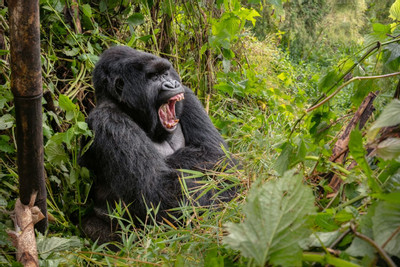
To see a Gorilla in the wild is the privilege of a lifetime. Many people yearn for the opportunity, but only a few ever manage it. Happily, though, there are places in the world where it is possible to spend time watching Mountain Gorillas, the largest and most magnificent of these apes, and one of those is Uganda.
Quick enquiry

Quick Enquiry
- Eastern Africa
- Northern Africa
- Southern Africa
- Western Africa

13 Eco-lodges in Uganda Mending Broken Hearts Through Nature
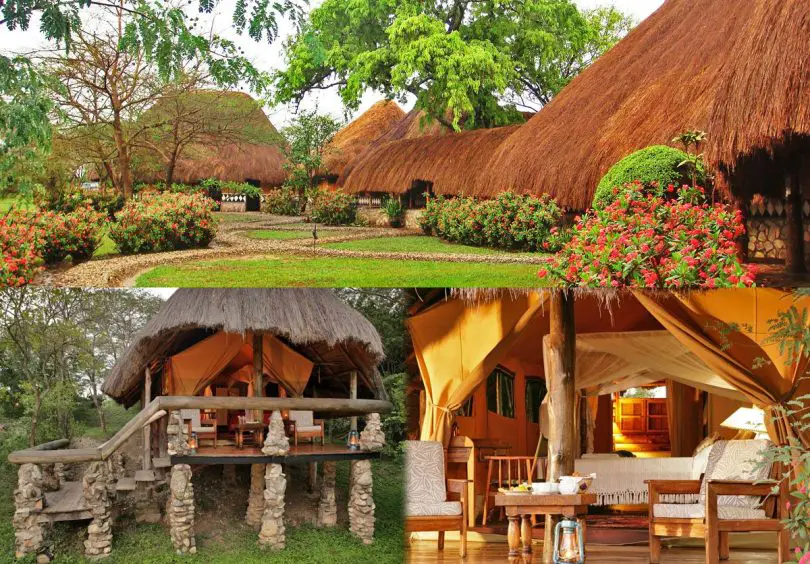
Looking for a way to experience both environmental friendliness and luxury in Uganda? The pearl of Africa is a great place to visit if you’re looking for the best eco lodges in Uganda. There are many such establishments whose priority is a sustainable environmental system tied to luxury and relaxation .
These lodges are committed to sustainable tourism practices, meaning you can enjoy your vacation without harming the local environment. Plus, they offer all the amenities and comforts you would expect from a top-notch lodge, so you can truly relax and rejuvenate during your stay. Here are some of the best of such in Uganda that you can enjoy while exploring this beautiful country.
Table of Contents
Apoka Safari Lodge

Apoka Safari Lodge. Photo/Inside Kidepo.
Nestled in the heart of Uganda’s wilderness, Apoka Safari Lodge is one of the best eco lodges in the country. The lodge is built on a hillside overlooking a savannah plain, and guests can enjoy stunning views of wildlife from their rooms.
The lodge is completely solar-powered, and all of the buildings are made from sustainable materials. With everything handmade by local craftsmen, you’ll never want to leave this natural oasis. Guests can go on game drives to see lions, elephants, and other animals in their natural habitat or take a walk through the lodge’s beautiful gardens.
2. Semliki Safari Lodge

Semliki Safari Lodge. Photo/Twitter.
Semliki Safari Lodge is superb. The lodge is located in the heart of the Semliki National Park, making it an ideal base for exploring this unique and bio-diverse region. It’s made up of sustainable materials and renewable energy sources.
The rooms are large canvas tents with permanent thatched roofs, and the interior of each room is made of a hand-carved four-poster bed draped in muslin. Each veranda has a private panoramic view complimented by a pool that overlooks the Blue Mountains of the Congo.
3. The Rainforest Lodge – Mabira
Set in the Mabira Forest, this establishment boasts a tranquil atmosphere for travellers wanting to experience an authentic Ugandan rainforest. All materials used to construct the lodge are sourced locally from the surrounding area, giving visitors a one-of-a-kind look into Uganda’s natural resources.
Other amenities available at the lodge include a canopied bar with daily cocktail specials, a Restaurant and an open lounge – providing ample seating for your comfort.
4. Jacana Safari Lodge

Jacana Safari Lodge. Photo/Sun Safaris.
With rooms that offer picturesque views of the lake and plenty of space for guests to spread out, this tree house lodge is perfect for those looking to get away from it all. The cottages are set in the dense Maramagambo forest at the edge of one of the park’s crater lakes for a truly unique experience. With a design scheme made of natural materials like wood and rope, it’s the perfect place to escape civilisation and return to nature.
5. Aramaga Rift Valley Lodge
The Aramaga Rift Valley Lodge is situated at the foot of the Rwenzori Mountains. The lodge was built with sustainability in mind and features several eco-friendly features. Aramaga Rift Valley Lodge is also heavily involved in conservation efforts, working with the local community to protect the environment.
6. The Haven Eco River Lodge
The Haven is a peaceful, relaxed and well-maintained; thus among the best eco lodges in Uganda. Enjoy the calmness and breathtaking views over the starting point of rafting at the River Nile.
The Haven Eco River Lodge is ideal because of its environmental credentials. The lodge is solar-powered, providing 24-hour electricity and hot water for the showers. They source their water from a 20-meter-deep borehole.
7. Mount Elgon Ecolodge
Mount Elgon Eco lodge is situated on the slopes of Mount Elgon, in a region of outstanding natural beauty. This Eco lodge is also heavily involved in conservation efforts, working with the local community to protect the environment. The lodge offers several hiking and safari experiences, allowing visitors to explore the stunning scenery and wildlife of the area.
8. Ngamba Island Chimpanzee Sanctuary
Ngamba Island is home to a sanctuary for orphaned and displaced chimpanzees. The sanctuary was established to conserve these endangered species and is heavily involved in conservation and education efforts. Visitors to the sanctuary learn about the work being done to protect chimpanzees and also have the opportunity to meet and interact with the resident chimpanzee population.
9. Gorilla Forest Camp
Located just 500m from the entrance of Buhoma Park, Gorilla Forest Camp is beautifully designed and set in a lush forest glade. The camp’s tents are thoughtfully set up to blend in with their atmospheric surroundings of misty valleys and the looming mountain range that protects this delicate ecosystem.
Each tent has an en suite bathroom with a tub, running water, and other amenities. They also have spacious verandas where guests can enjoy the views and meals in privacy. The atmosphere is that of a rainforest, which inspired Disney’s The Jungle Book animation. Now you know why it ranks among the best eco lodges in Uganda.
10. Zebi Ecolodge
Zebi Ecolodge is an upmarket lodge situated in the Nyungwe Forest National Park. The lodge was built to provide visitors with a unique experience that would allow them to feel close to nature, while also supporting the local community and conserving the environment.
Zebi Ecolodge works closely with the local community, employing members of the nearby village and using locally sourced materials for construction where possible.
11. Kigambira Safari Lodge
Located in lake Mburo National Park, Kigambira Safari Lodge is one of the best eco-lodges in Uganda. The lodge offers stunning views of the park, and features a swimming pool, restaurant, and bar. Kigambira Lodge also has a fleet of safari vehicles, which guests can use.
12. Kyaninga Lodge
Kyaninga Lodge is an upmarket lodge situated on the edge of Kibale Forest National Park. The lodge provides visitors with a unique experience that allows them to feel close to nature. Kyaninga Lodge also has several initiatives in place to support conservation efforts. These include using solar power and rainwater harvesting and offering guests the opportunity to plant trees in the forest.
13. Serenada Eco Resort
Serenada Eco Resort is on the shores of Lake Victoria in Mukono District. It is the nearest ecological resort to Kampala. Its main features include two tropical forests, four beautiful gardens, and a beach that guests can enjoy. The objective of Serenada is to conserve nature. For nature lovers, the resort is a home to over 220 species of birds, rare butterflies and wild animals.
You may also like

35 Liverpool Coaches Are in Nairobi for Coaching...

5 Most Romantic Places in Zambia for Couples to...
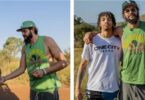
Highlights of Former NBA Star Joakim Noah South...
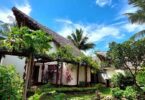
5 Best Island Villas in Zanzibar 2024 to Spend the...

JW Marriott Nairobi Opens its Doors to the World
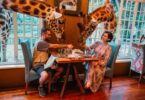
6 Best Places to Propose in Nairobi this Easter Weekend
About the author.
Besigye is a Ugandan writer and a teacher by profession. She loves adventure and travelling that's why she loves writing travel blogs.
Leave a Comment X
Save my name, email, and website in this browser for the next time I comment.
- +250 780-870-670
- +250-780-870-670
- +256-781-960-154
- [email protected]
- Online Payments

Guided Nature Walk Tours in Uganda
Guided Nature Walk Tours in Uganda: Every safari in Uganda now includes walking safaris as a key component. Many visitors to Uganda prefer to combine walking safaris with other excursions like gorilla trekking , chimpanzee trekking, boat cruises, and game drives. The list below might provide you with some options if you wish to go walking while visiting Uganda, and we can take you there.
Because Uganda is blessed with such beautiful natural wilderness, nature treks, and walks are among the most enjoyable safari activities. A self-directed activity that connects you to nature is taking a nature walk. In contrast to other activities for observing wildlife, it provides a true rainforest experience. To get close to the wildlife in its natural habitat, you follow the same pathways that it uses. National parks are home to the majority of the nature walk trails listed in this article.
Depending on a person’s preferences, various constructed nature walk pathways in the woodlands and other private community projects are as exciting. This will constantly be on your schedule. As a result, when you travel with us, your possibilities for exploring and enjoying Uganda are not limited.
Guided Nature walk Tours in Uganda.
Hiking to the Top of the Falls in Murchison Falls National Park.
One of the park’s most spectacular attractions for visitors who explore the Murchison wilderness is the hike to the top of the falls. The hike lasts for about 45 minutes and is moderately difficult for most people with average fitness.
Trekking to the top of the falls is regarded as the most spectacular track in the park since it takes you from the bottom to the top of the massive Murchison Falls, or vice versa. It can begin with a boat ride upstream from Paraa to the bottom of the falls, where you will disembark and stroll for 45 minutes. The trek follows the cascade through a wooded slope with wonderful views of the waterfalls, undulating hills, and various flora types such as woodland up to the summit of Murchison Falls .
This encounter engages all of your senses as you see the Nile River squeeze through an 8-meter-wide gorge and plunge 45 meters over the residual rift valley walls, producing the Murchison Falls with a roar.
Quick treks can also be started from Mubako Junction or Sambiya River lodge on the southern side and Paraa on the northern bank, both of which pass across the Emmy River. These 1-2-hour walks are mostly intended for birders and nature enthusiasts.
The enormous Murchison Falls and the booming symphony of the streams will fascinate you on this journey. Murchison Falls National Park, which spans 5,072 square kilometers, was established in 1952. Located at the northern end of the Albertine region, it is the oldest and largest park in Uganda and is home to over 451 different bird species as well as over 76 different species of mammals.
Guided Nature Walk Tours in Kaniyo Pabidi and Rabongo Forests- Murchison Falls National Park
The Kaniyo Pabidi forest is situated close to the Kichumbanyobo park gate on the southern side of the Murchison Falls National Park . Also, the tropical riverine vegetation-dominated southern edge of the conservation area contains 4 square kilometers of the Rabongo forest. Primates like chimpanzees can be seen when trekking through these two kinds of wood, primarily in Kaniyo Pabidi, which has a habituated troop that can be followed.
To name a few, other primates to see are Olive baboons, Grey-cheeked mangabeys, and Red and White colobus monkeys. While mammals include the Warthogs, Buffaloes, Forest elephants, and Duikers, as well as bird viewing due to the presence of the Albertine Rift endemics and other different bird species like the Secretary Birds, the Marabou Stork, Abyssinian Ground Hornbill, Black-bellied, Bustards and the Open-billed Storks, Dark Chanting-Goshawk, Martial Eagle, Hugli’s Francolin, Denham’s Bustard, Spotted Thick-knee, Black-headed Plover, Senegal Thick-knee, Rock Pratincole, Long-toed Plover, Black-billed Wood-Dove, Veracious Dove, Long Tailed Nightjar, and the Standard-winged Nightjar.
Guided Nature Walk Tours in Kibale Forest.
A nature walk in Kibale allows you to discover the most beautiful and diverse tracts of a tropical forest in Uganda, which has 350 tree species. Kibale National Park is located in western Uganda and covers 795 square kilometers. It is well-known for having the largest density and diversity of primates. The chimp is the most famous of Kibale’s 13 primate species, having about 1450 individuals. The forest also supports around 71 animal species and over 370 bird species. The park provides fun-filled nature walks routes for both day and night-guided nature walks thanks to its diversified resource.
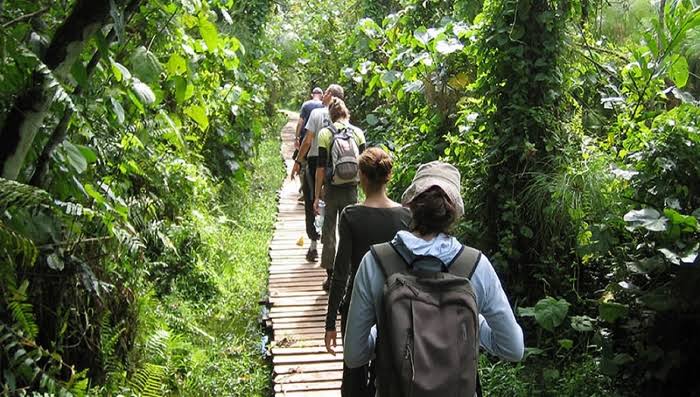
Primate Walks
Primate hikes (Chimpanzee tracking), this day nature walk gives you the opportunity to see the Kibale specialties “chimpanzees” in their native environment, with a good probability of finding habituated groups.
This intriguing trip begins with a briefing at the Kanyanchu tourist center, with three schedules available: morning, mid-morning, and afternoon, each lasting roughly 2-5 hours. Together with chimp trekking , visitors frequently see primates such as the localized red colobus monkey, L’hoest monkey, and white colobus monkey. A habituation experience, on the other hand, allows you to join researchers as they monitor chimps leaving their nests, nursing, hunting, eating, copulating, resting, patrolling, and displaying until the time comes for them to build new nests in the evening.
Bigodi Swamp Walk
Bigodi swamp walk is an 11-kilometer track that leads to the greatest birding locations. Rare species that may be seen on this boardwalk route include the rear green-breasted pitta, which is only found in Kibale, the big blue turaco, the White-winged Warbler, the Papyrus Canary, the Papyrus Gonolek, the White-collared Olive back, and many others.
While chimps and other forest dwellers sleep at night, nocturnal animals become extremely active. The night walks begin at 7:30 p.m. and run for around 1-2 hours, with the use of bright torches as you wander through the dark forest in search of nocturnal wildlife. The Cricket, Bushbaby, Potto, Nightjar, Tree hyrax with its frightening cry, and the rare civet are among the most common species.
Guided Nature Walk Tours in Semiliki National Park.
A nature walk or trek in Semuliki is a must-do activity for any visitor who wishes to get near to animals without going on a game drive. The park is located near the Uganda-Congo border, along the important Fort Portal-Bundibugyo route, and is heavily forested.
Hikers will enjoy the park’s small paths surrounding the Sempaya, Kirumia, and Red Monkey Track, which are designed for nature enthusiasts and birders.
The Sempaya trail is an 8-kilometer climb that takes 2-4 hours and leads to Semuliki’s most attractive and famous attraction: the “Male (Bitende) and Female (Nyasimbi)” hot springs. Many primates, including Red-tailed monkeys and Grey-cheeked mangabeys, may be seen along the journey.
The Kirumia trail is ideal for birds and butterfly watchers. It is a 13-kilometer (about 8-hour) trip in the middle of the forest towards the river Semiliki. This trek is best rewarded with overnight camping, despite the good day experience.
The primate trail, also known as the red monkey trail, begins at the Sempaya tourism site and extends to the park’s eastern boundary, up to the Semuliki River. It has a total length of 11 kilometers. This route allows you to see the endangered De Brazzers monkey.
Guided Nature Walk Tours in Queen Elizabeth National Park
A nature walk at Queen Elizabeth National Park is an active way to experience Uganda’s second-biggest park on foot. The Mweya Peninsular, Maramagambo woodland, Kyambura gorge, and the Ishasha River are among the greatest trekking areas in the park.
Guided Nature Walk Tours in Bwindi Impenetrable National Park.
The Bwindi Impenetrable Forest in southern Uganda is well renowned for housing Uganda’s greatest attraction, the Mountain Gorilla . These big apes are uncommon and endangered, residing in the Virunga transboundary massif, which is shared by the Bwindi forest and the neighboring Virunga volcanic summit.
This park is not only for gorilla trekking excursions; it also provides nature treks that immerse you in the most beautiful tropical rainforest. Throughout the park, there are several paths that alternate between being moderate and demanding. They will take you to beautiful waterfalls and other spectacular sights of the Virungas and the Albertine Rift Valley.
Guided Nature Walk Tours in Mgahinga Gorilla National Park.
Nature hikes and trekking go hand in hand at Mgahinga Gorilla National Park. This park is located high in the clouds, at an elevation of 2000 to just over 4000 meters, and encompasses three slopes of the Virunga volcanoes : Muhuvura, Gahinga, and Sabyinyo. The park is located in the country’s southwest region, bordering Rwanda’s Volcanoes National Park and Congo’s Virunga National Park. This common area preserves over half of the world’s mountain gorilla population, as well as other creatures and birds.
Trekking around the slopes of these extinct conical volcanoes allows travelers to see forest bird species, various montane flora kinds, Rugezi marsh, and neighboring lakes with wonderful views of agricultural businesses, Guided Nature Walk Tours in Uganda
Guided Nature Walk Tours in Lake Mburo National Park.
Nature walkers can explore the entire Lake Mburo National Park. A game ranger and guide will accompany you on your excursion. Starting from Rwonyo, the park center, these guided treks take you to the salt lick, where the flavor of the salty rocks attracts animals. They may be seen from a wooden observation deck.
Another walk is held on the western side of Lake Mburo, and it normally starts at 7:00 a.m. and lasts two hours. There is a good probability of encountering hippos on a lake retreat and hyenas returning to their caves.
Best Time for Guided Nature Walk Tours in Uganda.
A walking safari in Uganda is perfect during the dry season. The two dry seasons are December to February and June to July. The roads become practically unusable during the wet season (March to May and August to November), and animal-watching expeditions are severely limited.
Finally, Uganda is truly blessed by nature. It is a perfect destination for visitors on a Uganda safari especially those who are looking to adventure, engage with nature, and explore the country’s various national parks.


- Executive Comittee
- Job Opportunities
- Sites & Habitats
- Raptor and Vulture Monitoring
- African Waterfowl Census
- Bird Population Monitoring
- Important Bird Areas
- Working Groups
- Public Lectures
- Current Projects
- Other Projects implemented
- Policy Briefs
- NewsLetters
- Latest News
- Upcoming Events
- +256 414 540719
- [email protected]

- Conservation and Development

Using eco-tourism as a wise use strategy to promote the conservation
Using eco-tourism as a wise use strategy to promote the conservation of wetland biodiversity: What do we learn?
Nature Uganda has promoted ecotourism as a conservation tool in many sites with successful results. Ecotourism refers to a type of tourism where the environment, local community and visitors all benefit without imposing a negative impact to the environment. It is a niche that conservationists use as a marketing tool to promote any form of tourism that is related to nature. This form of tourism ensures that natural areas are conserved and at the same time the well being of local communities and the general public are improved. The conservation status of wildlife and habitats they are found in can be enhanced if they are appreciated, valued and seen to be a major contributor to income by the public. This encourages the local communities to become major stakeholders in conservation efforts through such ventures.
Some key learning experiences:
There is no one clear cut model of an eco-tourism venture that can be recommended. The most important is to follow the general principles of community-led ventures. Most important are the group formation and related management structures, membership, records and record keeping, revenue collection and benefit sharing, transparency and participation of members. Aware that eco-tourism is a tool whereby people are encouraged to promote actions that conserve nature, the community needs to be empowered to achieved that. It combines conservation, aspirations of local communities and sustainable use of nature.
The model can take examples from Bigodi wetland community experience that was supported by various institutions. This community initiated conservation of a wetland in proximity to a National Park. With opportunities offered by tourists visiting the Park, the community realized that venture was a worthwhile initiative and the embraced it. The benefits are ploughed back to the community through various projects such as water, schools and up scaling income generating activities. This takes into account the local population there by minimizing negative impacts on the host community because otherwise the local population may come to dislike the presence of the venture and this could undermine its long-term prospects.

Nature Uganda supported Katwe Tourism Information Center (KATIC) in promoting tourism in Munyanyange Crater Lake and Katwe as a whole. The groups’ activities include education to schools, Tailored Talks to tourists, Environmental Education amongst others. There are specialized areas and of importance is playing the care taking role of Munyanyange wildlife sanctuary. The take home is that eco-tourism alongside education should emphasize education among all parties, from local communities to tourists. This will emphasize local conservation through efforts mobilized locally.
Opportunities present themselves differently. Eco-tourism initiatives therefore should be able to identify such opportunities and turn them to realistic ventures. At Nabajjuzi, the “Sitatunga Conner” as it is known aimed at promoting community participation in wetland conservation on realization that the site presented unique features. It presented the best opportunities to view the Sitatunga and the Shoebill, both species are sought after by tourists. The site is also a major route to most National Parks and the Albertine Rift rich biodiversity hot spots. Emphasis is on local participation and this maximizes the early and long-term contribution of local people in the decision making process, kind of enterprises and of the method of general operations. Local involvement is a significant element of sustainability.

Fox’s weaver
In the next few years, Bisina and Opeta wetland system shall be the destination point for tourists especially birders. This is the only area with the only Ugandan Endemic Bird Species the Fox’s Weaver. However, experience shows that developing an eco-tourism venture takes time. It requires dedication and commitment of both the communities and the local leadership. It is important for the host population to realize some economic benefits from ecotourism without which, the host community will have little reason to positively accept the initiative and protect the environment upon which tourism depends. The fact that ecotourism is mostly found in designated protected areas means that eco-tourism will also thrive where environmental regulations are adhered to and this may be major threat.
For eco-tourism ventures to succeed, all the necessary structures and facilities need to be in place. This includes but not limited to infrastructure, transport, and services that will ensure successful execution of tourism activities in wetland areas. The activities need to be well planed for maximum satisfaction of the visitor. Marketing of the site and activities are key elements that need to be continuously done. However, traffic needs to be controlled to avoid negative effect on both vegetation and fauna through removal or disturbance or accidents. Such impacts can be reduced by additional financial levy related to prevention, protection and habitat restoration. Significant conflicts related to inequitable sharing of benefits arising from the use of wetlands by tourism can be handled through group conflict resolution processes.
Conclusions and recommendations:
Eco-tourism is one way that community participation in conservation can be enhanced. It however, requires that the venture be planned and executed with great consistency and dedication. It may come with challenges and setbacks but this has been demonstrated to be by far one of the wise and sustainable strategies of managing natural resources especially wetlands. In all successfully implemented eco-tourism initiatives, group cohesion is observed. No one individual knows it all. Team work is the best way of eliminating dominance, nonetheless a strong leadership is necessary. For other areas to take up eco-tourism and promote it as a conservation strategy, it should be noted that it takes TIME to perfect the art.
- Share This Post:
Recent Posts

Balancing Urban Development and Biodiversity Conservation in Lubigi Wetland

The Ecological Transition of Maramagambo Grassland: A Shift from Grassland to Wetland Habitat and Its Implications on Avian Populations
From wetland dependent to conservation leader: a journey of transformation, all categories.
- Eco-tourism
- Education and Awareness
- Nature walk
- Public dialogue
- Research and Monitoring
Reset Password
- Bwindi Impenetrable National Park
- Lake Mburo National Park
- Kibale Forest National Park
- Kidepo Valley National Park
- Mgahinga Gorilla National Park
- Mount Elgon National Park
- Murchison Falls National Park
- Queen Elizabeth National Park
- Rwenzori Mountains National Park
- Semuliki National Park
- Budongo Forest
- Busingiro Ecotourism Site
- Mabira Forest
- Mpanga Forest
- Rabongo & Kaniyo Pabidi Forests
- Busitema Forest Reserve
- Bugoma Forest Reserve
- Kasyoha-Kitomi Forest Reserve
- Maramagambo Forest
- Mount Otzi Forest Reserve
- Zika Forest
- Ajai Wildlife Reserve
- Bokora Corridor Wildlife Reserve
- Bugungu Wildlife Reserve
- Kabwoya Wildlife Reserve
- Karuma Wildlife Reserve
- Matheniko Wildlife Reserve
- Pian Upe Wildlife Reserve
- African (Cape) Buffalo
- African Elephant
- Banded Mongoose
- Black and White Colobus
- Common Hippopotamus
- Jackson’s Hartebeest
- Chimpanzee Tracking
- Family Safaris
- Launch Trips
- Mountain Climbing
- UNESCO Heritage Sites
- About Uganda
- Respect Wildlife
- Road Trip Planning
- Uganda Safari Packing List
- What to Wear
- When to Visit
Ecotourism Sites
This is a new form of tourism in the world and practiced in Uganda since it dates back in the 1990s. It includes many activities like nature guided walks, community/ village walks, bird watching , sport fishing, forest walk, mountain climbing, gorilla trekking, butterfly watching, game viewing, chimpanzee trekking, boat cruises, caving, canoeing, primate watching, viewing photography, and other aspects that relates to Natural, cultural as well as Rural tourism.
The major tourism destinations in Uganda include all the ten protected national parks and wildlife as well as game reserves, forest reserves, community wetlands, events or cultural centres, theme parks, resorts as well as the vital birding areas. Many safaris to Uganda combine nature as well as wildlife and it follows that sustainability would be vital or the visitors exploring the unique Eco tourism destinations within Uganda. The Uganda conservation efforts and tourism have increased in the past years and presently tours are tailored or organized around the different communities and natural environment.
Ecotourism doesn’t mean paying high attention for the line green products and it includes having very affordable Uganda Eco tourism tours while still being mindful of the conservation efforts. It includes visitors travelling with maximum respects of the local cultures and keeping an open mind when planning a safari to Uganda.
Presently Uganda is known as a safe ecotourism destination in the world and there is need to plan correctly all the eco- tourism activities and destination. This can lead to a more modified adventure for the tourists and one that is reliable to the respective communities’ they are to visit. The most thing the visitor’s planning for safaris to Uganda should do is to go local especially when they are under taking tours to Uganda. These should make sure that they use the locally owned hotels and services and also pay close attention to the relevant travel destination news so that to prepare for new regulations or chances that may negatively affect the Eco- tourism experience that they would get on any safari to Uganda. Eventually, the travellers need to do what is best and safest for them, but they must also acknowledge how their actions are affecting their destination areas.
The main eco-tourism sites in Uganda are as below;
There are several ecotourism sites in Uganda. If you would like to enjoy a nature tour, you should consider visiting any of the following attractions in the country.
Kashoya Kitomi Forest Reserve
This forest reserve is currently located in Buhwezu district in western Uganda. The forest has a land area coverage of 433 kilometers squares and has a number of wildlife attractions that include chimpanzees, bird species, monkeys (vervet monkeys, blue monkeys, red tailed monkeys, black and white colobus monkeys can be sighted in the forest reserve).
There are also baboons in the forest and during the dry season, animals move from Queen Elizabeth national park to the major water points in the forest reserves to quench their thirst. Of the animals that can be seen include antelopes, bush pigs, Uganda Kobs and duikers. These are mainly seen around lake Kamunzuku.
Tourists to the Kashoya Kitomi forest reserve can engage in various tourist activities that include birding, boat rides on the lake, primate tracking, sight seeing and community walks.
Budongo Forest Reserve
This is the largest natural forest in Uganda with a total land area of 825 kilometers square. Budongo forest is the largest mahogany forest in east Africa with a number of various tree species and other vegetation types.
Budongo is one of the most popular destinations for primate watching safaris in Uganda. This natural enormous has 120 chimpanzees, 30 of which were habituated and can therefore be visited by tourists.
Other primates in the forest include the black and white colobus monkeys, vervet monkeys, red tailed monkeys, baboons and a number of bird species that can be seen in the Kaniyo Pabidi sector located in the northeastern part of the forest.
The Kaniyo Pabidi sector also has a number of wildlife species that include warthogs, bush pigs, waterbucks, and buffaloes.
There are well developed forest trails in Budongo and can enable tourists to involve themselves in various tourist activities like birding, forest walks, primate tracking and many others.
How Uganda tourism potential is getting market attention

Uganda Tourism
In the financial year, 2018–2019 tourism earned Uganda’s GDP 5.6 trillion Ugandan shillings (US$1.60 billion or €1.3 billion as of Dec 2019) from 1.6 million tourists (World Bank 2019).
Compared to neighboring countries, tourism is still a developing sector for Uganda to catch up to them. According to figures from the World Travel and Tourism Council , the direct impact of tourism expenditures in Uganda amounted to 3.1 percent of gross domestic product (GDP) in 2019, compared to Tanzania’s 4.8 percent, Kenya’s 5.0 percent, and Madagascar’s 5.7 percent. Nonetheless, tourism in Uganda is showing great promise for the future.
According to the Uganda Bureau of Statistics 1 , the share of leisure tourists increased from 21 percent in 2012 to 25 percent in 2019 (from 89,000 to 126,000 tourists), and now form the largest share of tourists before Visiting Friends & Relatives and business tourists. An increase in leisure tourists may reflect the successful promotion of Uganda’s nature tourism in the intervening years and the growing recognition outside and within Uganda.
The country’s tourism potential is getting market attention, including endorsing the quality of the nature tourist adventure experience in Uganda by high-profile publications such as Lonely Planet , prominent online bloggers, and National Geographic Traveler .
Uganda is endowed with a wide range of tourism resources, including biodiversity, varied landscapes, and cultural and religious heritage. Uganda tourism has been intricately linked to the country’s natural history, exploration, trade, and colonial history since the 19th century.
Although tourism resources in Uganda are varied, the most significant attention is currently pointed to the country’s landscape and wildlife because they’re the considerable employment, investment, and foreign exchange source.
Tourism has grown tremendously over the last decade with the improvement in security in the northern part of the country, and huge infrastructure investments from private and government. However, many challenges remain, including the need for government leadership to develop the sector, skills upgrading in the industry, investment in the parks and other protected areas, and a much stronger marketing effort for Ugandan tourism. Still, the sector has greatly impacted the growth of household welfare by creating more jobs.
Uganda’s tourism industry created 536,600 jobs in 2019 (5.8 of total) and 321,960 jobs in 2020 , sadly dropping 4 in 10 jobs in the wake of the pandemic. The wages of skilled and unskilled labor were employed due to foreign tourist demand for local goods and services, directly impacting household welfare. The value-added generated by tourists is the most general measure of the impact of foreign tourists on the Ugandan economy (World Bank, 2019.).
In the same report: In 2012 and 2019, 32 percent of leisure tourists bought tour packages countering the global trend towards more independent tourism. Satisfaction rates, i.e., very good or excellent ratings, increased strongly across most categories, most notably for “local transport” (up 43 percent from 2012 to 2019), “shopping” (up 32 percent), “restaurants” (up 29 percent) and “accommodations” (up 25 percent).
The report observed the highest overall satisfaction ratings in 2019 for “people and hospitality” (85 percent), “tours and excursions” (77 percent), and “accommodations” (76 percent). High satisfaction rates translate into a high stated likelihood of return (70 percent say a return is very likely) and an increased willingness to recommend Uganda to friends (90 percent definitely would).

Uganda’s tourism industry has made remarkable strides in the past three decades. Uganda has changed. The 15-year cycle of dictatorship and civil conflict that ended in the late 80s tangibly shattered Uganda’s economy, infrastructure, the human spirit, and every aspect. The 90s were a mending period for the whole nation, but a steady trickle of its tourism industry remained in the doldrums.
Incredible as it seems today, there was no facility to track mountain gorillas within Uganda until 1994, no white-water rafting, no realistic opportunity to get close to chimpanzees, and the likes of Queen Elizabeth and Murchison Falls national parks were practically void of game. And many other tourist sites that today seem well established either didn’t exist in their present form, were off-limits or unknown to travelers, or were far less accessible than they are now.
Highlights of Uganda’s Leisure Tourism
- Meeting the eyes of a mountain gorilla on the bamboo-clumped slopes of the Virungas.
- Rafting grade-five rapids on the Nile
- Following a narrow rainforest trail awhirl with the heart-stopping pant-hoot chorusing of chimpanzees
- Cruising the Kazinga Channel in the shadow of the Rwenzoris while elephants drink from the nearby shore
- Watching a prehistoric shoebill swoop down on a lungfish in the brooding reed-beds of Mabamba Swamp
- The roaring, spraying sensory overload that is standing on the tall rocks above Murchison Falls

Current Status of Uganda Tourism
Uganda today does not lack accessible travel highlights. There is the opportunity to trek within meters of one of the world’s last few hundred mountain gorillas, arguably the most exciting wildlife encounter Africa has to offer — though, observing chimps in the Kibale or Budongo runs it a damn close second.
There is the staggering recovery made by Uganda’s premier savanna reserves, where these days, one can be almost certain of encountering lions, elephants, and buffaloes. There are the Rwenzoris and Mount Elgon, where one can explore east Africa’s bizarre montane vegetation without the goal-oriented approach associated with ascents of mounts Kilimanjaro or Kenya. And there is Bujagali Falls, which is rapidly emerging as east Africa’s answer to that more southerly `adrenalin capital,’ with its white-water rafting, kayaking, and bungee jump comparable to one at Victoria Falls.
Nor does Uganda lack tourist facilities. As recently as ten years ago, international-class hotels and restaurants were all but non-existent outside the capital. Today, by contrast, practically every major attraction along the primary tourist circuit is serviced by one to four luxury lodges and/or tented camps. Five-star international hotel brands are lighting up the hospitality market in metropolitan cities like Golden Tulip, Hilton International, Marriot International, Onomo Hotels, and Radisson Blu.

Trunk roads have improved beyond recognition, as has the overall standard of local tour operators, public transport, budget accommodation, restaurants, and service in general.
The country’s natural attractions far exceed the opportunity to see mountain gorillas , lions, and the big game on the savanna plains. Somebody once said that if you planted a walking stick overnight in the soil of Uganda, it would take root before the morning dawned. And it is certainly true that of all Africa’s reasonably established safari destinations , Uganda is the most green, the most fertile — the most overwhelmingly tropical!
Ecologically, Uganda is where the eastern savanna meets the west African jungle — and it really does offer tourism visitors the best of both these fantastic worlds. In no other African destination can one see a comparable variety of primates with so little effort — not just the great apes, but also more than fifteen primate species, including the tiny, wide-eyed bushbaby and peculiar potto.
If Uganda has primate enthusiasts wandering around with imbecile grins, it will have birdwatchers doing cartwheels. Uganda is, by far, the smallest of the four African counties in which more than 1,000 bird species fly freely. It is particularly rich in western rainforest specialists — in practical terms, undoubtedly the finest birdwatching destination in Africa.
Uganda feels like a more intimate, unspoiled, and low-key safari destination than its neighboring destinations. For starters, it has no semblance of a package tourist industry: group tours seldom exceed eight in number, and even the most popular game-viewing circuits retain a relatively untrammeled atmosphere.

The country’s plethora of forested national parks and reserves remain highly accessible to independent travelers and relatively affordable to those on a limited budget, as do such off-the-beaten-track gems as the Ssese Islands, Katonga Wildlife Reserve, Sipi Falls, and Ndali-Kasenda Crater Lakes.
Uganda has changed. Thirty years after Idi Amin was booted into exile and over two decades after President Museveni took power, the country bears few apparent scars of what came before.
Today, Uganda enjoys one of the healthiest reputations of any African country regarding crime directed at tourists. The level of day-to-day hassle faced by independent travelers is negligible.
And Ugandans working within the tourist industry and the ordinary man or woman on the street genuinely across as the warmest, friendliest, and most relaxed hosts imaginable. And, progress begets progress, and unquestionably, the next few years will see a host of new and exciting tourism developments in Uganda.
Tourist numbers
Uganda’s tourist arrivals hit an all-time high in 2019 with 1,542,620 tourists from 192,755 from 2000 and suddenly dropped to 473,085 tourists in 2020 due to the pandemic. Similarly, tourist expenditure in Uganda dropped threefold in the year 2020. A total of US$1.60 billion was spent by tourists in Uganda in 2019 compared to US$ 0.44 billion spent in the year ending December
2020. COVID-19 hit Uganda tourism hard with a 72.7 percent decline in earnings.
Uganda Tourists Arrivals Trend 1983-2020. Source: Uganda Bureau of Statistics
Tourists Average Expenditure per day was US$ 111, and the Tourists’ average length of stay in Uganda was 8.7 days, according to the Tourist Expenditure and Motivation Survey 2019 1 .
Traveling Patterns for Tourists
Foreign Nationals were the highest number of tourists in Uganda, trailed by Foreign Residents and East African Residents, according to the Ministry of Tourism, Wildlife and Antiquities 2019 report 2 .
The report shows that the most visited park was Bwindi Impenetrable National Park (36,341), followed by Kidepo Valley, Murchison Falls, and Queen Elizabeth National Parks in that order.
Tourist Attractions in Uganda
Uganda is enriched with an extraordinary measure of world-class tourism resources, despite its small size (241,551 square kilometers). The country is best known for having the world’s largest population (54 percent) of mountain gorillas. Tourists can track gorillas in two of the country’s two national parks: Bwindi Impenetrable National Park (BINP) —a United Nations Educational, Scientific and Cultural Organization (UNESCO) heritage site—and Mgahinga Gorilla National Park (MGNP). Three of the country’s national parks and several forest reserves also offer opportunities to track chimpanzees. In all, the country contains 24 primate species .
Uganda is also renowned for its wildlife safaris. Uganda’s national parks contain 38 carnivores and 30 antelope species . In fact, Uganda is the only country in the world that has both the Big 53 and gorillas.
Uganda’s most visited safari destinations are Queen Elizabeth National Park (QENP) and Murchison Falls National Park (MFNP) . Still, excellent game viewing is also available in parks such as Kidepo Valley National Park (KVNP) and Lake Mburo National Park (LMNP) .
In addition to wildlife, Uganda’s protected areas host the continent’s largest variety of bird species (1,082 species). This attracts birders from around the globe to BINP, QENP, KNP, MFNP, Semliki National Park (SNP), and several forest reserves.
Rwenzori Mountains National Park (RMNP) offers top-notch trekking and climbing experiences. The snow-capped Rwenzori Mountains , topped by the 5,100-meter Margherita Peak, are the highest mountain ranges in Africa and one of Uganda’s major UNESCO World Heritage sites. The volcanic Virunga Mountains and Mount Elgon also offer excellent trekking opportunities .
Other adventure activities are available in Jinja , which many consider the continent’s second-best adventure tourism destination after Victoria Falls. Activities on offer include white-water rafting, bungee jumping, jet boats, river surfing, and zip lines . Jinja is also one of two primary sources of the Nile , the world’s longest river. Lake Victoria , the world’s second-largest freshwater lake, also serves as a tourist attraction.
While nature-based tourism is the country’s primary draw, Uganda also contains some significant cultural tourism resources. Many leisure tourists visit local communities offering experiences such as village tours, cultural dance performances, cultural hikes, craft demonstrations, etc. The Kasubi Tombs, burial grounds for four Buganda Kings, is a UNESCO World Heritage Site. Another noteworthy cultural site is the Karamoja.

Primate Viewing Adventures
Primate viewing adventures are the biggest tourist attractions in Uganda, with most tourists adventuring into the Bwindi Impenetrable National Park’s mist jungles to trek the mountain gorillas . With over 19 primate species and a good number of human-habituated primate troops in their natural habitats, Uganda offers the best primate viewing adventures on the continent and an excellent sustainable tourism program.

Why trekking gorillas in Uganda should be your next summer bucket-list adventure
With the largest human populations surrounding national reserves, Uganda tourism directly benefits the local communities, creating a healthy relationship between wildlife and human settlement. Additionally, sustainable tourism programs are greatly supported by the government collaborating with local and international organizations.
Other primates of much interest to tourists in Uganda include the golden monkey, de brazza’s monkey, black and white colobus monkey, red colobus monkey, potto, bushbaby, grey-checked mangabey, l’hoest’s monkey, red-tailed monkey, vervet monkey, patas monkey, baboon, and blue monkey.
Top primate destinations include Mgahinga National Park (mountain gorillas, golden monkeys, Batwa cultural encounters, and Volcano hiking), Kibale National Park (Chimpanzees & other 11 primates), Budongo Forest, Semuliki, and Kyambura Gorge (Chimps).

Birds and Game Viewing
Though lucking in the abundant wild game compared to Kenya and Tanzania, Uganda has a varied number of wildlife species that provide for a memorable wildlife viewing experience. Complimented by a low number of tourists, Uganda’s game viewing attractions offer a more private safari experience . That’s why many prefer Uganda.
The African bush elephant, lion, leopard, and Cape buffalo are some of the most sought-after animals on Uganda safaris. Furthermore, there are 142 reptile species, 501 fish species, 86 amphibian species, 345 mammal species, 1,242 butterfly species, and 1,020 bird species in Uganda.
Tourists can view all of the Big Five in Uganda’s savannah parks. Lion is quite common in Queen Elizabeth, Murchison Falls, and Kidepo national parks, where they can often hunt Uganda kob.

Boat Safaris and Water Sports
With its prime location in the African Great Lakes region, Uganda has a variety of water bodies that are popular spots for tourism. White water rafting and kayaking are popular activities on the rapids near the source of the Nile at Jinja.
Boating is commonly Lake Victoria, Lake Mburo, and Lake Bunyonyi. Boat launch safaris bring tourists the closest to wildlife and rare birds on Kazinga Channel in Queen Elizabeth National Park and Victoria Nile River in Murchison Falls National Park. The boat safari is a perfect way to adventure close to buffaloes, hippos, crocodiles, the rare shoebill, and a wide variety of bird species that inhabit the banks.
Sportfishing is another favorite Uganda tourist activity. Fish like the Nile perch and tilapia can be caught in designated areas of Lake Mburo and the banks of the Nile. The best canoeing adventures are on Lake Bunyonyi and Lake Mutanda in southwestern Uganda, close to the Bwindi Impenetrable Forest.

Hiking and Mountain Climbing
Uganda tourism offers a great many opportunities for mountain climbing, hiking, and nature walk . The Rwenzori Mountains summits, stretching on the western border with DR Congo, feature the 16,795-feet (5,119-meter) Margherita Peak, a climber’s favorite and highest summit of the Ruwenzori Range in East Africa and the third highest in Africa (after Mounts Kilimanjaro and Kenya). Rwenzoris also features Mount Speke (16,043 ft), Mount Baker (15,892 ft), Mount Baker (15,892 ft), and Mount Emin (15,741 ft).
The Ruwenzori Mountains are a favorite Uganda tourism attraction for nature hikers because of their vegetation, ranging from tropical rainforest through alpine meadows to snow. The range supports its own species and varieties of giant groundsel and giant lobelia and even has a 6 meters (20 feet) tall heather covered in moss that lives on one of its peaks. Most of the range is now a World Heritage Site. It is surrounded jointly by Rwenzori Mountains National Park in southwestern Uganda and the Virunga National Park in the eastern Congo.
Tourists head to Uganda’s southwestern corner into the Virunga Mountains guarded by Mgahinga Gorilla National Park for moderate hiking. The park encompasses three peaks, Mount Gahinga (11,398 ft), Mount Sabyinyo (12,037 ft), and Mount Muhavura (13,540 ft).
Mount Elgon on the eastern border (shared with Kenya) is another hiking and climbing attraction. It also has one of the largest calderas in the world.
Religious Tourism
Religious tourism is a relatively new phenomenon in Uganda despite the existence of traditional religions and the introduction of foreign religions about 140 years ago. In the last three decades, religious tourism has gained recognition from various actors, including the government.
Religion and religious institutions are recognized in several national legal, planning, and regulatory frameworks. For instance, Uganda’s 1995 Constitution (Chapter 2, Section 29, Sub-section C) provides for freedom of worship which allows the establishment of worship centers in any part of the country. Therefore, religious tourism in Uganda is highly respected and protected in law and practice.
99.8% of Uganda’s population subscribing to some form of religion (39.3% Catholic, 32% Anglican, 13.7% Muslim, 11.1% Pentecostal, 1.5% Seventh-Day Adventist, 0.1% Orthodox, 0.1% traditional believer and 0.2% non-believer) (UBOS, 2016), religious tourism potential has remained largely unexploited.
Uganda Martyrs Catholic Shrine Namugongo, where 22 Catholic martyrs were killed between 1885 and 1886, is the most prominent religious attraction for martyrdom and pilgrimages. Other religious tourism sites in Uganda include Anglican Martyrs Shrine Namugongo, Munyonyo Martyrs Shrine, St. Mary’s Rubaga Cathedral, St. Paul Namirembe Cathedral, Kibuli Mosque, Old Kampala National Mosque, Kigungu landing site, Baha’i Temple, Bishop Hannington site, and Paimol site in Agago District.
Find out more about Uganda’s religious tourism.
- 1 MTWA: Statistical and Economic Analysis of Uganda’s Tourism Expenditure and Motivation Survey 2019 (pdf)
- 2 Ministry of Tourism & Wildlife Antiquities: Tourist Arrivals Report, 2020 (pdf)
- World Bank: Statistical and Economic Analysis of Uganda’s Tourism Expenditure and Motivation Survey 2019 (PDF)
- Ministry of Tourism & Wildlife Antiquities: Analytical Report on Visitation To Uganda’s National Parks in CY2020 and CY2021 (pdf)
- Ministry of Tourism & Wildlife Antiquities: General Statistics
- Ayorekire, Jim & Obua, Joseph & Mugizi, Francis & Byaruhanga, Bruce. (2020). Opportunities and Challenges of Religious Tourism Development in Uganda: Policy, Planning, and Institutional Perspectives. International Journal of Religious Tourism and Pilgrimage . 8. 144-158. 10.21427/v3jj-zg88.
- 2017 World Bank & UK’s Economic and statistical anaysis of Torusim in Uganda
I enjoyed reading the article about tourism in Uganda. I am a Ugandan by birth. I highly recommend everyone to go and visit The Pearl of Africa. Once you you visit Uganda,trust me your life will never be the again.You will thank me later.
Thanks for updating us about tourism.
thank you for updating the public about tourism in the pearl of Africa, visit Uganda when you are ready to stay, since Her beauty is unbearable.
Amazing article, thanks for the work well done
This is wonderful. Our motherland is our pride. Everyone should get a place here in Uganda
Excellent piece of work. Both for the ordinary person as well as for academicians.
Leave a Reply Cancel reply
You must be logged in to post a comment.

- Experiences
Tourist Activities You Can Experience in Uganda on Safari

An Unforgettable Nature Escape at Mount Gahinga Lodge

Packing List, What To Pack for Uganda Safari

Top 6 Luxury Lodges in Bwindi Impenetrable Forest

- People & Culture
7 Ugandan Snacks You’ve Just Got to Try

Planning a Uganda Safari in 10 Easy Steps

Uganda Wildlife Conservation Tariff Guide

Predators That Rule Uganda’s Wilderness

Discover The Various Types of Travel in Uganda

Uganda Travel Restrictions & Country Declared Ebola Free

A Solo Safari In Uganda’s North Wilderness

Lake Bunyonyi — An Adventurer’s Guide

Visit Entebbe, Uganda’s Charming Peninsula Town

Sustainable tourism: Preserving Uganda's natural wealth
_________________
Anticipation is mounting for the upcoming Pearl Of Africa Tourism Expo (POATE), slated to be the grandest May 23 - May 25, 2024, at Speke Resort Munyonyo under the banner of Sustainable Tourism, a theme reverberating with the global challenges of climate change.
"We cannot afford to squander the rich bounty that Mother Nature has bestowed upon Destination Uganda. The shifting rainfall patterns, escalating droughts, landslides, locust invasions, and burgeoning population are stark reminders of how our actions reverberate across the habitats we share with wildlife," emphasized Lilly Ajarova, CEO of the Uganda Tourism Board, during a gathering with sponsors of POATE at the Four Stars by Sheraton. Through dynamic Business-to-Business workshops, exhibitors will not merely showcase their services and properties, but also spotlight their sustainable practices in waste management, wildlife-human conflict resolution, and innovative destination marketing strategies. "As we approach the eighth iteration of POATE, initiatives such as indigenous tree planting are gaining traction, underscoring participants' curiosity regarding government policies concerning wildlife conservation. Ceasing deforestation and curtailing the export of raw materials represent pivotal steps forward, while the burgeoning populations of gorillas, elephants, and avian species stand as a testament to our conservation successes," Ajarova summarized. Minister of Tourism, Wildlife, and Antiquities, Tom Butime, expressed elation over the promising trajectory of the tourism industry, heralding a future where domestic and international tourist numbers are harmonized. "The act of traversing diverse landscapes and experiencing their splendour firsthand not only enriches travellers but also nurtures a culture of conservation. As hosts become more intimately acquainted with our natural wonders, they are inspired to cherish and safeguard our precious wildlife, forests, primates, avifauna, and reptiles," remarked Butime. Within the tourism industry, there's palpable excitement surrounding POATE, hailed as a prime opportunity to forge new partnerships, connect with service providers, and showcase the unparalleled treasures Uganda has to offer. Attendee panel closed
THE 10 BEST Uganda Tours & Excursions
Uganda tours.
- Sightseeing Tours
- Walking Tours
- Multi-day Tours
- Up to 1 hour
- 1 to 4 hours
- 4 hours to 1 day
- 5.0 of 5 bubbles
- 4.0 of 5 bubbles & up
- 3.0 of 5 bubbles & up
- 2.0 of 5 bubbles & up
- Special Offers
- The ranking of tours, activities, and experiences available on Tripadvisor is determined by several factors including the revenue generated by Tripadvisor from these bookings, the frequency of user clicks, and the volume and quality of customer reviews. Occasionally, newly listed offerings may be prioritized and appear higher in the list. The specific placement of these new listings may vary.

1. Steve Kampala Walking tours

2. 1Day Trip to Jinja and Source of River Nile

3. 1Day Jinja Tour & source of the Nile River Experience

4. Inside Kampala Walking tour (Female Guided)

5. Lake Victoria Island Cycling Tour from Kampala

6. 1 Day Ngamba Island chimpanzee tour

7. Kampala’s Best Experience walking tour

8. 5 days gorilla & Wildlife safari in Uganda

9. 2-days Murchison Falls and Wildlife Game Viewing

10. Entebbe Walking Tour (3 Hours) with Zoo and Botanical Gardens Options

11. 1 Day Kampala City Motor Bike Tours

12. Complete Kampala Tour Experience

13. Kampala City Tour - Half Day

14. Entebbe Eco Tour - Full Day

15. Day Tour Of Ziwa Rhino Sanctuary and Wildlife Ranch - ZIWA RHINO TREKKING

16. 3-Day Safari Murchison Falls Safari

17. Sipi Waterfall Hike and Swimming Experience

18. Luxury Spa Day in Entebbe

19. 2 Days Budget Safari to Murchison Falls National Park

20. 2 Day Gorilla Trekking Safari in Uganda via Kigali

21. Cooking Class for Typical Ugandan Food in Kampala

22. Kampala boda boda tours [motorbike tours].

23. 2 Days Safari To Queen Elizabeth National Park with Cruise

24. 2 Days Gorilla Trekking in Bwindi through Kigali

25. 7 Hours Guided Cycling Tour to Sezibwa Waterfalls

26. 1 Day Lake Mburo Tour from Kampala

27. 3 Days gorilla trekking Safari tour in Uganda

28. 3-Day Ultimate Big Five Safari - Murchison Falls & Rhinos

29. 8-Day Murchison Falls, Chimp and Epic Gorilla Trekking Safari

30. Full-Day Jinja Sightseeing Trip with Source of the Nile Boat Cruise
What travelers are saying.

The Independent Uganda: You get the Truth we Pay the Price
- Uganda advances Anti-Counterfeit law
South Sudan declares massive Red Eye outbreak on Uganda border
- Russia vows retaliation for possible seizure of its foreign assets
Creatives to participate in the Africa Creatives Challenge by MoTIV
Ugandan businesses urged to adopt robust risk mitigation strategies.
- Moderna halts planned vaccine plant in Kenya
- Rome celebrates 2,777th birthday with parade, events
- AfDB secures US$7.3million fertilizer deal for African farmers
- UEGCL moves to enhance operational efficiency
- Optimism high in oil sector
Uganda 7th in Africa’s organized crime index
The Independent April 23, 2024 NEWS Leave a comment
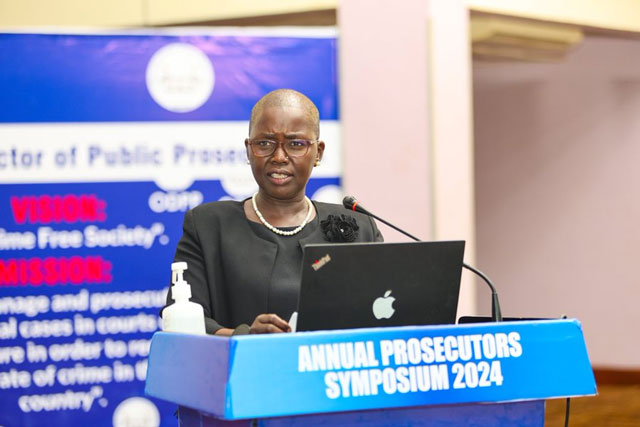
Kampala, Uganda | THE INDEPENDENT | Uganda ranks 7th in Africa for the highest number of cases related to Organized Crimes, the Director of Public Prosecutions Jane Frances Abodo has revealed.
These crimes, committed for financial gain, encompass activities such as money laundering, drug trafficking, smuggling of migrants, human trafficking, fraud, extortion, counterfeiting, contraband, asset misappropriation, armed robbery, and more.
Addressing the audience at the three-day Annual Prosecutors Symposium 2024 in Kampala, Abodo emphasized the need to strengthen prosecution capacity to combat both organized and emerging crimes.
She highlighted the dynamic nature of crime and the importance of exploring timely questions regarding prosecution mandates and accountability mechanisms.
The symposium, themed “Strengthening Capacity for Prosecution to Counter Organized and Emerging Crimes,” provides a platform to discuss the current and future roles of the Office of the DPP.
Abodo noted Uganda’s geographical location with porous borders, which creates opportunities for organized crime to thrive, making it a haven for various types of crime, including cross-border cases.
Assistant Director of Public Prosecutions Lino Anguzu outlined challenges to prosecuting organized crimes, including porous borders, evolving technology, inadequate investigations, prosecutorial capacity, involvement of high-profile individuals, and limited domestic and international cooperation.
Sharon Nyambe, Country Head of the United Nations Office on Drugs and Crime, highlighted internal issues within Uganda, such as child trafficking for sex work and forced begging, recruitment of youth into armed conflict in neighboring countries, and fraudulent recruitment for employment abroad.
She also pointed out Uganda’s role as a hub for arms trafficking across East, Central, and West Africa, and the challenges posed by counterfeit goods and environmental crimes.
“The porous borders and limited capacity to monitor smuggling further exacerbates the problem in addition, the lack of intellectual property rights legislation feeds a vast black market for smuggled and counterfeit goods,” said Nyambe.
She said that when they look at crimes against the environment, Uganda remains the key source of timber and charcoal destined for Kenya. “It is important to highlight that illegal timber or timber trade results in loss of forest cover and undermined tax collection while wildlife traffickers, on the other hand, are known to conceal contraband destined for other countries and markets,” she added.
Nyambe emphasized the importance of developing a national strategy against organized crime, including threat analysis, policy development, and capacity-building initiatives.
This strategy aims to enhance coordination among law enforcement agencies, government departments, and other stakeholders, facilitating information sharing, resource pooling, and effective implementation of countermeasures against organized crime.
Tags Abodo crime DPP Public Prosecution ranking
Related Articles

April 23, 2024

April 22, 2024

Leave a Reply Cancel reply
Your email address will not be published. Required fields are marked *
Save my name, email, and website in this browser for the next time I comment.
Notify me of follow-up comments by email.
Notify me of new posts by email.
Thank you for visiting nature.com. You are using a browser version with limited support for CSS. To obtain the best experience, we recommend you use a more up to date browser (or turn off compatibility mode in Internet Explorer). In the meantime, to ensure continued support, we are displaying the site without styles and JavaScript.
- View all journals
- My Account Login
- Explore content
- About the journal
- Publish with us
- Sign up for alerts
- Open access
- Published: 15 April 2024
The genome and population genomics of allopolyploid Coffea arabica reveal the diversification history of modern coffee cultivars
- Jarkko Salojärvi ORCID: orcid.org/0000-0002-4096-6278 1 , 2 , 3 ,
- Aditi Rambani 4 na1 ,
- Zhe Yu 5 na1 ,
- Romain Guyot ORCID: orcid.org/0000-0002-7016-7485 6 , 7 na1 ,
- Susan Strickler 4 na1 ,
- Maud Lepelley 8 ,
- Cui Wang ORCID: orcid.org/0000-0003-2916-3922 2 ,
- Sitaram Rajaraman ORCID: orcid.org/0000-0001-5171-3578 2 ,
- Pasi Rastas ORCID: orcid.org/0000-0003-2768-1339 9 ,
- Chunfang Zheng 5 ,
- Daniella Santos Muñoz 5 ,
- João Meidanis ORCID: orcid.org/0000-0001-7878-4990 10 ,
- Alexandre Rossi Paschoal ORCID: orcid.org/0000-0002-8887-0582 11 ,
- Yves Bawin 12 ,
- Trevor J. Krabbenhoft ORCID: orcid.org/0000-0002-7680-5169 13 ,
- Zhen Qin Wang 13 ,
- Steven J. Fleck ORCID: orcid.org/0000-0001-5370-2258 13 ,
- Rudy Aussel 8 , 14 ,
- Laurence Bellanger 8 ,
- Aline Charpagne 15 ,
- Coralie Fournier ORCID: orcid.org/0000-0002-7310-0227 15 ,
- Mohamed Kassam 15 ,
- Gregory Lefebvre 15 ,
- Sylviane Métairon ORCID: orcid.org/0000-0003-2434-8733 15 ,
- Déborah Moine 15 ,
- Michel Rigoreau 8 ,
- Jens Stolte 15 ,
- Perla Hamon 6 ,
- Emmanuel Couturon 6 ,
- Christine Tranchant-Dubreuil 6 ,
- Minakshi Mukherjee ORCID: orcid.org/0000-0002-5172-838X 13 ,
- Tianying Lan 13 ,
- Jan Engelhardt ORCID: orcid.org/0000-0003-4934-2135 16 ,
- Peter Stadler ORCID: orcid.org/0000-0002-5016-5191 16 , 17 ,
- Samara Mireza Correia De Lemos ORCID: orcid.org/0000-0003-3484-1943 18 ,
- Suzana Ivamoto Suzuki ORCID: orcid.org/0000-0001-7078-5809 19 ,
- Ucu Sumirat 20 ,
- Ching Man Wai ORCID: orcid.org/0000-0002-2913-5721 21 ,
- Nicolas Dauchot ORCID: orcid.org/0000-0001-8766-0498 22 ,
- Simon Orozco-Arias ORCID: orcid.org/0000-0001-5991-8770 7 ,
- Andrea Garavito ORCID: orcid.org/0000-0002-0864-8608 23 ,
- Catherine Kiwuka 24 ,
- Pascal Musoli 24 ,
- Anne Nalukenge 24 ,
- Erwan Guichoux 25 ,
- Havinga Reinout 26 ,
- Martin Smit 26 ,
- Lorenzo Carretero-Paulet 27 ,
- Oliveiro Guerreiro Filho ORCID: orcid.org/0000-0002-8228-2886 28 ,
- Masako Toma Braghini 28 ,
- Lilian Padilha ORCID: orcid.org/0000-0002-2204-6793 29 ,
- Gustavo Hiroshi Sera 30 ,
- Tom Ruttink ORCID: orcid.org/0000-0002-1012-9399 12 , 31 ,
- Robert Henry 32 ,
- Pierre Marraccini ORCID: orcid.org/0000-0001-7637-6811 33 ,
- Yves Van de Peer ORCID: orcid.org/0000-0003-4327-3730 31 , 34 , 35 , 36 ,
- Alan Andrade ORCID: orcid.org/0000-0001-7128-3472 37 ,
- Douglas Domingues ORCID: orcid.org/0000-0002-1290-0853 18 ,
- Giovanni Giuliano ORCID: orcid.org/0000-0002-2486-0510 38 ,
- Lukas Mueller 4 ,
- Luiz Filipe Pereira 39 ,
- Stephane Plaisance ORCID: orcid.org/0000-0002-1651-241X 40 ,
- Valerie Poncet ORCID: orcid.org/0000-0002-1099-2846 6 ,
- Stephane Rombauts ORCID: orcid.org/0000-0002-3985-4981 31 , 36 ,
- David Sankoff ORCID: orcid.org/0000-0001-8415-5189 5 ,
- Victor A. Albert ORCID: orcid.org/0000-0002-0262-826X 13 ,
- Dominique Crouzillat ORCID: orcid.org/0009-0000-3369-0173 8 ,
- Alexandre de Kochko ORCID: orcid.org/0000-0001-9212-3195 6 &
- Patrick Descombes ORCID: orcid.org/0000-0002-1274-247X 15
Nature Genetics volume 56 , pages 721–731 ( 2024 ) Cite this article
14k Accesses
1417 Altmetric
Metrics details
- Genome informatics
- Plant breeding
- Plant genetics
- Plant hybridization
Coffea arabica , an allotetraploid hybrid of Coffea eugenioides and Coffea canephora , is the source of approximately 60% of coffee products worldwide, and its cultivated accessions have undergone several population bottlenecks. We present chromosome-level assemblies of a di-haploid C. arabica accession and modern representatives of its diploid progenitors, C. eugenioides and C. canephora . The three species exhibit largely conserved genome structures between diploid parents and descendant subgenomes, with no obvious global subgenome dominance. We find evidence for a founding polyploidy event 350,000–610,000 years ago, followed by several pre-domestication bottlenecks, resulting in narrow genetic variation. A split between wild accessions and cultivar progenitors occurred ~30.5 thousand years ago, followed by a period of migration between the two populations. Analysis of modern varieties, including lines historically introgressed with C. canephora , highlights their breeding histories and loci that may contribute to pathogen resistance, laying the groundwork for future genomics-based breeding of C. arabica .
Similar content being viewed by others
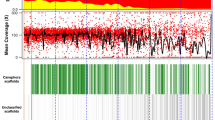
A single polyploidization event at the origin of the tetraploid genome of Coffea arabica is responsible for the extremely low genetic variation in wild and cultivated germplasm
Simone Scalabrin, Lucile Toniutti, … Benoit Bertrand
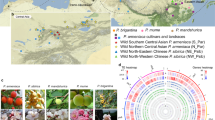
Population genomics of apricots unravels domestication history and adaptive events
Alexis Groppi, Shuo Liu, … Véronique Decroocq
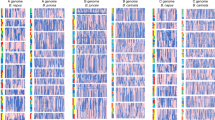
Genome structural evolution in Brassica crops
Zhesi He, Ruiqin Ji, … Ian Bancroft
Polyploidy is a powerful evolutionary force that has shaped genome evolution across many eukaryotic lineages, possibly offering adaptive advantages in times of global change 1 , 2 . Such whole-genome duplications (WGDs) are particularly characteristic of plants 3 , and a great proportion of crop species are polyploid 4 , 5 , 6 , 7 , 8 , 9 , 10 , 11 . Our understanding of genome evolution following WGD is still incomplete, but outcomes can include genomic shock, in terms of activation of cryptic transposable elements (TEs), subgenome-partitioned gene regulation or fractionation, homoeologous exchange (HE), meiotic instability and even karyotype variation 8 , 12 , 13 , 14 , 15 , 16 . Alternatively, few or none of the above phenomena can materialize, and the two subgenomes can coexist harmonically, gradually adapting to new ploidy levels 17 . Regardless, the most common fate of polyploids appears to be fractionation and eventual reversion to the diploid state 18 .
With an estimated production of 10 million metric tons per year, coffee is one of the most traded commodities in the world. The most broadly appreciated coffee is produced from the allotetraploid species Coffea arabica , especially from cultivars belonging to the Bourbon or Typica lineages and their hybrids 19 . C. arabica (2 n = 4 x = 44 chromosomes) resulted from a natural hybridization event between the ancestors of present-day Coffea canephora (Robusta coffee, subgenome CC (subCC)) and Coffea eugenioides (subgenome EE (subEE)), each with 2 n = 2 x = 22. The founding WGD has previously been dated to between 10,000 and 1 million years ago 20 , 21 , 22 , 23 , with the Robusta-derived subgenome of C. arabica most closely related to C. canephora accessions from northern Uganda 24 . Arabica cultivation was initiated in fifteenth- to sixteenth-century Yemen (Extended Data Fig. 1 ). Around 1600, the so-called seven seeds were smuggled out of Yemen 25 , establishing Indian C. arabica cultivar lineages. A century later, the Dutch began cultivating Arabica in Southeast Asia—thus setting up the founders of the contemporary Typica group. One plant, shipped to Amsterdam in 1706, was used to establish Arabica cultivation in the Caribbean in 1723. Independently, the French cultivated Arabica on the island of Bourbon (presently Réunion) 26 , and the descendants of a single plant that survived by 1720 form the contemporary Bourbon group. Contemporary Arabica cultivars descend from these Typica or Bourbon lineages, except for a few wild ecotypes with origins in natural forests in Ethiopia. Due to its recent allotetraploid origin and strong bottlenecks during its history, cultivated C. arabica harbors a particularly low genetic diversity 20 and is susceptible to many plant pests and diseases, such as coffee leaf rust ( Hemileia vastatrix ). As a result, the classic Bourbon–Typica lineages can be cultivated successfully in only a few regions around the world. Fortunately, a spontaneous C. canephora × C. arabica hybrid resistant to H. vastatrix was identified on the island of Timor 27 in 1927. Many modern Arabicas contain C. canephora introgressions derived from this hybrid, ensuring rust resistance, but having also unwanted side effects, such as decreased beverage quality 28 .
Modern genomic tools and a detailed understanding of the origin and breeding history of contemporary varieties are vital to developing new Arabica cultivars, better adapted to climate change and agricultural practices 29 , 30 , 31 . Here, we present chromosome-level assemblies of C. arabica and representatives of its progenitor species, C. canephora (Robusta) and C. eugenioides (hereafter Eugenioides). Whole-genome resequencing data of 41 wild and cultivated accessions facilitated in-depth analysis of Arabica history and dissemination routes, as well as the identification of candidate genomic regions associated with pathogen resistance.
The genomes of C. arabica , C. canephora and C. eugenioides
As reference individuals, we chose the di-haploid Arabica line ET-39 (ref. 32 ), a previously sequenced doubled haploid Robusta 33 and the wild Eugenioides accession Bu-A, respectively. Long- and short-read-based hybrid assemblies were obtained ( Methods and Supplementary Sections 2.1 and 2.2 ), spanning 672 megabases (Mb) (Robusta), 645 Mb (Eugenioides) and 1,088 Mb (Arabica), respectively. Upon Hi-C scaffolding, the Robusta and Arabica assemblies consisted of 11 and 22 pseudochromosomes, and spanned 82.7% and 62.5%, respectively, of the projected genome sizes (Table 1 ). To improve the Arabica assembly, we generated a second assembly using Pacific Biosciences (PacBio) HiFi technology followed by Hi-C scaffolding ( Methods and Supplementary Sections 2.2 and 2.3 ). This assembly was 1,198 Mb long, of which 1,192 Mb (93.1% of the predicted genome size based on cytological evidence 34 ) was anchored to pseudochromosomes (Table 1 ). Gene space completeness, assessed using Benchmarking Universal Single-Copy Orthologs (BUSCOs) 35 , was >96% for all assemblies. Importantly, 93.2% of the BUSCO genes were duplicated in the HiFi assembly (Table 1 ), indicating that most of the gene duplicates from the allopolyploidy event were retained.
The Robusta and Eugenioides genomes contained, respectively, 67.5% and 59.7% TEs (Supplementary Section 3.2 ), with Gypsy long terminal repeat (LTR) retrotransposons accounting for most of the difference between the two species. This difference was greatly reduced (63.1% and 63.8%) in the two Arabica subgenomes (subCC and subEE, stemming from Robusta and Eugenioides ancestors, respectively), possibly indicating TE transfer via HE. Robusta contained considerably more recent LTR TE insertion elements than Eugenioides. Again, the two Arabica subgenomes showed greater similarity to each other in recent LTR TE insertions than the two progenitor genomes. No major evidence was found for LTR TE mobilization following Arabica allopolyploidization, in contrast to what has been observed in tobacco 36 , but similar to Brassica synthetic allotetraploids 37 . Observed Arabica genome evolution instead more closely follows the ‘harmonious coexistence’ pattern 38 seen in Arabidopsis hybrids 17 , 39 .
High-quality gene annotations, followed by manual curation of specific gene families (Supplementary Sections 3.1 – 3.4 ), resulted in 28,857, 32,192, 56,670 and 69,314 gene models for the Robusta, Eugenioides, PacBio Arabica and Arabica HiFi assemblies, respectively (Table 1 ). Altogether, ~97% of Robusta and 99.6% of Arabica HiFi gene models were placed on the pseudochromosomes, with 33,618 and 35,449, respectively, to subgenomes subCC and subEE (Table 1 ). Annotation completeness from BUSCO was ≥95% for Eugenioides and Robusta, and reached 97.3% for Arabica HiFi.
Genome fractionation and subgenome dominance
Comparison of Arabica subCC and subEE against their Robusta and Eugenioides counterparts revealed high conservation in terms of chromosome number, centromere position and numbers of genes per chromosome (Fig. 1 and Supplementary Section 4 ). Patterns of gene loss following the gamma paleohexaploidy event displayed high structural conservation between Robusta and Eugenioides during the 4–6 million years since their initial species split 22 , 23 (Supplementary Section 4 ). Likewise, the structures of the two Arabica subgenomes were highly conserved between each other, with, since the Arabica-founding allotetraploidy event, only ~5% of BUSCO genes having reverted to the diploid state (Fig. 1a and Table 1 ). Syntenic comparisons revealed that genomic excision events, removing one or several genes at a time in similar proportions across the two subgenomes, have been the main driving force in genome fragmentation both before and after the polyploidy event (Fig. 1b and Supplementary Section 4 ). Fractionation occurred mostly in pericentromeric regions, whereas chromosome arms showed more moderate paralogous gene deletion (Fig. 1c and Supplementary Section 4 ). The Arabica allopolyploidy event seemingly did not affect the rate of genome fractionation, which remained roughly constant when comparing deletions in progenitor species versus Arabica subgenomes after the event. In support of the dosage-balance hypothesis 40 , subgenomic regions with high duplicate retention rates were significantly enriched for genes that originated from the Arabica WGD (Fisher exact test, P < 2.2 × 10 −16 ). In contrast, low duplicate retention rate regions significantly overlapped with genes originating from small-scale (tandem) duplications (Supplementary Table 1 ). Genes with high retention rates were enriched in Gene Ontology (GO) categories such as ‘cellular component organization or biogenesis’, ‘primary metabolic process’, ‘developmental process’ and ‘regulation of cellular process’, while low retention rate genes were enriched in categories such as ‘RNA-dependent DNA biosynthetic process’ and ‘defense response’ (in both subgenomes), and ‘spermidine hydroxycinnamate conjugate biosynthetic process’ (involved in plant defense 41 ) and ‘plant-type hypersensitive response’ (in subEE) (Supplementary Tables 2 – 5 ).

a , Corresponding syntenic blocks between CA subgenomes subCC (orange) and subEE (blue), and with the CC (orange) and CE (blue) genomes. b , The base pairs in intergenic DNA in synteny block gaps caused by fractionation in a subCC–subEE comparison, compared with numbers of base pairs in homoeologous unfractionated regions, as a function of numbers of consecutive genes deleted. c , Gene retention rates in synteny blocks plotted along subCC chromosome 2; subCC is plotted in orange and subEE in blue. The green box indicates the pericentromeric region. CA, C. arabica ; CC, C. canephora ; CE, C. eugenioides .
To study possible expression biases between subgenomes, we identified syntelogous gene pairs and removed the pairs showing HEs in the Arabica subgenomes (see under ‘Origin and domestication of Arabica coffee’ below) 42 (Supplementary Section 5 ). Overall, no significant global subgenome expression dominance was observed (Supplementary Tables 6 and 7 ). However, gene families regularly displayed mosaic patterns of expression, including several encoding enzymes that contribute to cup quality, such as N -methyltransferase ( NMT ), terpene synthase ( TPS ) and fatty acid desaturase 2 ( FAD2 ) families, all having some genes being more expressed in one of the two subgenomes (Extended Data Fig. 2 ), as per a recent study 43 . Similar gene family-wise patterns occur in other evolutionarily recent polyploids such as rapeseed 10 and cotton 44 , which are also at their early stages of transitioning back to a diploid state.
Origin and domestication of Arabica coffee
To obtain a genomic perspective on the evolutionary history of Arabica, we sequenced 46 accessions, including three Robusta, two Eugenioides and 41 Arabica. The latter included an eighteenth-century type specimen, kindly provided by the Linnaean Society of London, 12 cultivars with different breeding histories, the Timor hybrid and five of its backcrosses to Arabica, and 17 wild and three wild/cultivated accessions collected from the Eastern and Western sides of the Great Rift Valley 45 , 46 (Supplementary Table 8 and Fig. 2a ).
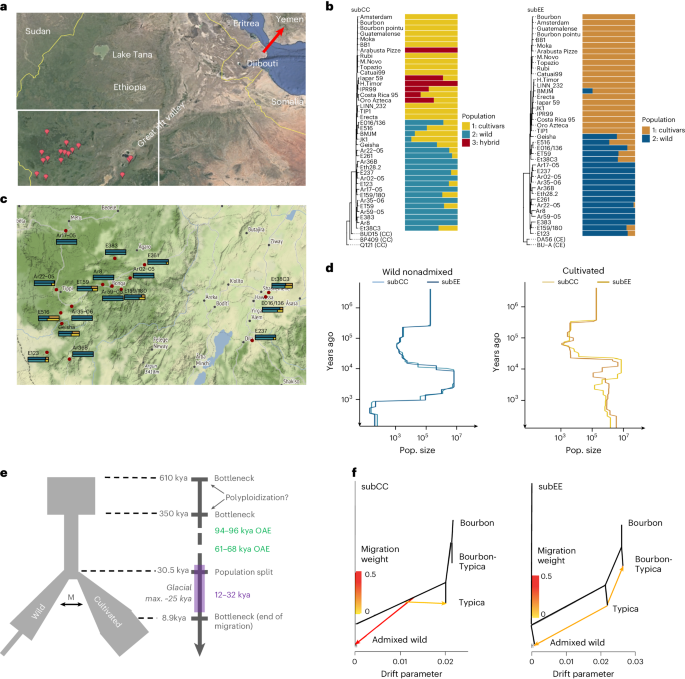
a , Geographic origin of resequenced wild C. arabica accessions (red placeholders). Accession names are given in c . The red arrow indicates the probable route of migration to Yemen in historical times. b , Ancestral population assignments of C. arabica accessions for subCC (left) and subEE (right). Relationships among individuals are illustrated with phylogenetic trees obtained from independent SNPs. For magnified views of the trees, see Supplementary Fig. 37 . c , Magnification of the bottom left part of a , showing the admixture values for each of the accessions in subCC (top) and subEE (bottom); the colors correspond to the analysis in b . d , Population sizes of wild and cultivated accessions, inferred using SMC++, suggest genetic bottlenecks at ~350 and 1 ka (limited to nonadmixed wild individuals). e , FastSimcoal2 output, suggesting a population split ~30.5 ka, followed by a period of migration between the populations until ~8.9 ka. This timing corresponds with increased population diversity in cultivars at a similar time, calculated using SMC++. Green rectangles along the timeline show ‘windows of opportunity’, times when Yemen was connected with the African continent wherein human migrations to the Arabian Peninsula may have occurred. The purple rectangle shows the last ice age. M, migration; OAE, out-of-Africa event. f , Directional gene flow analysis using Orientagraph suggests two hypotheses: gene flow from the shared ancestral population of all cultivars to the Ethiopian wild individuals (subCC), or gene flow from the Typica lineage to Ethiopia (subEE). Maps in a and c were generated with Google Earth and Google Maps, respectively.
HE between subgenomes has been observed in several recent polyploids 8 , 10 , 42 . Arabica generally displays bivalent pairing of homologous chromosomes and disomic inheritance 47 , but since the subgenomes share high similarity, occasional homoeologous pairing and exchange may also occur. We therefore explored the extent of HE among Arabica accessions and its possible contribution to genome evolution. Overall, all accessions shared a fixed allele bias toward subEE at one end of chromosome 7, which contained genes enriched for chloroplast-associated functions (Extended Data Fig. 3a , Supplementary Section 5 and Supplementary Table 9 ). Since the Arabica plastid genome is derived from Eugenioides 48 , HE in this region was likely selected for, due to compatibility issues between nuclear and chloroplast genes encoding chloroplast-localized proteins 49 . Surprisingly, all but one accession (BMJM) showed significant (Bonferroni-adjusted P values < 0.0005; chi-squared test, each d.f. = 1) 3:1 allelic biases toward subCC. The highly concordant HE patterns, present in both wild and cultivated Arabicas (Extended Data Fig. 4 ), suggested that (1) the allelic bias is an adaptive trait not associated with breeding and (2) it originated in a common ancestor of all sampled accessions, possibly immediately after the founding allopolyploidy event. Some exchanges, shared by only a few accessions, probably originated more recently (Extended Data Fig. 3b ). More recent HE events were also found in some cultivars and also showed a bias toward subCC, except for BMJM, which showed bias toward subEE due to a single large crossover in chromosome 1 (Extended Data Fig. 3a ). An interesting hypothesis for future investigation is that in a low-diversity polyploid species such as Arabica, HE could be a major contributor to phenotypic variation observed among closely related accessions 50 .
We next studied population genetic statistics for each of the subgenomes (Supplementary Table 10 ). The 17 wild samples demonstrated low genomic diversities, indicative of small effective population sizes, while negative Tajima’s D suggested an expanding population, possibly following one or more population bottlenecks. The cultivars and wild population samples had similar genetic diversities, as demonstrated by low fixation index ( F ST ) values. In cultivars, nucleotide diversities were only slightly lower than in wild populations and Tajima’s D scores were less negative, suggesting that only minor bottlenecks and subsequent population expansions occurred during domestication.
SNP tree estimation and ADMIXTURE analyses (Fig. 2b ) identified a three-population solution for subCC: Typica–Bourbon cultivars (Population 1), wild accessions (Population 2), and Timor hybrid-derived cultivars (Population 3). The old BMJM and the recently established Geisha cultivars showed admixed states on both subgenomes, similar to about half of the wild accessions. Indian varieties encompassed both Typica and Bourbon variation, in agreement with previous studies 20 . The Linnaean sample grouped with the cultivars, supporting its hypothesized origin from the Dutch East Indies 25 . A complementary principal component analysis (PCA) (Extended Data Fig. 5 ) was in agreement with ADMIXTURE analysis.
In wild accessions, both subgenomes concordantly showed two population bottlenecks (Fig. 2d ) in the SMC++ (ref. 51 ) modeling. Assuming a 21-year generation time 52 , the oldest bottleneck initiated abruptly around 350 thousand years ago (ka) and ended around 15 ka, at the start of the African humid period 53 , when climatic conditions were more favorable for Arabica growth. The more recent bottleneck initiated more gradually around 5 ka and lasts to this day. Cultivated accessions, however, exhibited the oldest, but not the more recent, bottleneck. In part due to these differences, we also modeled Arabica population history using FastSimcoal2 (ref. 54 ), modeling the wild population and cultivars as two separate lineages. In the best-fitting model (Fig. 2e ), the wild population was predicted to split from the cultivar founding population 1,450 generations ago (~30 ka), that is, before the last glacial maximum. The original founding event was analyzed using the nonadmixed wild individuals, revealing an ancestral population bottleneck at 350 ka (Extended Data Fig. 6a ). Divergence estimates based on gene fractionation, the distribution of nonsynonymous mutations (Extended Data Fig. 6b ) and calibrated SNP trees (Fig. 2b ) suggested the allopolyploid founding event occurred at 610 ka, which is close to previous estimates 22 , 23 . The 350 ka bottleneck, on the other hand, corresponds to that found in the SMC++ analyses (Fig. 2d ). We therefore consider 610–350 ka a likely time range for the polyploidization event (Fig. 2e ). The wild and pre-cultivar lineages maintained some gene flow (in terms of migration) until ~8–9 ka, which may have contributed to the modeled increase in effective population size (Fig. 2d,e ).
While these data were not able to identify the precise place of origin of the modern cultivated population (see also the following section), the extended period of migration between wild and cultivated accessions suggests that they were separated only by a relatively small geographic distance, such as along the two sides of the African Great Rift Valley (Fig. 2a–c ). It is also possible that the cultivated lineage could have extended as far as Yemen and that the end of migration between the two populations could have been caused by the widening of the Bab al-Mandab strait (separating Yemen and Africa) due to rising sea levels 55 at the end of the African humid period. A native Arabica population exists in Yemen 56 , which could support this hypothesis. The Linnaean sample, together with the Typica and Bourbon cultivars, originates from this second population, which was also used to establish cultivation in Yemen, as suggested by the SNP, ADMIXTURE and PCA analyses (Fig. 2b and Extended Data Fig. 5 ).
In conclusion, our analyses suggest that the Arabica allopolyploidy event occurred between 610 and 350 ka, when considering that inbreeding present in Coffea populations would accelerate coalescence estimation 57 , 58 . Earlier work proposing more recent timings, such as 20 ka (ref. 20 ), could be underestimates stemming from confounding effects of population bottlenecks in cultivated and wild lineages.
Origin of modern cultivars
The known breeding history of several of our Arabica cultivars provided us with a gold standard set for deducing the Arabica pedigree using Kinship-based INference for Gwas (KING) 59 (Fig. 3 ). The method correctly identified the relationships between Bourbon and Typica group cultivars and the Bourbon–Typica crosses in subCC. In contrast, the subEE pedigree showed lower (second) order relationships, possibly due to HE in that subgenome (Extended Data Fig. 7 ). Timor hybrid-derived accessions did not show significant relationships to mainline cultivars in subCC (likely due to Robusta introgressions in this subgenome that broke the haplotype blocks; see below), while subEE showed second-degree relationships to both the Typica and Bourbon groups (Fig. 3 and Extended Data Fig. 7 ), confirming that subEE has not received substantial introgression.
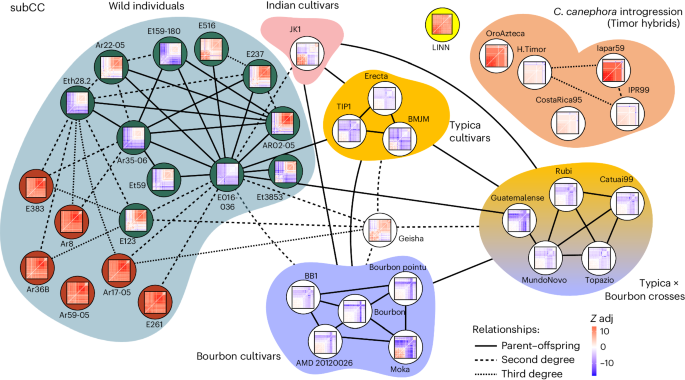
The degree of relatedness was estimated using KING and describes the number of generations between the related accessions. Thumbnail images show FDR-corrected F3 tests of introgression for each of the target individuals. Each cell in the matrix illustrates an F3 test result for the target accession containing introgression from two different sources ( x and y axes); blue color illustrates significant adjusted Z -score ( Z adj; value indicated by color key), indicative of gene flow (or allele sharing via identity by descent 78 ) from the two source accessions to the target, while red color illustrates no support for gene flow. See Extended Data Fig. 7 for corresponding analyses in subEE. In the wild accessions, the dark green background highlights the admixed individuals (Fig. 2b ), while the nonadmixed individuals are highlighted with red background. Relationships follow standard nomenclature (for example, second degree refers to an individual’s grandparents, grandchildren and so on, whereas third degree refers to great-grandparents, great-grandchildren and so on).
Interestingly, the Typica, Bourbon and JK1 individuals were also first degree related, suggesting direct parent–offspring relationships. Besides confirming their shared Yemeni origins, this finding also underscores the Yemeni germplasm’s limited genetic diversity. Further, the old cultivar lines JK1 (Indian), Erecta (Indonesian Typica), BMJM (Caribbean Typica), TIP1 (Brazilian Typica) and BB1 (Brazilian Bourbon) showed second- or higher-degree relationships with a cluster of closely related wild admixed accessions, centered on E016/136 (Fig. 2b ). The recently established Geisha cultivar showed similar relationships to the wild admixed individuals and the Bourbon and Typica groups, suggesting common origins. Interestingly, admixed wild accession E016/136 was closely related to both wild and cultivated populations.
In a comparison of geographic origins, wild individuals from the Eastern side of the Great Rift Valley had some levels of admixture and were closely interrelated, while on the Western side, the admixed, related individuals were mostly concentrated around the Gesha region (Figs. 2c and 3 ). The E016/136 admixed accession, closest to cultivars, demonstrated a first-degree relationship with several wild accessions, of which only Ar35-06 and Eth28.2 were pure representatives of the wild population (Fig. 2b ). Therefore, these two accessions are genetically closest, in our sample, to the hypothetical true wild parent of cultivated Arabica, with E016/136 representing an intermediate form. Ar35-06 was collected near Gesha mountain, close to the origin of the modern Geisha cultivar. Altogether, these data point to the Gesha region as a hotspot of wild accessions amenable to domestication.
Admixed wild samples may have originated from a recent hybridization event that occurred before or after their collection from the wild. A third alternative is that the Yemeni population (and hence the cultivars) originated from an admixed population from the Eastern side of the Great Rift Valley or the Gesha region. Analysis of admixture patterns with Orientagraph 60 (Fig. 2f ) suggested hybridization with the common ancestor of the Bourbon and Typica lineages in subCC, and of Typica in subEE. In the case of recent hybridization, introduced haplotypes would exist as long contiguous blocks (as in the Timor hybridization, which occurred 100 years ago), while for older events, the blocks would be more fragmented due to crossing-over. Analysis using the distance fraction ( d f ) statistic 61 showed the latter to be the case (Extended Data Fig. 8 ), indicating that admixture events among wild accessions were not very recent, supporting our third hypothesis.
Domestication and cultivation usually involve strong population bottlenecks based on high wild diversity, resulting in reduced genetic diversity in cultivars 62 . However, Arabica nucleotide diversity was already very low in the wild, probably as a result of earlier bottlenecks (Fig. 2d,e ), but only marginally reduced in the pre-cultivated lineage (Extended Data Fig. 9a ). Bourbon had lower diversity than Typica, probably resulting from the known single-individual bottleneck in this group. Also, the inbreeding coefficients in the wild and cultivated accessions were similar (Extended Data Fig. 9b ), differing from general expectations for a domesticated species 62 .
To look for pathways under purifying selection in cultivars, we identified genes with high F ST (95% quantile) between cultivars and wild accessions. This resulted in a set of 1,908 genes that were enriched for the GO categories ‘cellular response to nitrogen starvation’, ‘regulation of innate immune response’ and ‘regulation of defense response’ (Supplementary Table 11 ), and contained homologs of ammonium transporters AMT1 and AMT2 , important for nitrogen uptake in Coffea 63 ; a homolog of the salicylic acid receptor NONEXPRESSER OF PR GENES 1 ( NPR1 ), required in salicylic acid signaling and systemic acquired resistance 64 ; as well as a homolog of the Arabidopsis LSU2 gene, previously identified as a hub convergently targeted by effectors of pathogens from different kingdoms 65 . A second screen, focused on genes with a large number of high-impact nonsynonymous mutations shared among cultivars (>40% individuals having the mutation), generated a list of 556 genes that were significantly enriched for only one GO category, ‘defense response’ (Supplementary Table 12 ). From the 22 genes in this category, 16 were NB-ARC domain-containing resistance (R) genes, and two were members of the leucine-rich repeat (LRR) defense gene family. High diversity in immune-related responses is one possible pathogen resistance mechanism in plant communities 66 , and therefore reduced diversity may have compromised modern Arabica cultivar immunity.
The high level of conservation between the Arabica subgenomes and their diploid progenitors may have facilitated spontaneous interspecific hybridization events. This was the case for the Timor hybrid, a spontaneous Robusta × Arabica hybrid resistant to H. vastatrix 27 . Our sample set included five descendants of the original Timor hybrid, obtained by backcrossing to Arabica. As expected, the hybridization affected subCC more profoundly, with much higher levels of nucleotide divergence apparent ( F ST = 0.185) than in subEE ( F ST = 0.0897), when comparing cultivars and hybrids. The divergence from wild populations was even greater, with F ST = 0.254 for subCC and F ST = 0.138 for subEE, illustrating that introgression occurred almost exclusively within subCC.
In the Timor hybrids, the regions found with d f statistics 61 largely overlapped the introgressed loci identified using F ST scans (Fig. 4a ) and were found in large blocks, reflecting recent hybridization, and covering 7–11% of the genome (Fig. 4a and Extended Data Fig. 8 ). Transposon insertion polymorphisms (TIPs) also overlapped with introgressed regions (Gypsy P = 0.0002; Copia P = 0.035; Fisher exact test), confirming their recent origin from Robusta (Fig. 4b ). The introgressed regions overlapped with regions of higher subgenome fractionation ( P = 0.001873; Supplementary Table 13 ), possibly due to heterologous recombination between subCC and Robusta, resulting in unequal crossing-over.
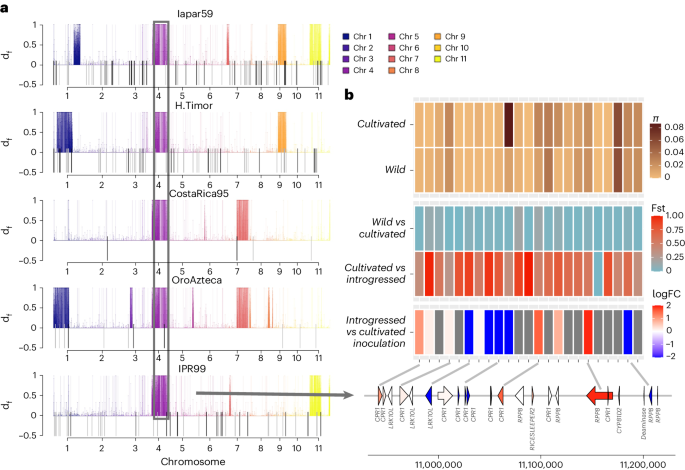
a , Introgression d f statistic estimated for different Timor hybrid derivatives. Colored lines above the axis mark regions of significant introgression in the line under inspection, and are colored by chromosome. The shared introgressed region on chromosome 4 is colored in purple and boxed. TIPs are represented as lines below the x axis and exhibit overlap with introgressed regions. b , The shared introgressed genomic region on subCC chromosome 4 contains a cluster of R genes ( RPP8 ), a cluster of homologs of a negative regulator of R genes ( CPR1 ) and a cluster of homologs of Leaf rust resistance 10 kinases ( LRK10L ) (bottom). The heatmap shows, from the bottom up, (1) log fold change of gene expression after H. vastatrix inoculation, when comparing resistant Timor hybrid lineage against a susceptible cultivar; red color means elevated expression in the hybrid, and blue decreased expression. (2) Fixation index ( F ST ) values for the introgressed lines versus cultivars and between cultivars and wild accessions. (3) Nucleotide diversity for the wild and cultivated accessions for each gene coding region, plus the flanking 2 kb upstream and downstream of the region. FC, fold change.
An introgressed region shared by all Timor hybrid lines was evident on chromosome 4 (Fig. 4a ). We identified a set of 233 genes shared by all hybrids (Supplementary Table 14 ). The set contained members of three colocalized tandemly duplicated blocks of resistance-related genes on chromosome 4, subCC, and showed high F ST values between cultivars and introgressed lines. A tandem array of five genes were homologs of Arabidopsis RPP8 , a NOD-like receptor resistance locus conferring pleiotropic resistance to several pathogens 67 , 68 . RPP8 shows a great amount of variation in Arabidopsis alone, where intrachromosomal gene conversion combined with balancing selection contributes to its exceptional diversity 69 . The same subCC region also included a tandem array of ten homologs of CONSTITUTIVE EXPRESSER OF PR GENES 1 ( CPR1 ), a negative regulator of defense response that targets resistance proteins 70 , 71 . Finally, we identified three duplicates encoding Leaf rust 10 disease-resistance locus receptor-like protein kinases (LRK10L). The LRK10L are a gene family that is widespread across plants. First identified as a protein kinase in a locus contributing leaf rust resistance in wheat 72 , they were found to be upregulated during various biotic and abiotic stresses 73 and were confirmed as positive regulators of wheat hypersensitive resistance response to stripe rust fungus 73 and powdery mildew 74 .
The high F ST values between cultivated and introgressed, but not wild, individuals (Fig. 4b ) indicate that the wild population cannot be the source for allelic asymmetries. Nucleotide diversities further illustrate this point; some genes demonstrate lower nucleotide diversity in wild individuals, suggesting these genes to have experienced selective sweeps. To further narrow down candidate genes involved in leaf rust resistance, we reanalyzed comparative gene expression data from susceptible and resistant accessions after H. vastatrix inoculation 75 . This analysis identified 723 differentially expressed genes, most of which were associated with defense responses (Fig. 4b and Supplementary Tables 14 and 15 ). The combination of high F ST values, nucleotide diversities and differential expression data highlights several strong candidate genes (one RPP8 , six CPR1 and one LRK10L ) at this locus.
Besides providing genomic resources for molecular breeding of one of the most important agricultural commodities, our Arabica, Robusta and Eugenioides genomes provide a unique window into the genome evolution of a recently formed allopolyploid stemming from two closely related species. Our Arabica data did not suggest a genomic shock induced by allopolyploidy, but, instead, only higher LTR transposon turnover rate. Genome fractionation rates remained basically unaltered before and after the allopolyploidy event. Likewise, no global subgenome dominance in gene expression was observed, but rather a mosaic-type pattern as in other recent polyploids 10 , 44 , affecting the expression of individual gene family members. However, similar to octoploid strawberry 8 , we detected genome dominance in terms of biased HEs favoring subCC. Since Robusta has one of the widest geographic ranges in the Coffea genus, whereas Eugenioides is more range-limited, this biased HE might be adaptive. This hypothesis was supported by the site frequency spectrum of HE loci, showing signs of directional selection (Extended Data Fig. 3 ). Intriguingly, transposable insertion polymorphisms significantly overlapped with tandem gene duplications and biosynthetic gene clusters, hinting at their possible roles in cluster evolution.
Domestication of perennial species such as Arabica coffee differs markedly from that of annual crops, consisting instead of three phases: selection of outstanding genotypes from wild forests, clonal propagation and cultivation, and then breeding and diversification 76 . In addition to being a perennial crop, Arabica is also a predominantly autogamous allopolyploid, which puts it in a class of its own. We show here that genetic diversity was already very low among wild accessions, due to multiple pre-domestication bottlenecks, and that the genotypes selected for cultivation by humans (both the ancient cultivated Ethiopian landraces and the recent Geisha cultivar) already were somewhat admixed between divergent lineages. The resequenced accessions displayed a geographic split along the Eastern versus Western sides of the Great Rift Valley, with cultivated coffee variants all placed with the Eastern population. Such admixture has played a large role in breeding many fruit-bearing crops, the nonpolyploid allogamous perennial lychee being one of the most extreme cases 58 .
The prevalent autogamy of Arabica, combined with the multiple genetic bottlenecks it underwent in the wild, may have selectively purged deleterious alleles, explaining the capacity of the species to survive single-plant bottlenecks that occurred during its cultivation. An additional element buffering deleterious alleles was probably Arabica’s allopolyploidy itself, which provided some level of heterosis 77 . However, the narrow genetic basis of both cultivated and wild modern Arabica constitutes a major drawback, as well as an obstacle for its breeding using wild genepool diversity. On the other hand, the extensive collinearity of its CC and EE subgenomes with those of its Robusta and Eugenioides progenitors is likely to facilitate introgression of interesting traits from these species, as already happened historically in the Timor spontaneous hybrid. The high-quality genome sequences of the three species provided in this work, together with the identification of the genomic region conferring resistance to coffee leaf rust, constitute a cornerstone for the breeding of novel Arabica varieties with superior adaptability and pathogen resistance.
Genome sequencing
For the three Coffea species, genomic DNA was extracted from leaf tissue. A Qiagen kit was used for DNA extraction for Illumina sequencing. Illumina short reads and PacBio 20-kilobase (kb) libraries were prepared following the manufacturer’s instructions. Sequencing was performed on a HiSeq2000 instrument for the short reads, and the PacBio RSII platform for long reads (specifications given in Supplementary Table 16 ). For the generation of HiFi reads, DNA was extracted from C. arabica leaf tissue following nuclei purification by centrifugation followed by lysis, phenol–chloroform extraction and isopropanol precipitation. DNA was fragmented to 20 kb using a Megaruptor 3. SMRTbell libraries were sequenced on a single SMRTcell on a Sequel IIe platform.
For the resequencing of 39 wild and cultivated C. arabica accessions, libraries were prepared using the KAPA HyperPrep Kits (Roche) following the manufacturer’s instructions, and paired-end (2 × 125) sequenced on an Illumina HiSeq2500 instrument to ~40× coverage. The Linnaean herbarium sample was sequenced to 46× coverage with Ion Torrent technology.
Contig-level assembly for C. canephora was obtained with MHAP 79 and scaffolded using BAC-end sequences and 454 paired-end sequences generated previously 33 . Both C. eugenioides and C. arabica were assembled with Falcon 80 , and C. arabica was subsequently phased using Falcon_unzip. All three genomes were error-corrected with Pilon 81 using Illumina short reads (Supplementary Section 2.2 ). C. canephora and C. arabica were further scaffolded into pseudochromosomes using Dovetail Hi-C technology. For C. eugenioides no more material could be obtained for further improvement of the assembly contiguity, and the assembly was scaffolded into pseudomolecules using C. canephora as reference. Gaps in the scaffolds were filled with PBJelly 82 , after which six more rounds of polishing were done with Pilon using the Illumina shotgun sequenced genomic DNA as well as RNA sequencing (RNA-seq) reads.
The resulting chromosome assemblies for C. canephora were checked and corrected using an ultra-high-density linkage map 83 generated during the project. To further improve the quality of the C. arabica assembly, Bionano genome maps were generated.
C. arabica HiFi assembly was carried out with hifiasm v.0.16.1 (ref. 84 ), followed by scaffolding using Hi-C data from Dovetail technology and ALLHiC 85 pipeline. Final quality checks and manual adjustments of the assembly were carried out using 3d-DNA 86 and juicebox 87 .
The completeness of the different assemblies was assessed using BUSCO v.5.2.2 (ref. 35 ) with the eudicots_odb10 database (2,326 genes; Table 1 ). Telomeric repeats were searched across the chromosomes using CoGeBLAST 88 .
To assess the phasing of both subgenomes from C. arabica , synonymous nucleotide substition ( K s ) values were obtained from CoGe 89 and compared between C. arabica and each of two diploid outgroups, C. canephora and C. eugenioides , using scripts in R.
Linkage map
A reference genetic map was constructed from a cross between a Congolese group genotype (BP409) and a Congolese × Guinean hybrid parent (Q121). The segregating population was composed of 93 F1 individuals 90 . The parents were sequenced to 60× and progeny to 20× coverage using the Illumina HiSeq2000 platform at Nestlé Research. Following quality control with FastQC and trimming with Trimmomatic v.0.36 (ref. 91 ), the reads were mapped against the C. canephora reference assembly using BWA-MEM v.0.7.15 (ref. 92 ). The linkage mapping was conducted with Lep-MAP3 (ref. 83 ). The markers were clustered into paternal and maternal linkage groups by using a logarithm of the odds score of 18 in a segregation distortion aware model. The final curation of the assembly, combining the two parental maps, solving conflicts as well as identification of haplotype alleles, was carried out manually.
TE annotation and analysis
EDTA 93 was used to de novo identify TEs in the C. canephora , C. eugenioides as well as C. arabica subgenomes. Inpactor2 (ref. 94 ) was used to recover full-length LTR retrotransposons in the three genomes and to classify them at the lineage level. EDTA and Inpactor2 libraries were merged and clustered using cd-hit 95 . Clusters were manually inspected to remove nested and false predictions. After curation, libraries were used for annotation using Repeat Masker (default parameters). Annotations with length >200 base pairs (bp) were retained. The timing of LTR retrotransposon insertions was studied in the three genomes using individual sequences recovered by Inpactor2 and using an average base substitution rate of 1.3 × 10 −8 (ref. 96 ), similar to Orozco-Arias et al. 97 .
Gene prediction
RNA-seq and IsoSeq reads were generated to support de novo gene prediction. A MAKER-P pipeline 98 was used to combine several de novo gene callers with the IsoSeq and junction information from short-read RNA-seq. High-evidence gene models with Annotation Edit Distance score < 0.5 were selected for the annotation. For C. arabica HiFi assembly, the annotations were first transferred from CC, CE and the previous CA assembly using GeMoMa v.1.9 (ref. 99 ), and then combined. All genes of interest linked to coffee flavor were subjected to manual inspection and gene model curation. Following the annotation, BUSCO completeness scores were assessed for the CC, CE and CA predicted transcriptomes.
Gene expression
Three gene families, encoding terpene synthases ( TPS ), N -methyltransferases ( NMT ) and fatty acid desaturase 2 ( FAD2 ), were further characterized and used to investigate the influence of the presence of the extra gene copies in the allopolyploid using previously published expression data 100 . The expression data presented here are the TPM (transcripts per million) normalized counts with log-scaling: log 10 ( x + 1 × 10 −4 ), where x is the TPM count from STARaligner 101 . For leaf rust differential expression analysis, previously published RNA-seq data 75 were reanalyzed by mapping the reads on C. arabica HiFi assembly using STARaligner. Differential expression in Timor hybrid versus susceptible Caturra accession after inoculation with H. vastatrix was analyzed with DEseq2 (ref. 102 ) in R. False discovery rate (FDR) adjustment was carried out using the Benjamini–Hochberg method; adjusted P value < 0.05 was considered statistically significant.
Evolution of synteny and fractionation
Synteny information was obtained using the SynMap tool on the CoGe platform 88 , 89 . Only genes within synteny blocks were considered, not only gene pairs but also singleton genes in each genome that have lost their counterpart in the other genome due to fractionation or other gene loss.
We used the ‘peaks’ method 103 , as calculated by the R function geom_density , for the three events that generate duplicate genomes during genome evolution of C. arabica , that is, the gamma triplication at the origin of the core eudicots, the speciation underlying the CC/CE divergence and the allotetraploidization event.
Syntenic genes between CE, CC, subCC and subEE were identified using the SynMap tool on the CoGe platform. Identification of allele biases was carried out by mapping the C. arabica short-read sequencing data against combined CE and CC assemblies using BWA-MEM 92 and calculating sequencing coverages on syntenic genes using bedtools. Differential coverage across the chromosomes was visualized using custom R scripts. To reduce noise, a sliding window of ten genes was used to calculate the average coverage along chromosomes. The allele balance was calculated as A = 4 × (( CC /( CC + EE )) − 0.5), where CC and EE are the subCC and subEE syntelog coverages, respectively. Allele balances <−1.5 or >1.5 were considered homozygous for EE , or CC , respectively, while balances <0.5 and >−0.5 were considered equal.
SNP calling
Following quality control with FastQC 104 , Illumina short reads were trimmed using Trimmomatic v.0.36 (ref. 91 ) and mapped on the C. arabica reference assembly with BWA-MEM v.0.7.16a-r1181 (ref. 105 ). For the Linnaean sample, the reads were processed according to the protocols recommended for degraded DNA analysis in MapDamage v.2.0.8 (ref. 106 ). GATK (v.3.8.0) pipeline was used for SNP calling. Duplicates were marked and removed using Picard v.2.0.1 and genotype likelihoods were called into GVCF files using HaplotypeCaller (GATK). For the diploid progenitors, to allow interspecies comparisons, the mapping was done to each of the subgenomes separately, including chromosome zero, that is, contigs not assembled into pseudomolecules, in both mappings. Joint calling was carried out using GenotypeGVCFs (GATK) 107 and snpEff v.4.3t was used to assess the impact of the SNPs 108 . To remove regions with cross-species mappings, we removed the SNPs that were called as heterozygous when mapping the di-haploid ET-39 sequencing data to the Arabica reference genome.
Genome-wide nucleotide diversity was calculated with vcftools v.0.1.17 (ref. 109 ), by calculating the mean of pi values from sliding windows of 100 kb with 10-kb step size. Similarly, genome-wide Tajima’s D was calculated from the mean of Tajima’s D values with window size of 100 kb. PCA was run using Plink v.1.90 (ref. 110 ). ADMIXTURE v.1.3.0 (ref. 111 ) was run for SNP data where the variants in repeat regions were filtered out and the outgroup species (diploid Coffea species) were excluded. The SNPs were filtered for linkage disequilibrium (LD) according to the recommendation in the ADMIXTURE manual with (-- indep-pairwise 50 10 0.1) while allowing maximum 10% missing values (-- geno 0.1). Admixture analysis was run using tenfold cross-validation. The solution giving lowest cross-validation score was selected as the best solution. Nonsynonymous nucleotide diversity, π 0 , and neutral, intergenic π s were calculated using the PiNSiR R package ( https://github.com/jsalojar/PiNSiR ) and ANGSD v.0.933 (ref. 112 ), similar to ref. 58 .
Analysis of GBS data
Read data from 736 PstI GBS libraries of C. arabica 20 were downloaded from the SRA repository (bioproject PRJNA554647 ). The samples were 100-bp single-end reads sequenced on an Illumina HiSeq2000 instrument. After trimming and quality filtering, the data were mapped onto the reference genome sequence of C. arabica using the BWA-MEM algorithm with default settings in BWA v.0.7.17 (ref. 105 ). SNPs were called using the Unified Genotyper in GATK v.3.7 (ref. 107 ).
F3 statistics
The Admixtools package 113 was used to calculate the F3 statistics, and the obtained P values were subjected to FDR correction using the procedure developed by Salojärvi et al. 114 , where the Z -scores were converted into P values, subjected to FDR correction using Benjamini–Hochberg correction and then converted back to Z -scores.
The SNPs were filtered for repetitive regions, followed by filtering for LD > 0.4 and loci with >40% missing values, as well as minor allele prevalence <10%. The obtained fasta file of the selected sites was input for RAxML with -T 30 -m GTRGAMMA model, using 30 starting trees and 1,000 bootstrap samples 115 .
Pairwise sequentially Markovian coalescent modeling
For each individual, the reads were mapped against the full CA reference assembly. The mappings were then filtered for indels using bcftools and regions with <8× or >100× coverage. After filtering, the obtained pairwise sequentially Markovian coalescent (PSMC) fastq file was split into subCE and subCC specific parts and PSMC demography was estimated using standard parameter settings (-N25 -t15 -r5) 116 . The inferred history was then visualized using R and ggplot2 package.
Ancestral state estimation
The ancestral state was inferred from reads of two representatives of each of the diploid coffee species, C. canephora (BUD15, Q121) and C. eugenioides (BU-A, DA56), mapped against each of the subgenomes and the unassigned contigs. Subsequently, a majority vote was carried out to infer the ancestral allele using ANGSD v.0.933 (ref. 112 ) with options -doFasta 2 and -doCounts 1. The SNP calls in the VCF file were then flipped to the ancestral states using bcftools +fixref 117 .
The input data for SMC++ comprised the VCF file where the ancestral state was used as reference (see above) and the SNPs in repeat regions were filtered out. For the cultivar population, the representatives of Bourbon and Typica lineages were included (TIP1, Bourbon, Mundo Novo, BMJM, Moka, Rubi, Topazio, Bourbon pointu, Catuai99, BB1, Erecta, JK1, Guatemalense, Amsterdam); Geisha was removed from the analysis because of its unknown pedigree. SMC++ parameter selection was carried out using threefold cross-validation (smc++ cv) implemented in SMC++ v.1.15.3 (ref. 51 ).
Kinship analysis
Before kinship analysis, the diploid species were removed from the SNP file and the kinship was estimated using KING software v.2.2.5. with -- kinship option 59 . The results were visualized using Keynote, for each subgenome separately.
Introgression analyses
Orientagraph v.1.0 (ref. 60 ) was run for each of the subgenomes separately according to the developer recommendations by carrying out filtering for linkage as recommended for TreeMix 118 . PopGenome R package was used to calculate d_f statistics 61 . For the subCE introgression, BUD15 was used as outgroup, DA56 as the source of introgression and E383 as the nonadmixed wild representative. For subCC, DA56 was used as outgroup and BUD15 as the source of introgression. The statistic was calculated in 20-kb nonoverlapping windows using weighted jackknife to assess the significance of introgression. The results were visualized using R.
Population simulations
FastSimCoal v.2.6 was used for population simulations 54 . Site frequency spectrum was calculated using ANGSD 112 with the VCF file containing wild individuals and repetitive regions filtered out. The ancestral states were estimated as described above. For each of the models, 100 parameter files were simulated. For each parameter file, 1,000,000 simulations were run; monomorphic sites were not used. Maximum composite likelihood estimation of parameters was carried out with 40 expectation-conditional maximization iterations.
Fixation index
Site-wise F ST values between wild and cultivated individuals were calculated for each gene annotation and 2-kb flanking regions using vcftools 109 . Then, mean F ST values were calculated for each gene model using the R package.
TE insertion polymorphisms
We studied LTR retrotransposon insertions via analysis of short-read whole-genome resequencing data using TIP_finder 119 , using the discordant mapping pair approach.
Biosynthetic gene clusters
Biosynthetic gene clusters were identified with the Plantismash web server ( http://plantismash.secondarymetabolites.org/ ) following default analysis protocols 120 .
Statistical testing
Statistical significance of overlaps between various gene sets was assessed using Fisher exact test in R. Gene set enrichments were carried out by first assigning each gene to the GO category of the closest Arabidopsis homolog (using E -value threshold 1 × 10 −5 ). Tests for enrichment were carried out using goatools 121 . Bonferroni-corrected P value of 0.05 was used as threshold for significance. Tests for the allele balance were carried out using chi-squared test; each test had d.f. = 1.
Reporting summary
Further information on research design is available in the Nature Portfolio Reporting Summary linked to this article.
Data availability
Coffee genome assemblies are available at CoGe ( https://genomevolution.org/ ): C. canephora : 50947; C. eugenioides : 67315; and C. arabica : 66663 (Pacbio HiFi) and 53628 (Pacbio). The genome data are also available at ORCAE ( https://bioinformatics.psb.ugent.be/orcae/overview/Coara and https://bioinformatics.psb.ugent.be/gdb/coffea_arabica/ ). All sequencing data are available at NCBI under bioproject ID PRJNA698600 , and our assemblies are accessioned there as JAZHSI000000000.1 , JAZHGF000000000.1 , JAZHGH000000000.1 and JAZHGG000000000.1 . Genotyping data (VCF files) and syntenic alignments are available in Data Dryad: https://doi.org/10.5061/dryad.qnk98sfpt .
Code availability
R scripts for calculating the neutral and deleterious nucletide diversities (PiNSiR) are provided in Zenodo 122 ( https://zenodo.org/doi/10.5281/zenodo.5136526 ).
Van de Peer, Y., Mizrachi, E. & Marchal, K. The evolutionary significance of polyploidy. Nat. Rev. Genet. 18 , 411–424 (2017).
Article PubMed Google Scholar
Van de Peer, Y., Ashman, T.-L., Soltis, P. S. & Soltis, D. E. Polyploidy: an evolutionary and ecological force in stressful times. Plant Cell 33 , 11–26 (2021).
Leebens-Mack, J. H. et al. One thousand plant transcriptomes and the phylogenomics of green plants. Nature 574 , 679–685 (2019).
Article Google Scholar
Sun, H. et al. Chromosome-scale and haplotype-resolved genome assembly of a tetraploid potato cultivar. Nat. Genet. 54 , 342–348 (2022).
Article CAS PubMed PubMed Central Google Scholar
Athiyannan, N. et al. Long-read genome sequencing of bread wheat facilitates disease resistance gene cloning. Nat. Genet. 54 , 227–231 (2022).
Wu, S. et al. Genome sequences of two diploid wild relatives of cultivated sweetpotato reveal targets for genetic improvement. Nat. Commun. 9 , 4580 (2018).
Article PubMed PubMed Central Google Scholar
Wang, T. et al. A complete gap-free diploid genome in Saccharum complex and the genomic footprints of evolution in the highly polyploid Saccharum genus. Nat. Plants 9 , 554–571 (2023).
Article CAS PubMed Google Scholar
Edger, P. P. et al. Origin and evolution of the octoploid strawberry genome. Nat. Genet. 51 , 541–547 (2019).
Li, F. et al. Genome sequence of cultivated Upland cotton ( Gossypium hirsutum TM-1) provides insights into genome evolution. Nat. Biotechnol. 33 , 524–530 (2015).
Chalhoub, B. et al. Early allopolyploid evolution in the post-Neolithic Brassica napus oilseed genome. Science 345 , 950–953 (2014).
Sattler, M. C., Carvalho, C. R. & Clarindo, W. R. The polyploidy and its key role in plant breeding. Planta 243 , 281–296 (2016).
McClintock, B. The significance of responses of the genome to challenge. Science 226 , 792–801 (1984).
Sha, Y. et al. Genome shock in a synthetic allotetraploid wheat invokes subgenome-partitioned gene regulation, meiotic instability, and karyotype variation. J. Exp. Bot. 74 , 5547–5563 (2023).
Thomas, B. C., Pedersen, B. & Freeling, M. Following tetraploidy in an Arabidopsis ancestor, genes were removed preferentially from one homeolog leaving clusters enriched in dose-sensitive genes. Genome Res. 16 , 934–946 (2006).
Schnable, J. C., Springer, N. M. & Freeling, M. Differentiation of the maize subgenomes by genome dominance and both ancient and ongoing gene loss. Proc. Natl Acad. Sci. USA 108 , 4069 (2011).
Gaeta, R. T., Pires, J. C., Iniguez-Luy, F., Leon, E. & Osborn, T. C. Genomic changes in resynthesized Brassica napus and their effect on gene expression and phenotype. Plant Cell 19 , 3403–3417 (2007).
Burns, R. et al. Gradual evolution of allopolyploidy in Arabidopsis suecica . Nat. Ecol. Evol. 5 , 1367–1381 (2021).
Conant, G. C., Birchler, J. A. & Pires, J. C. Dosage, duplication, and diploidization: clarifying the interplay of multiple models for duplicate gene evolution over time. Curr. Opin. Plant Biol. 19 , 91–98 (2014).
Carvalho, A. et al. Melhoramento do cafeeiro: IV - Café Mundo Novo. Bragantia 12 , 97–130 (1952).
Scalabrin, S. et al. A single polyploidization event at the origin of the tetraploid genome of Coffea arabica is responsible for the extremely low genetic variation in wild and cultivated germplasm. Sci. Rep. 10 , 4642 (2020).
Cenci, A., Combes, M.-C. & Lashermes, P. Genome evolution in diploid and tetraploid Coffea species as revealed by comparative analysis of orthologous genome segments. Plant Mol. Biol. 78 , 135–145 (2012).
Bawin, Y. et al. Phylogenomic analysis clarifies the evolutionary origin of Coffea arabica . J. Syst. Evol. 59 , 953–963 (2020).
Yu, Q. et al. Micro-collinearity and genome evolution in the vicinity of an ethylene receptor gene of cultivated diploid and allotetraploid coffee species ( Coffea ). Plant J. 67 , 305–317 (2011).
Merot-L’anthoene, V. et al. Development and evaluation of a genome-wide Coffee 8.5K SNP array and its application for high-density genetic mapping and for investigating the origin of Coffea arabica L. Plant Biotechnol. J. 17 , 1418–1430 (2019).
Wellman, F. L. Coffee: Botany, Cultivation and Utilization (L. Hill, 1961).
Google Scholar
Lécolier, A., Besse, P., Charrier, A., Tchakaloff, T.-N. & Noirot, M. Unraveling the origin of Coffea arabica ‘Bourbon pointu’ from La Réunion: a historical and scientific perspective. Euphytica 168 , 1–10 (2009).
Clarindo, W. R., Carvalho, C. R., Caixeta, E. T. & Koehler, A. D. Following the track of ‘Híbrido de Timor’ origin by cytogenetic and flow cytometry approaches. Genet. Resour. Crop Evol. 60 , 2253–2259 (2013).
Bertrand, B., Guyot, B., Anthony, F. & Lashermes, P. Impact of the Coffea canephora gene introgression on beverage quality of C. arabica . Theor. Appl. Genet. 107 , 387–394 (2003).
Marie, L. et al. G × E interactions on yield and quality in Coffea arabica : new F1 hybrids outperform American cultivars. Euphytica 216 , 78 (2020).
Article CAS Google Scholar
Bertrand, B., Villegas Hincapié, A. M., Marie, L. & Breitler, J.-C. Breeding for the main agricultural farming of Arabica coffee. Front. Sustain. Food Syst. 5 , 709901 (2021).
Breitler, J.-C. et al. CRISPR/Cas9-mediated efficient targeted mutagenesis has the potential to accelerate the domestication of Coffea canephora . Plant Cell Tissue Organ Cult. 134 , 383–394 (2018).
Berthaud, J. Etude cytogénétique d’un haploïde de Coffea arabica L. Cafe Cacao The 20 , 91–96 (1976).
Denoeud, F. et al. The coffee genome provides insight into the convergent evolution of caffeine biosynthesis. Science 345 , 1181–1184 (2014).
Pellicer, J. & Leitch, I. J. The Plant DNA C-values database (release 7.1): an updated online repository of plant genome size data for comparative studies. New Phytol. 226 , 301–305 (2020).
Manni, M., Berkeley, M. R., Seppey, M., Simão, F. A. & Zdobnov, E. M. BUSCO update: novel and streamlined workflows along with broader and deeper phylogenetic coverage for scoring of eukaryotic, prokaryotic, and viral genomes. Mol. Biol. Evol. 38 , 4647–4654 (2021).
Petit, M. et al. Mobilization of retrotransposons in synthetic allotetraploid tobacco. New Phytol. 186 , 135–147 (2010).
Sarilar, V. et al. Allopolyploidy has a moderate impact on restructuring at three contrasting transposable element insertion sites in resynthesized Brassica napus allotetraploids. New Phytol. 198 , 593–604 (2013).
Bird, K. A., VanBuren, R., Puzey, J. R. & Edger, P. P. The causes and consequences of subgenome dominance in hybrids and recent polyploids. New Phytol. 220 , 87–93 (2018).
Göbel, U. et al. Robustness of transposable element regulation but no genomic shock observed in interspecific Arabidopsis hybrids. Genome Biol. Evol. 10 , 1403–1415 (2018).
Birchler, J. A. & Veitia, R. A. The gene balance hypothesis: implications for gene regulation, quantitative traits and evolution. New Phytol. 186 , 54–62 (2010).
Zeiss, D. R., Piater, L. A. & Dubery, I. A. Hydroxycinnamate amides: intriguing conjugates of plant protective metabolites. Trends Plant Sci. 26 , 184–195 (2021).
Bird, K. A. et al. Replaying the evolutionary tape to investigate subgenome dominance in allopolyploid Brassica napus . New Phytol. 230 , 354–371 (2021).
Combes, M.-C., Joët, T., Stavrinides, A. K. & Lashermes, P. New cup out of old coffee: contribution of parental gene expression legacy to phenotypic novelty in coffee beans of the allopolyploid Coffea arabica L. Ann. Bot. 131 , 157–170 (2023).
Yoo, M. J., Szadkowski, E. & Wendel, J. F. Homoeolog expression bias and expression level dominance in allopolyploid cotton. Heredity 110 , 171–180 (2013).
Meyer, F. G., Fernie, L. M., Narasimhaswami, R. L., Monaco, L. C. & Greathead, D. J. FAO Coffee Mission to Ethiopia, 1964–1965 (Food and Agriculture Organization of the United Nations, 1968).
Halle, F. Echantillonnage du matériel Coffea arabica récolté en Ethiopie. Bulletin IFCC 14 , 13–18 (1978).
Krug, C. A. & Mendes, A. J. T. Cytological observations in Coffea – IV. J. Genet. 39 , 189–203 (1940).
Cros, J. et al. Phylogenetic analysis of chloroplast DNA variation in Coffea L. Mol. Phylogenet. Evol. 9 , 109–117 (1998).
Lashermes, P. et al. Molecular characterisation and origin of the Coffea arabica L. genome. Mol. Gen. Genet. 261 , 259–266 (1999).
Wu, Y. et al. Genomic mosaicism due to homoeologous exchange generates extensive phenotypic diversity in nascent allopolyploids. Natl Sci. Rev. 8 , nwaa277 (2021).
Terhorst, J., Kamm, J. A. & Song, Y. S. Robust and scalable inference of population history from hundreds of unphased whole genomes. Nat. Genet. 49 , 303–309 (2017).
Moat, J., Gole, T. W. & Davis, A. P. Least concern to endangered: applying climate change projections profoundly influences the extinction risk assessment for wild Arabica coffee. Glob. Change Biol. 25 , 390–403 (2019).
Kuper, R. & Kröpelin, S. Climate-controlled holocene occupation in the Sahara: motor of Africa’s evolution. Science 313 , 803–807 (2006).
Excoffier, L. et al. fastsimcoal2: demographic inference under complex evolutionary scenarios. Bioinformatics 37 , 4882–4885 (2021).
Lambeck, K. et al. Sea level and shoreline reconstructions for the Red Sea: isostatic and tectonic considerations and implications for hominin migration out of Africa. Quat. Sci. Rev. 30 , 3542–3574 (2011).
Montagnon, C., Mahyoub, A., Solano, W. & Sheibani, F. Unveiling a unique genetic diversity of cultivated Coffea arabica L. in its main domestication center: Yemen. Genet. Resour. Crop Evol. 68 , 2411–2422 (2021).
Nordborg, M. & Donnelly, P. The coalescent process with selfing. Genetics 146 , 1185 (1997).
Hu, G. et al. Two divergent haplotypes from a highly heterozygous lychee genome suggest independent domestication events for early and late-maturing cultivars. Nat. Genet. 54 , 73–83 (2022).
Manichaikul, A. et al. Robust relationship inference in genome-wide association studies. Bioinformatics 26 , 2867–2873 (2010).
Molloy, E. K., Durvasula, A. & Sankararaman, S. Advancing admixture graph estimation via maximum likelihood network orientation. Bioinformatics 37 , i142–i150 (2021).
Pfeifer, B. & Kapan, D. D. Estimates of introgression as a function of pairwise distances. BMC Bioinformatics 20 , 207 (2019).
Gaut, B. S., Seymour, D. K., Liu, Q. & Zhou, Y. Demography and its effects on genomic variation in crop domestication. Nat. Plants 4 , 512–520 (2018).
dos Santos, T. B., Baba, V. Y., Vieira, L. G. E., Pereira, L. F. P. & Domingues, D. S. The urea transporter DUR3 is differentially regulated by abiotic and biotic stresses in coffee plants. Physiol. Mol. Biol. Plants 27 , 203–212 (2021).
Wang, W. et al. Structural basis of salicylic acid perception by Arabidopsis NPR proteins. Nature 586 , 311–316 (2020).
Mukhtar, M. S. et al. Independently evolved virulence effectors converge onto hubs in a plant immune system network. Science 333 , 596–601 (2011).
Jousimo, J. et al. Ecological and evolutionary effects of fragmentation on infectious disease dynamics. Science 344 , 1289–1293 (2014).
Cooley, M. B., Pathirana, S., Wu, H. J., Kachroo, P. & Klessig, D. F. Members of the Arabidopsis HRT/RPP8 family of resistance genes confer resistance to both viral and oomycete pathogens. Plant Cell 12 , 663–676 (2000).
Mohr, T. J. et al. The Arabidopsis downy mildew resistance gene RPP8 is induced by pathogens and salicylic acid and is regulated by W-box cis elements. Mol. Plant Microbe Interact. 23 , 1303–1315 (2010).
MacQueen, A. et al. Population genetics of the highly polymorphic RPP8 gene family. Genes 10 , 691 (2019).
Cheng, Y. T. et al. Stability of plant immune-receptor resistance proteins is controlled by SKP1-CULLIN1-F-box (SCF)-mediated protein degradation. Proc. Natl Acad. Sci. USA 108 , 14694–14699 (2011).
Hedtmann, C. et al. The plant immunity regulating F-Box Protein CPR1 supports plastid function in absence of pathogens. Front. Plant Sci. 8 , 1650 (2017).
Feuillet, C., Schachermayr, G. & Keller, B. Molecular cloning of a new receptor-like kinase gene encoded at the Lr10 disease resistance locus of wheat. Plant J. 11 , 45–52 (1997).
Zhou, H. et al. Molecular analysis of three new receptor-like kinase genes from hexaploid wheat and evidence for their participation in the wheat hypersensitive response to stripe rust fungus infection. Plant J. 52 , 420–434 (2007).
Xia, T. et al. Efficient expression and function of a receptor-like kinase in wheat powdery mildew defence require an intron-located MYB binding site. Plant Biotechnol. J. 19 , 897–909 (2021).
Florez, J. C. et al. High throughput transcriptome analysis of coffee reveals prehaustorial resistance in response to Hemileia vastatrix infection. Plant Mol. Biol. 95 , 607–623 (2017).
Gaut, B. S., Díez, C. M. & Morrell, P. L. Genomics and the contrasting dynamics of annual and perennial domestication. Trends Genet. 31 , 709–719 (2015).
Chen, Z. J. Molecular mechanisms of polyploidy and hybrid vigor. Trends Plant Sci. 15 , 57–71 (2010).
Lan, T. et al. Insights into bear evolution from a Pleistocene polar bear genome. Proc. Natl Acad. Sci. USA 119 , e2200016119 (2022).
Berlin, K. et al. Assembling large genomes with single-molecule sequencing and locality-sensitive hashing. Nat. Biotechnol. 33 , 623–630 (2015).
Chin, C.-S. et al. Phased diploid genome assembly with single-molecule real-time sequencing. Nat. Methods 13 , 1050–1054 (2016).
Walker, B. J. et al. Pilon: an integrated tool for comprehensive microbial variant detection and genome assembly improvement. PLoS ONE 9 , e112963 (2014).
English, A. C. et al. Mind the gap: upgrading genomes with Pacific Biosciences RS long-read sequencing technology. PLoS ONE 7 , e47768 (2012).
Rastas, P. Lep-MAP3: robust linkage mapping even for low-coverage whole genome sequencing data. Bioinformatics 33 , 3726–3732 (2017).
Cheng, H., Concepcion, G. T., Feng, X., Zhang, H. & Li, H. Haplotype-resolved de novo assembly using phased assembly graphs with hifiasm. Nat. Methods 18 , 170–175 (2021).
Zhang, X., Zhang, S., Zhao, Q., Ming, R. & Tang, H. Assembly of allele-aware, chromosomal-scale autopolyploid genomes based on Hi-C data. Nat. Plants 5 , 833–845 (2019).
Dudchenko, O. et al. De novo assembly of the Aedes aegypti genome using Hi-C yields chromosome-length scaffolds. Science 356 , 92–95 (2017).
Durand, N. C. et al. Juicebox provides a visualization system for Hi-C contact maps with unlimited zoom. Cell Syst. 3 , 99–101 (2016).
Lyons, E. & Freeling, M. How to usefully compare homologous plant genes and chromosomes as DNA sequences. Plant J. 53 , 661–673 (2008).
Lyons, E. et al. Finding and comparing syntenic regions among Arabidopsis and the outgroups papaya, poplar, and grape: CoGe with rosids. Plant Physiol. 148 , 1772–1781 (2008).
Lefebvre-Pautigny, F. et al. High resolution synteny maps allowing direct comparisons between the coffee and tomato genomes. Tree Genet. Genomes 6 , 565–577 (2010).
Bolger, A. M., Lohse, M. & Usadel, B. Trimmomatic: a flexible trimmer for Illumina sequence data. Bioinformatics 30 , 2114–2120 (2014).
Li, H. Aligning sequence reads, clone sequences and assembly contigs with BWA-MEM. Preprint at https://doi.org/10.48550/arXiv.1303.3997 (2013).
Ou, S. et al. Benchmarking transposable element annotation methods for creation of a streamlined, comprehensive pipeline. Genome Biol. 20 , 275 (2019).
Orozco-Arias, S. et al. Inpactor2: a software based on deep learning to identify and classify LTR-retrotransposons in plant genomes. Brief. Bioinform. 24 , bbac511 (2023).
Fu, L., Niu, B., Zhu, Z., Wu, S. & Li, W. CD-HIT: accelerated for clustering the next-generation sequencing data. Bioinformatics 28 , 3150–3152 (2012).
Ma, J. & Bennetzen Jeffrey, L. Rapid recent growth and divergence of rice nuclear genomes. Proc. Natl Acad. Sci. USA 101 , 12404–12410 (2004).
Orozco-Arias, S. et al. Inpactor, integrated and parallel analyzer and classifier of LTR retrotransposons and its application for pineapple LTR retrotransposons diversity and dynamics. Biology 7 , 32 (2018).
Campbell, M. S. et al. MAKER-P: a tool kit for the rapid creation, management, and quality control of plant genome annotations. Plant Physiol. 164 , 513–524 (2014).
Keilwagen, J., Hartung, F. & Grau, J. in Gene Prediction: Methods and Protocols (ed. Kollmar, M.) 161–177 (Springer, 2019).
Cheng, B., Furtado, A. & Henry, R. J. The coffee bean transcriptome explains the accumulation of the major bean components through ripening. Sci. Rep. 8 , 11414 (2018).
Dobin, A. et al. STAR: ultrafast universal RNA-seq aligner. Bioinformatics 29 , 15–21 (2013).
Love, M. I., Huber, W. & Anders, S. Moderated estimation of fold change and dispersion for RNA-seq data with DESeq2. Genome Biol. 15 , 550 (2014).
Sankoff, D. et al. Models for similarity distributions of syntenic homologs and applications to phylogenomics. IEEE/ACM Trans. Comput. Biol. Bioinform. 16 , 727–737 (2019).
Andrews, S. FastQC: a quality control tool for high throughput sequence data. https://www.bioinformatics.babraham.ac.uk/projects/fastqc (2010).
Li, H. & Durbin, R. Fast and accurate short read alignment with Burrows–Wheeler transform. Bioinformatics 25 , 1754–1760 (2009).
Jónsson, H., Ginolhac, A., Schubert, M., Johnson, P. L. F. & Orlando, L. mapDamage2.0: fast approximate Bayesian estimates of ancient DNA damage parameters. Bioinformatics 29 , 1682–1684 (2013).
Poplin, R. et al. Scaling accurate genetic variant discovery to tens of thousands of samples. Preprint at bioRxiv https://doi.org/10.1101/201178 (2018).
Cingolani, P. et al. A program for annotating and predicting the effects of single nucleotide polymorphisms, SnpEff. Fly 6 , 80–92 (2012).
Danecek, P. et al. The variant call format and VCFtools. Bioinformatics 27 , 2156–2158 (2011).
Chang, C. C. et al. Second-generation PLINK: rising to the challenge of larger and richer datasets. GigaScience 4 , https://doi.org/10.1186/s13742-015-0047-8 (2015).
Alexander, D. H. & Lange, K. Enhancements to the ADMIXTURE algorithm for individual ancestry estimation. BMC Bioinf. 12 , 246 (2011).
Korneliussen, T. S., Albrechtsen, A. & Nielsen, R. ANGSD: analysis of next generation sequencing data. BMC Bioinf. 15 , 356 (2014).
Patterson, N. et al. Ancient admixture in human history. Genetics 192 , 1065–1093 (2012).
Salojärvi, J. et al. Genome sequencing and population genomic analyses provide insights into the adaptive landscape of silver birch. Nat. Genet. 49 , 904–912 (2017).
Stamatakis, A. RAxML version 8: a tool for phylogenetic analysis and post-analysis of large phylogenies. Bioinformatics 30 , 1312–1313 (2014).
Li, H. & Durbin, R. Inference of human population history from individual whole-genome sequences. Nature 475 , 493–496 (2011).
Danecek, P. et al. Twelve years of SAMtools and BCFtools. GigaScience 10 , giab008 (2021).
Pickrell, J. K. & Pritchard, J. K. Inference of population splits and mixtures from genome-wide allele frequency data. PLoS Genet. 8 , e1002967 (2012).
Orozco-Arias, S. et al. TIP_finder: an HPC software to detect transposable element insertion polymorphisms in large genomic datasets. Biology 9 , 281 (2020).
Kautsar, S. A., Suarez Duran, H. G., Blin, K., Osbourn, A. & Medema, M. H. plantiSMASH: automated identification, annotation and expression analysis of plant biosynthetic gene clusters. Nucleic Acids Res. 45 , W55–W63 (2017).
Klopfenstein, D. V. et al. GOATOOLS: a Python library for Gene Ontology analyses. Sci. Rep. 8 , 10872 (2018).
Salojärvi, J. jsalojar/PiNSiR: first release of PiNSiR. Zenodo https://doi.org/10.5281/zenodo.5136527 (2021).
Download references
Acknowledgements
We acknowledge the Natural History Museum in London for providing a sample of the C. arabica lectotype. Funding was provided from the Academy of Finland (decisions 318288 and 329441) and a Nanyang Technological University start-up grant (J. Salojärvi); Ecos-Nord grant no. C21MA01 and STIC-AmSud grant no. 21-STIC-13 (R.G. and S.O.-A.); the Academy of Finland, grant no. 343656 (P.R.); NAPI Bioinformática from Fundação Araucária and TELearning Project 2021–22 (grant no. 21-STIC-13) from STIC-AmSud (A.R.P.); Research Foundation – Flanders (FWO, grant no. G056517N) (Y.B.); the European Research Council (ERC) under the European Union’s Horizon 2020 research and innovation program (grant no. 833522) and Ghent University (Methusalem funding, grant no. BOF.MET.2021.0005.01) (Y.V.d.P.); the Horizon Europe program, PRO-GRACE project (grant no. 101094738) (G.G.); INCT-Café-CNPq/Fapemig (A.A.); São Paulo State Research Foundation (FAPESP), grant nos. 2016/10896-0 and 2017/01455-2 (D.D. and S.M.C.L.); NSERC and the Canada Research Chairs programs (D.S.); the United States National Science Foundation grant nos. 1442190 and 2030871 (V.A.A.); and Nestlé Research (P.D.). J. Salojärvi acknowledges the High Performance Computation Centre at NTU Singapore and University of Helsinki Linux administrators, as well as the CSC – IT Center for Science, Finland, for computational resources. R.G., P.H., E.C., C.T.D., V.P., A.d.K. and Unité Mixte de Recherche - Diversité, adaptation, développement des plantes (UMR DIADE) are grateful to The French National Research Institute for Sustainable Development (IRD).
Author information
These authors contributed equally: Aditi Rambani, Zhe Yu, Romain Guyot, Susan Strickler.
Authors and Affiliations
School of Biological Sciences, Nanyang Technological University, Singapore, Singapore
Jarkko Salojärvi
Organismal and Evolutionary Biology Research Programme, University of Helsinki, Helsinki, Finland
Jarkko Salojärvi, Cui Wang & Sitaram Rajaraman
Singapore Centre for Environmental Life Sciences Engineering, Nanyang Technological University, Singapore, Singapore
Boyce Thompson Institute, Cornell University, Ithaca, NY, USA
Aditi Rambani, Susan Strickler & Lukas Mueller
Department of Mathematics and Statistics, University of Ottawa, Ottawa, Ontario, Canada
Zhe Yu, Chunfang Zheng, Daniella Santos Muñoz & David Sankoff
Institut de Recherche pour le Développement (IRD), Université de Montpellier, Montpellier, France
Romain Guyot, Perla Hamon, Emmanuel Couturon, Christine Tranchant-Dubreuil, Valerie Poncet & Alexandre de Kochko
Department of Electronics and Automation, Universidad Autónoma de Manizales, Manizales, Colombia
Romain Guyot & Simon Orozco-Arias
Société des Produits Nestlé SA, Nestlé Research, Tours, France
Maud Lepelley, Rudy Aussel, Laurence Bellanger, Michel Rigoreau & Dominique Crouzillat
Institute of Biotechnology, University of Helsinki, Helsinki, Finland
Pasi Rastas
Institute of Computing, University of Campinas, Campinas, Brazil
João Meidanis
Department of Computer Science, The Federal University of Technology – Paraná (UTFPR), Cornélio Procópio, Brazil
Alexandre Rossi Paschoal
Plant Sciences Unit, Flanders Research Institute for Agriculture, Fisheries and Food (ILVO), Melle, Belgium
Yves Bawin & Tom Ruttink
Department of Biological Sciences, University at Buffalo, Buffalo, NY, USA
Trevor J. Krabbenhoft, Zhen Qin Wang, Steven J. Fleck, Minakshi Mukherjee, Tianying Lan & Victor A. Albert
Centre d’Immunologie de Marseille-Luminy, Aix Marseille Université, Marseille, France
Rudy Aussel
Société des Produits Nestlé SA, Nestlé Research, Lausanne, Switzerland
Aline Charpagne, Coralie Fournier, Mohamed Kassam, Gregory Lefebvre, Sylviane Métairon, Déborah Moine, Jens Stolte & Patrick Descombes
Department of Computer Science, University of Leipzig, Leipzig, Germany
Jan Engelhardt & Peter Stadler
Interdisciplinary Center for Bioinformatics, University of Leipzig, Leipzig, Germany
Peter Stadler
Group of Genomics and Transcriptomes in Plants, São Paulo State University, UNESP, Rio Claro, Brazil
Samara Mireza Correia De Lemos & Douglas Domingues
Centro de Ciências Agrárias, Universidade Estadual de Londrina, Londrina, Brazil
Suzana Ivamoto Suzuki
Indonesian Coffee and Cocoa Research Institute (ICCRI), Jember, Indonesia
Ucu Sumirat
University of Illinois at Urbana-Champaign, Urbana, IL, USA
Ching Man Wai
Research Unit in Plant Cellular and Molecular Biology, University of Namur, Namur, Belgium
Nicolas Dauchot
Departamento de Ciencias Biológicas, Facultad de Ciencias Exactas y Naturales, Universidad de Caldas, Manizales, Colombia
Andrea Garavito
National Agricultural Research Organization (NARO), Entebbe, Uganda
Catherine Kiwuka, Pascal Musoli & Anne Nalukenge
Biodiversité Gènes & Communautés, INRA, Bordeaux, France
Erwan Guichoux
Hortus Botanicus Amsterdam, Amsterdam, the Netherlands
Havinga Reinout & Martin Smit
Departamento de Biología y Geología, Universidad de Almería, Almería, Spain
Lorenzo Carretero-Paulet
Instituto Agronômico (IAC) Centro de Café ‘Alcides Carvalho’, Fazenda Santa Elisa, Campinas, Brazil
Oliveiro Guerreiro Filho & Masako Toma Braghini
Embrapa Café/Instituto Agronômico (IAC) Centro de Café ‘Alcides Carvalho’, Fazenda Santa Elisa, Campinas, Brazil
Lilian Padilha
Instituto de Desenvolvimento Rural do Paraná- IAPAR, Londrina, Brazil
Gustavo Hiroshi Sera
Department of Plant Biotechnology and Bioinformatics, Ghent University, Ghent, Belgium
Tom Ruttink, Yves Van de Peer & Stephane Rombauts
Queensland Alliance for Agriculture and Food Innovation, University of Queensland, Brisbane, Queensland, Australia
Robert Henry
CIRAD - UMR DIADE (IRD-CIRAD-Université de Montpellier) BP 64501, Montpellier, France
Pierre Marraccini
Department of Biochemistry, Genetics and Microbiology, University of Pretoria, Pretoria, South Africa
Yves Van de Peer
College of Horticulture, Academy for Advanced Interdisciplinary Studies, Nanjing Agricultural University, Nanjing, China
Center for Plant Systems Biology, VIB, Ghent, Belgium
Yves Van de Peer & Stephane Rombauts
Embrapa Café/Inovacafé Laboratory of Molecular Genetics Campus da UFLA-MG, Lavras, Brazil
Alan Andrade
Italian National Agency for New Technologies, Energy and Sustainable Economic Development, ENEA Casaccia Research Center, Rome, Italy
Giovanni Giuliano
Embrapa Café/Lab. Biotecnologia, Área de Melhoramento Genético, Londrina, Brazil
Luiz Filipe Pereira
VIB Nucleomics Core, Leuven, Belgium
Stephane Plaisance
You can also search for this author in PubMed Google Scholar
Contributions
A.d.K., D.C. and P.D. conceived the study. A.A., A.N., C.K., E.C., G.H.S., H.R., L.B., L.F.P., L.P., M.S., M.T.B., O.G.F., P. Musoli, P. Marraccini, P.H. and U.S. provided genetic resources. A.C., C.F., D.M., G.L., J. Stolte, L.B., M.K., N.D., P.D. and S.M. carried out DNA sequencing. E.G. performed sequencing of the Linnaean accession. S.S., C.W., J. Salojärvi, S.P. and L.M. carried out genome assembly. P.R., M.R. and J. Salojärvi performed genetic mapping. A.R., S.S., L.M., J. Salojärvi, S. Rombauts, V.P., Z.Q.W., D.D., S.I.S., M.M., R.A., S.M.C.L., M.L., C.T.-D. and G.G. carried out genome annotation. A.R.P., J.E. and P.S. carried out annotation of noncoding RNA. S.O.-A., A.G. and R.G. performed transposable element annotation and analysis. V.A.A. and C.M.W. carried out telomere identification. Z.Y., C.Z., D.S.M., R.G., J.M., D.S., L.C.-P., T.L., T.J.K., V.A.A., S.O.-A., A.G. and J. Salojärvi analyzed genome evolution. Z.Q.W., V.P., D.D., G.G., S.J.F., V.A.A., S. Rajaraman and J. Salojärvi carried out gene family analysis. A.R., S.P., S. Rajaraman and J. Salojärvi performed RNA-seq data analysis. R.H. provided RNA-seq data. J. Salojärvi analyzed population data. Y.B. and R.G. analyzed GBS data. L.M., S. Rombauts and J. Salojärvi arranged online data access. J. Salojärvi wrote the first draft, which was completed with input from G.G., D.S., V.A.A., L.F.P., R.G., S. Rombauts, A.d.K., P.D., V.P., L.M., D.C., D.D., S.P. and A.A., as well as P. Marraccini, Y.B., T.R. and Y.V.d.P., and all co-authors.
Corresponding authors
Correspondence to Jarkko Salojärvi , Victor A. Albert , Dominique Crouzillat , Alexandre de Kochko or Patrick Descombes .
Ethics declarations
Competing interests.
The authors declare no competing interests.
Peer review
Peer review information.
Nature Genetics thanks France Denoeud and the other, anonymous, reviewer(s) for their contribution to the peer review of this work. Peer reviewer reports are available.
Additional information
Publisher’s note Springer Nature remains neutral with regard to jurisdictional claims in published maps and institutional affiliations.
Extended data
Extended data fig. 1 coffee dissemination routes..
Yellow: current Coffea arabica cultivation; black: current C. canephora cultivation; shaded black/yellow: current cultivation, both species. Solid lines over the Middle East: early spread of coffee consumption; dashed lines: main Bourbon routes; dotted lines: main Typica routes; Ethiopia (the center of origin of Arabica) and Timor Island (the origin of the Timor hybrid) are colored in red. The map was modified from an original available in the public domain from Wikimedia commons.
Extended Data Fig. 2 Composition and expression of exemplar Arabica gene families contributing to bean quality traits.
a , Schematic biosynthesis of caffeine (left), terpenoids (middle), and unsaturated fatty acids (right). b , Phylogenies and expression during fruit development of CA genes for N-methyltransferases (NMTs) mediating caffeine biosynthesis (left), terpene synthases (TPS) (middle), and fatty acid dehydrogenase 2 (FAD2) (right). RNA sequencing was carried out for three biological replicates from three different fruit maturation stages (green, yellow, and red) of the K7 cultivar. c , Genome-wide NMT (left), TPS (middle), and FAD2 (right) gene trees and expression patterns during fruit development. Genes located in the two subgenomes are indicated by font color; subCC (red) and subEE (blue). Arabidopsis genes are in brown. Grey wedges in the circular trees highlight the tree portions shown in b . XMT: xanthosine methyltransferase; MXMT: 7-methylxanthine methyltransferase; DXMT: 1,7-dimethylxanthine methyltransferase; MTL: N-methyltransferase-like; FS: (E,E)-a-farnesene synthase; GS: Geraniol synthase; IS: Isoprene synthase; MS: myrcene synthase; TS: (-)-a-terpineol synthase; FAD2: Fatty acid desaturase 2. Gene expression is shown by color scale, yellow (positive) through red to blue (negative), in units of log10 transcripts per million (log10 TPM); grey areas indicate the absence of expression data for Arabidopsis genes.
Extended Data Fig. 3 Homoeologous exchange.
a , Summary of homoeologous exchange between subgenomes. Blue bars indicate genes with 3:1 allele bias towards subCC, whereas yellow bars indicate genes with allele bias (1:3 or 0:4) towards subEE. b , Frequency spectrum of shared homoeologous exchanges at gene level.
Extended Data Fig. 4 Homoeologous exchange plots of chromosomes 2 ( a ) and 4 ( b ) overlaying all Coffea arabica accessions in this study.
The dark red region indicates 4:0 allele balance in favor of subCC, while the pink region illustrates 3:1, white 2:2, light blue 1:3 and dark blue 0:4 balances, respectively. The grey lines indicate the observed allele balances in syntelog gene pairs for the different Arabica accessions. For a view of all chromosomes and of the genes involved, see Supplementary Figure 35 and Supplementary Table 27 .
Extended Data Fig. 5 PCA plots based on SNPs.
a , From SNP data called on the subCC (top) versus subEE (bottom) subgenomes. The rectangles highlight zoomed-in regions in panels b and c .
Extended Data Fig. 6 Arabica speciation time estimates based on population genetic modeling and rate of genome fractionation.
a , Summary of FastsimCoal2 models for historical effective population sizes (N e ). The effective population size (y-axis) is plotted against the number of generations before present (Gbp, x-axis). The bottlenecks were identified using 100 FastSimCoal runs with 10^6 simulations. Maximum composite likelihood estimation of parameters was carried out with 40 expectation-conditional maximization iterations. The plots summarize the best models for subgenomes CC and EE in the wild, non-admixed population. To convert generations to years, an estimate of 21 years/generation was used (Moat el al. 2019). b , Summary of the genome fractionation rate and divergence of syntenic gene models. The timing of the splits in the phylogeny (left) reflects the most recent estimates from (Bawin et al., 2020). The rate of gene loss (barplot) is presented as the percent of syntenic genes lost in the Eugenioides/subEE common ancestor (light blue) or only in subEE (blue). A similar analysis was carried out for Robusta-derived genomes, where the percent of genes lost in Robusta/subCC is shown in light red and genes lost only in subCC with dark red. The K s peaks method (right) scales the divergence time between the subgenomes, estimated from numbers of synonymous mutations between syntenic genes to the timing of the speciation event.
Extended Data Fig. 7 Kinship analysis on subEE.
The degree of relatedness was estimated using Kinship-based INference for GWAS (KING); Thumbnail images show false discovery rate corrected F3 tests of introgression Z-statistics for each of the target individuals. Each cell in the matrix illustrates an F3 test result for the target accession containing introgression from two different sources (x- and y- axis); blue color illustrates significant adjusted Z-score (Z. adj; associated value indicated by color key), indicative of gene flow (or allele sharing via identity by descent; IBD) from the two source accessions to the target, while red color illustrates no support for gene flow. The green background in the wild accessions highlights the admixed individuals (Fig. 2b ); the non-admixed individuals are highlighted with red. The corresponding analysis on subCC is shown in Fig. 3 .
Extended Data Fig. 8 Timing of wild Arabica introgression.
Lengths of Robusta introgressed blocks in Timor hybrid accessions ( a ) and, as a control, of Typica introgressed blocks in wild Arabica accessions ( b ).
Extended Data Fig. 9 Population genetic statistics.
a , Non-synonymous (π n ; left) and synonymous (π s ; right) diversity in the different populations of C. arabica . b , F inbreeding coefficients for wild and cultivated lines, shown separately for subCC (left) and subEE (right).
Supplementary information
Supplementary information.
Supplementary Figs. 1–50 and text.
Reporting Summary
Peer review file, supplementary tables.
Supplementary Tables 1–33.
Rights and permissions
Open Access This article is licensed under a Creative Commons Attribution 4.0 International License, which permits use, sharing, adaptation, distribution and reproduction in any medium or format, as long as you give appropriate credit to the original author(s) and the source, provide a link to the Creative Commons licence, and indicate if changes were made. The images or other third party material in this article are included in the article’s Creative Commons licence, unless indicated otherwise in a credit line to the material. If material is not included in the article’s Creative Commons licence and your intended use is not permitted by statutory regulation or exceeds the permitted use, you will need to obtain permission directly from the copyright holder. To view a copy of this licence, visit http://creativecommons.org/licenses/by/4.0/ .
Reprints and permissions
About this article
Cite this article.
Salojärvi, J., Rambani, A., Yu, Z. et al. The genome and population genomics of allopolyploid Coffea arabica reveal the diversification history of modern coffee cultivars. Nat Genet 56 , 721–731 (2024). https://doi.org/10.1038/s41588-024-01695-w
Download citation
Received : 10 May 2022
Accepted : 23 February 2024
Published : 15 April 2024
Issue Date : April 2024
DOI : https://doi.org/10.1038/s41588-024-01695-w
Share this article
Anyone you share the following link with will be able to read this content:
Sorry, a shareable link is not currently available for this article.
Provided by the Springer Nature SharedIt content-sharing initiative
Quick links
- Explore articles by subject
- Guide to authors
- Editorial policies
Sign up for the Nature Briefing: Translational Research newsletter — top stories in biotechnology, drug discovery and pharma.

IMAGES
VIDEO
COMMENTS
Often called the "Pearl of Africa," Uganda is a country jam-packed with breathtaking scenery, natural wonders, exotic wildlife and fascinating culture. Learn more with these 22 facts about Uganda. What You'll Learn. 26 Beautiful Places to Visit in Uganda. 1. Murchison Falls. 2. Lake Victoria. 3.
3. 2-days Murchison Falls and Wildlife Game Viewing. 12. 4WD Tours. 2 days. 2-days Murchison falls Safari Uganda, Murchison Falls National Park has spectacular beautiful falls and are definitely nature…. Free cancellation. Recommended by 100% of travelers. from. $689.
Top Uganda Parks & Nature Attractions: See reviews and photos of parks, gardens & other nature attractions in Uganda on Tripadvisor.
In the northeastern corner of Uganda, where the vast savannahs stretch out to touch the sky, Kidepo Valley National Park stands as a beacon of wild beauty. This remote park, often overlooked by mainstream tourism, is one of the most scenic places in Uganda and offers an authentic African safari experience. The landscapes here are dramatic and ...
Luxury Gorilla Trekking in South Bwindi. East Africa Uganda Bwindi Impenetrable. From $ 3500 /USD. per person per tour. VIEW SAFARI. 6. Nature Walks and Hikes. With its rainforests, cloud forests, and savannah grasslands, Uganda offers hikers and nature enthusiasts a wide range of trails to explore.
Murchison Falls National Park. Uganda's largest national park offers more than its name suggests. Popular safari wildlife and the endangered Rothschild's giraffe cover the endless savanna, while ...
Explore Uganda holidays and discover the best time and places to visit. Explore Uganda holidays and discover the best time and places to visit. Lonely Planet. Destinations. Planning ... Wildlife & Nature. Uganda's incredible mountain gorillas are having a baby boom. Sep 15, 2020 • 2 min read. Luxury.
Gorilla Tours, Nature Tours May 19, 2023 0 review(s) 4 days $1,500 $1,350. 3 Days Bwindi Gorillas & Lake Bunyonyi ... Village/cultural tours in Uganda are amazingly the most remarkable way to experience a true African village. Explore different ... April 27, 2022. News Transboundary Gorilla Conservation and Tourism Management ...
20. Katonga Wildlife Reserve. 7. Nature & Wildlife Areas. By UgandaAdventures256. Gave this place a 5 star because of improvements done by Uganda wildlife Authority to make it a national park. 21. Katic Safaris. 3.
More info Uganda Tourism. Where to stay Budongo Eco Lodge, Murchison Falls. Doubles from $250 (£183), full-board. ...
Nature Adventure Uganda outfit has a wide number of professional and experienced staffs composed of tour consultants, itinerary drafters and advisors, fluently English speaking safari guides of different products experiences. Tony Myalo aka "Maata" - Tour Consultant - Nature Adventure Africa Safaris Ltd. Call +256-753-077-657 / +256-788 ...
Tourism in Uganda is focused on Uganda's landscape and wildlife. ... prime minister Winston Churchill visited the nation in 1907 and dubbed it as the "Pearl of Africa" for its colourful nature. In the late 1960s, Uganda was visited by 100,000 international tourists each year. Tourism was the country's fourth largest earner of foreign exchange.
Luxury Uganda Safari. Spend your time in Uganda immersing yourself in a true primate focussed safari, staying in the best accommodations on offer. Begin with your chimpanzee tracking experience before heading to the famous Bwindi Impenetrable National Park. From $23,000 per person.
Our Specialist Recommends. "Our 'Uganda - Mammals & Mountains' holiday is a 14-day wildlife safari in search of mammals, particularly the primates of Kibale Forest and Queen Elizabeth National Park. Of course the highlight is the chance to see the Mountain Gorillas in Bwindi Impenetrable Forest." Operations Manager - Alison Steel.
6. The Haven Eco River Lodge. The Haven is a peaceful, relaxed and well-maintained; thus among the best eco lodges in Uganda. Enjoy the calmness and breathtaking views over the starting point of rafting at the River Nile. The Haven Eco River Lodge is ideal because of its environmental credentials. The lodge is solar-powered, providing 24-hour ...
NatureUganda (NU), the East Africa Natural History Society (EANHS) in Uganda, is a membership, research and conservation organization established to undertake conservation actions using scientifically proven methods for the benefit of the people and nature.
Guided Nature Walk Tours in Semiliki National Park. A nature walk or trek in Semuliki is a must-do activity for any visitor who wishes to get near to animals without going on a game drive. The park is located near the Uganda-Congo border, along the important Fort Portal-Bundibugyo route, and is heavily forested.
Nature Uganda has promoted ecotourism as a conservation tool in many sites with successful results. Ecotourism refers to a type of tourism where the environment, local community and visitors all benefit without imposing a negative impact to the environment. It is a niche that conservationists use as a marketing tool to promote any form of ...
There are several ecotourism sites in Uganda. If you would like to enjoy a nature tour, you should consider visiting any of the following attractions in the country. Kashoya Kitomi Forest Reserve. This forest reserve is currently located in Buhwezu district in western Uganda. The forest has a land area coverage of 433 kilometers squares and has ...
African Nature Based Tourism Platform UGANDA IS A MULTICULTURAL COUNTRY with diverse landscapes. It is also home to the highest remaining ... attractions, along with Chimpanzees, and more than a thousand bird species (Muresherwa et al., 2020). Tourism in Uganda is an increasingly important contributor to its economy. The 1.5 million ...
The benefits of nature-based tourism to biodiversity conservation are often presumed but rarely quantified. The relative value placed on attributes of nature parks is unknown, as is the contribution of biodiversity to tourists' willingness to visit a particular protected area. We surveyed tourists and foreign residents in Uganda to determine how
The country's tourism potential is getting market attention, including endorsing the quality of the nature tourist adventure experience in Uganda by high-profile publications such as Lonely Planet, prominent online bloggers, and National Geographic Traveler. Uganda is endowed with a wide range of tourism resources, including biodiversity ...
Anticipation is mounting for the upcoming Pearl Of Africa Tourism Expo (POATE), slated to be the grandest May 23 - May 25, 2024, at Speke Resort Munyonyo under the banner of Sustainable Tourism, a ...
9. Murchison Falls 3 Days Falls and Game Safari Tour Uganda. 6. 4WD Tours. 3 days. Embark on an exclusive journey with Lettuce Tours and Travel, where precision and passion converge. Tailored Safaris: Crafting…. from. $435.
Kampala, Uganda | THE INDEPENDENT | Uganda ranks 7th in Africa for the highest number of cases related to Organized Crimes, the Director of Public Prosecutions Jane Frances Abodo has revealed. These crimes, committed for financial gain, encompass activities such as money laundering, drug trafficking, smuggling of migrants, human trafficking, fraud, extortion, counterfeiting, contraband, asset …
The founding WGD has previously been dated to between 10,000 and 1 million years ago 20,21,22,23, with the Robusta-derived subgenome of C. arabica most closely related to C. canephora accessions ...